© 2025 ALLCITY Network Inc.
All rights reserved.

Over the next two weeks, the DNVR staff will be looking back on the last decade of professional sports in the Mile High City as we reveal the 50 most important sports figures of the 2010s. This list was created with the input of all of the DNVR staff members including reporters and analysts covering all of four major pro sports teams.
In addition to this list, we will also be releasing daily episodes of The Denver Sports Podcast discussing various subjects surrounding the order of this list as well as other topics that will help us analyze and contextualize the decade of Denver sports. Who were the biggest rivalries of the decade? How does this decade stack up against other decades of pro sports in Denver? And what is on the horizon for professional sports in Denver?
We have decided to limit this list to cover only the four major professional sports since it would be an impossible task to compare the success and significance of Olympic and collegiate athletes against that of the major pro sports teams. However, throughout the week we will be writing about the best of the other major sports in Denver including the Olympics, college sports, the Colorado Rapids, and much more.
But for now, let’s take a look at the top 50 most important Denver sports figures of the 2010s.
50. Malik Jackson
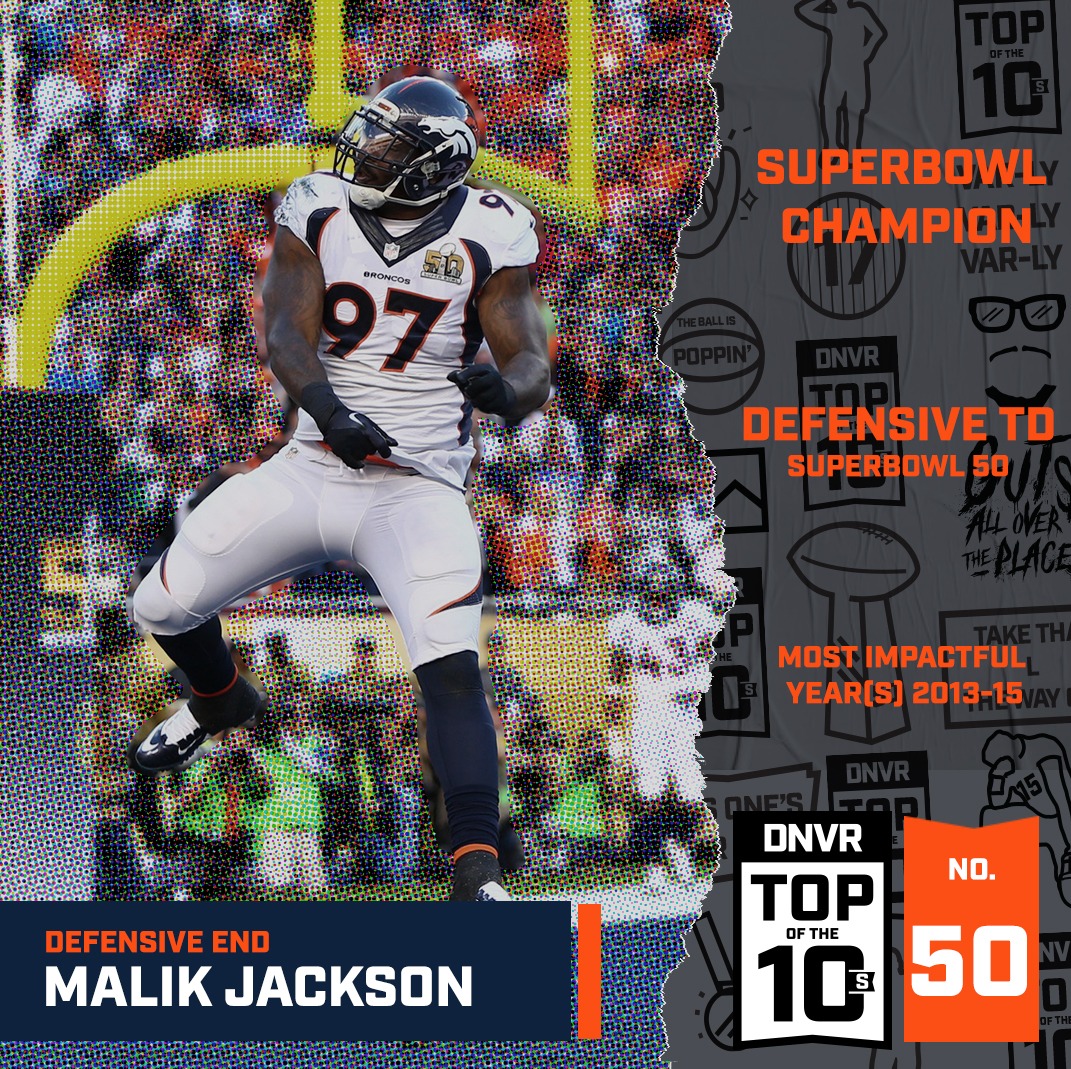
Andrew Mason: It took about a season and a half for Jackson to refine his game and blossom after the Broncos selected him in the fifth round of the 2012 NFL Draft. But once the University of Tennessee product hit his stride, he was virtually unblockable, providing a pass-rush punch from the interior that complemented Von Miller and DeMarcus Ware’s explosion from the edge. Jackson’s sack totals never approached those of Miller, but he racked up 48 quarterback hits in 53 total games — including playoffs — from 2013-15. He peaked in the Broncos’ 2015 playoff run hitting New England’s Tom Brady three times in the AFC Championship Game, then recovering a Cam Newton fumble forced by Miller for a touchdown in Super Bowl 50. Unfortunately for the Broncos’ hopes of keeping their title-winning defense together, Jackson and Derek Wolfe saw their initial contracts expire right after they lifted the Lombardi Trophy. Wolfe re-signed during the playoff run, leaving Jackson to test the market and sign a contract with the Jaguars that included $31.5 million of guaranteed money. Jackson continued his stellar work in Jacksonville, while the Broncos’ interior pass rush didn’t recapture its 2015 form until this season.
49. Jon Gray
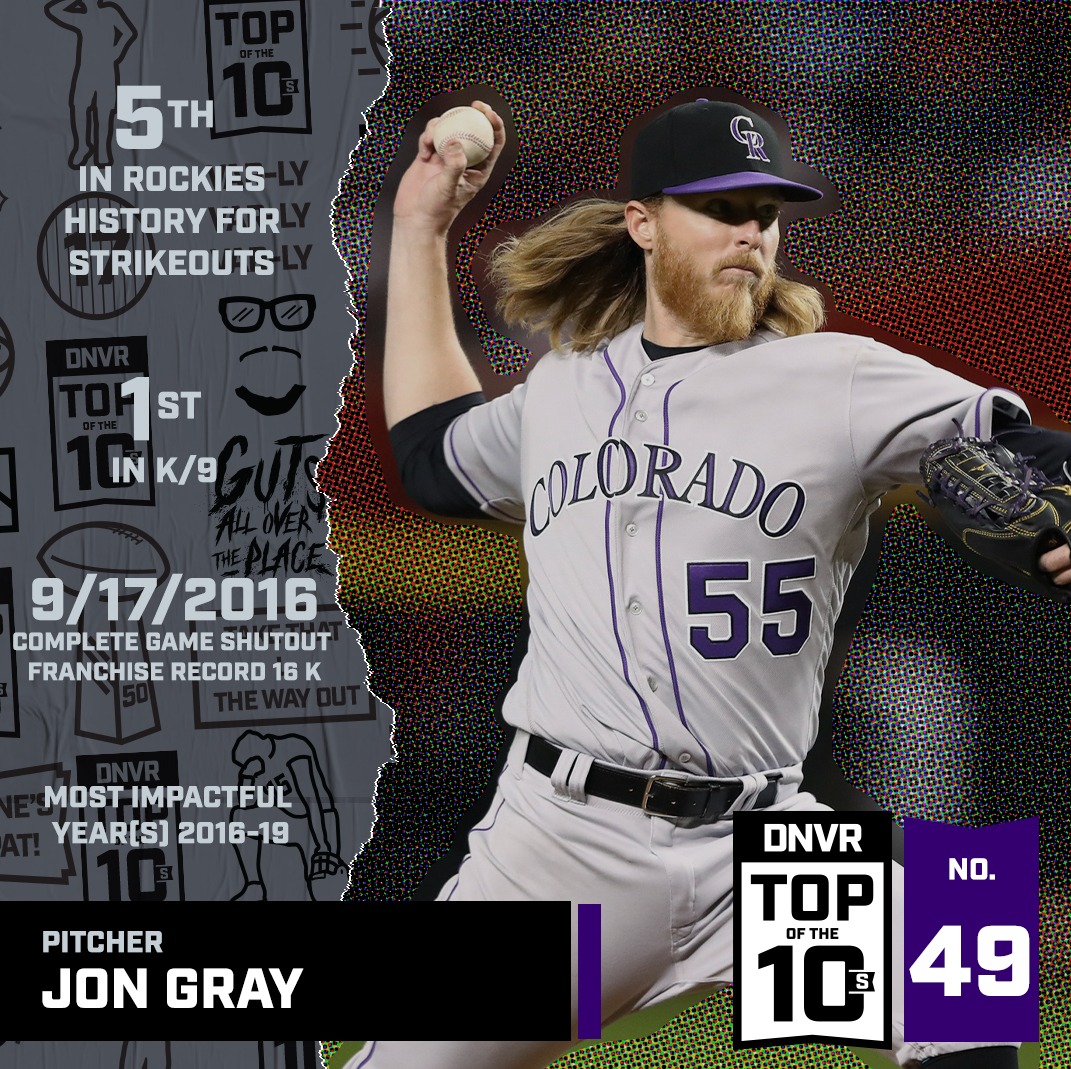
Drew Creasman: Jon Gray might’ve had the loftiest expectations ever foisted upon a Colorado pitcher ahead of his MLB debut. He hasn’t met those expectations quite yet but he spent the second half of the decade showing why so many believe he may still become one of the game’s best. Before reaching his 28th birthday, Gray moved into fifth place on the Rockies all-time strikeout leader board by boasting the best K/9 rate the franchise has ever seen. He has already accumulated enough bWAR to place seventh, ahead of names like Jason Jennings, Jeff Francis, and Pedro Astacio. He pitched one of the five best games in Colorado history on September 17, 2016 with a complete game shutout of the San Diego Padres at Coors Field, tallying a record-setting 16 punchouts. He has mastered Coors Field more than anyone in its history and could be a strong candidate to appear on next decade’s list should he remain with the Rox.
48. Jamal Murray
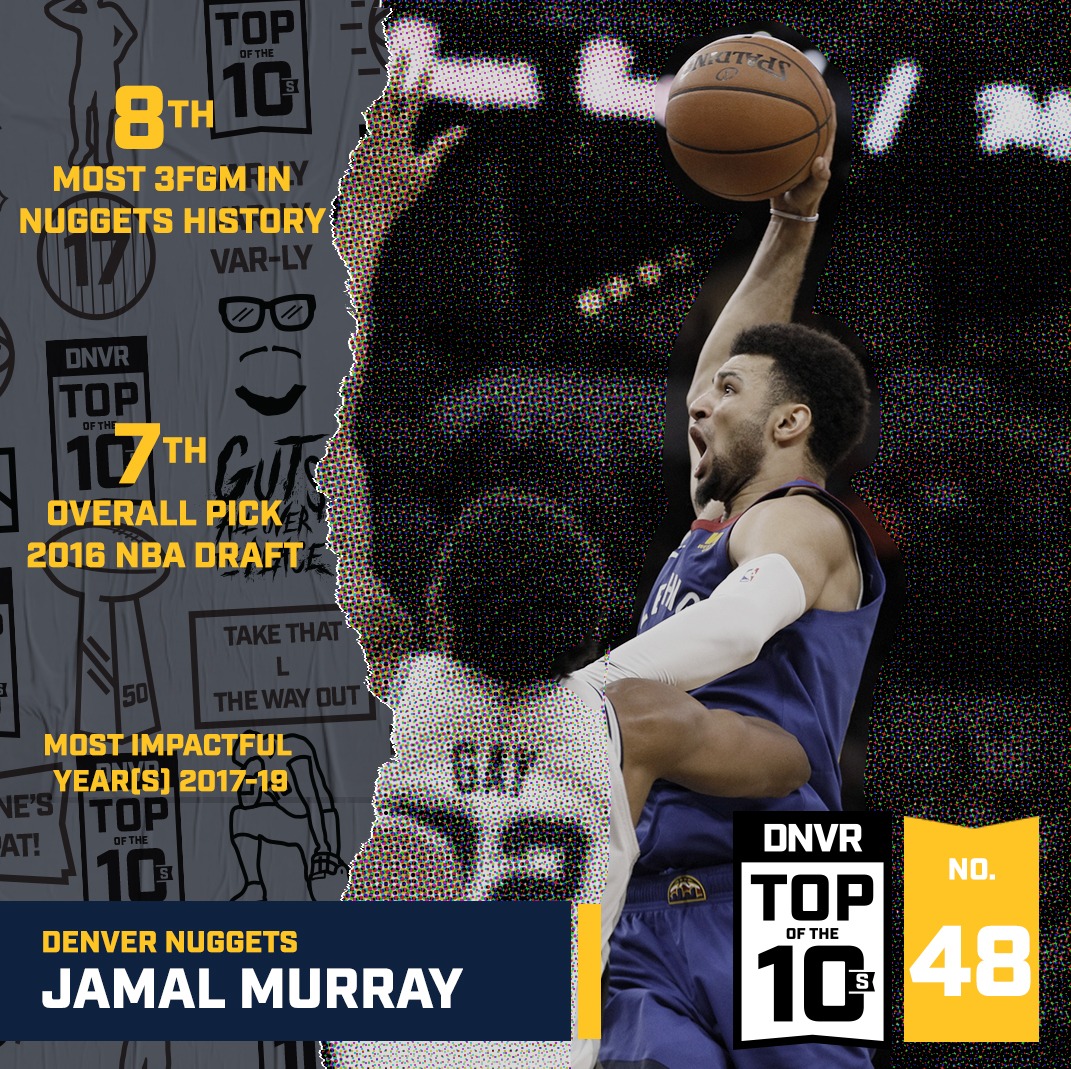
Brendan Vogt: Jamal Murray’s career is just getting started, but that hasn’t prevented him from making a meaningful contribution to the Nuggets and the city of Denver since being selected with the seventh overall pick of the 2016 NBA draft. In less than four years, Murray has evolved from a second-stringer with enormous potential to the starting point guard on a team with championship aspirations. The ‘Blue Arrow’ has already hit more three-pointers in team history than all but seven Nuggets, and he led the team to its first second-round appearance in a decade this past summer. Murray is still in the nascent stages of his career, but the Canadian has already done enough to earn a spot in our top-50.
47. Mikko Rantanen
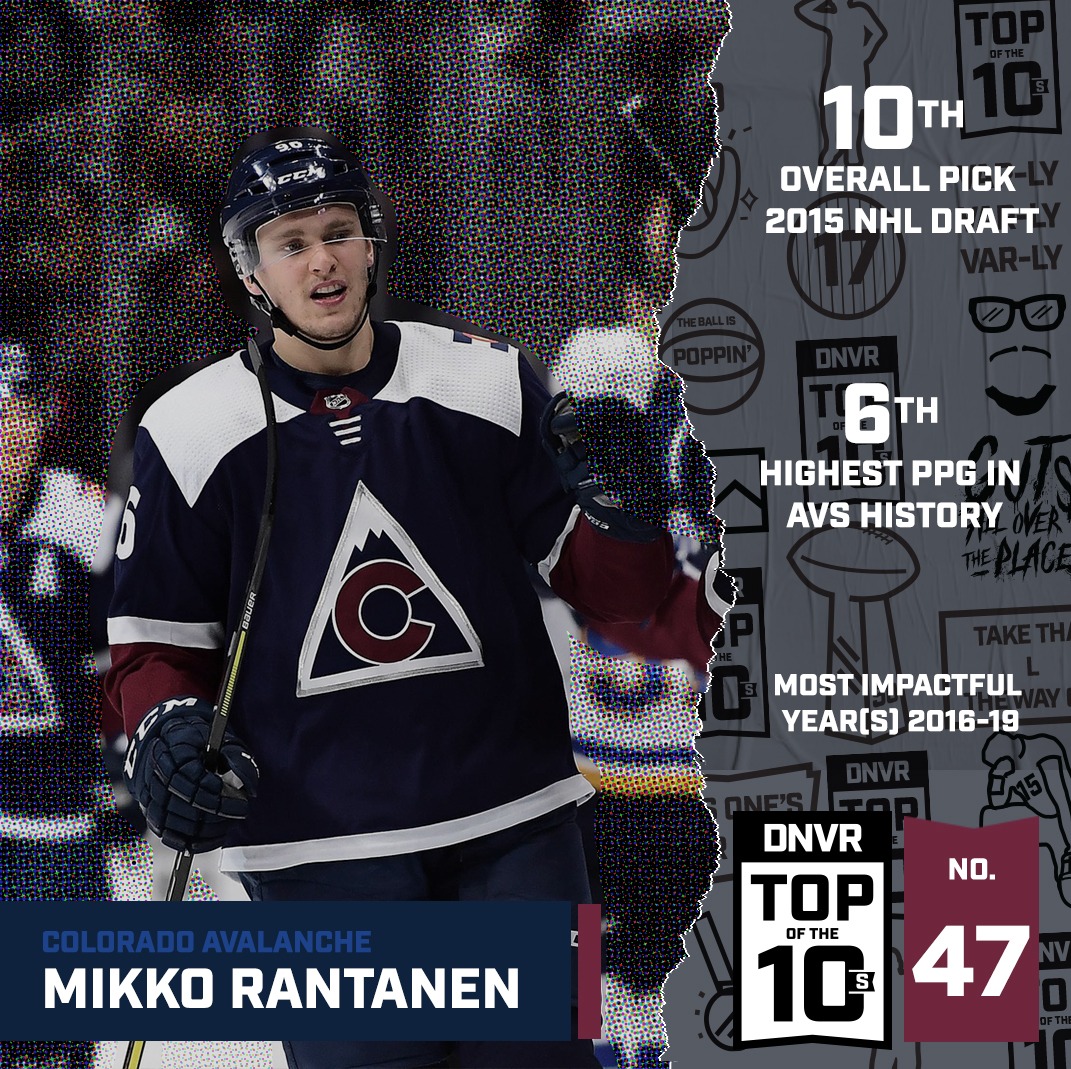
Evan Rawal: The Big Moose hasn’t been around for a long time, but since joining the Avs full-time in 2016, he’s steadily improved into one of the NHL’s elite playmaking forwards, and that’s something we could not ignore. Back-to-back seasons of 84 and 87 points give him the two most productive offensive seasons for the Avalanche this decade by someone not named Nathan MacKinnon. The Avs came within one game of heading to the Conference Finals in 2019, their best playoff run in over a decade, and Rantanen led the team in scoring during that run with 14 points in 12 games. He may not have had the longevity this decade, but how can you ignore that production? I have a feeling he’ll be a little bit higher when this list is done for the 2020’s.
46. T.J. Ward
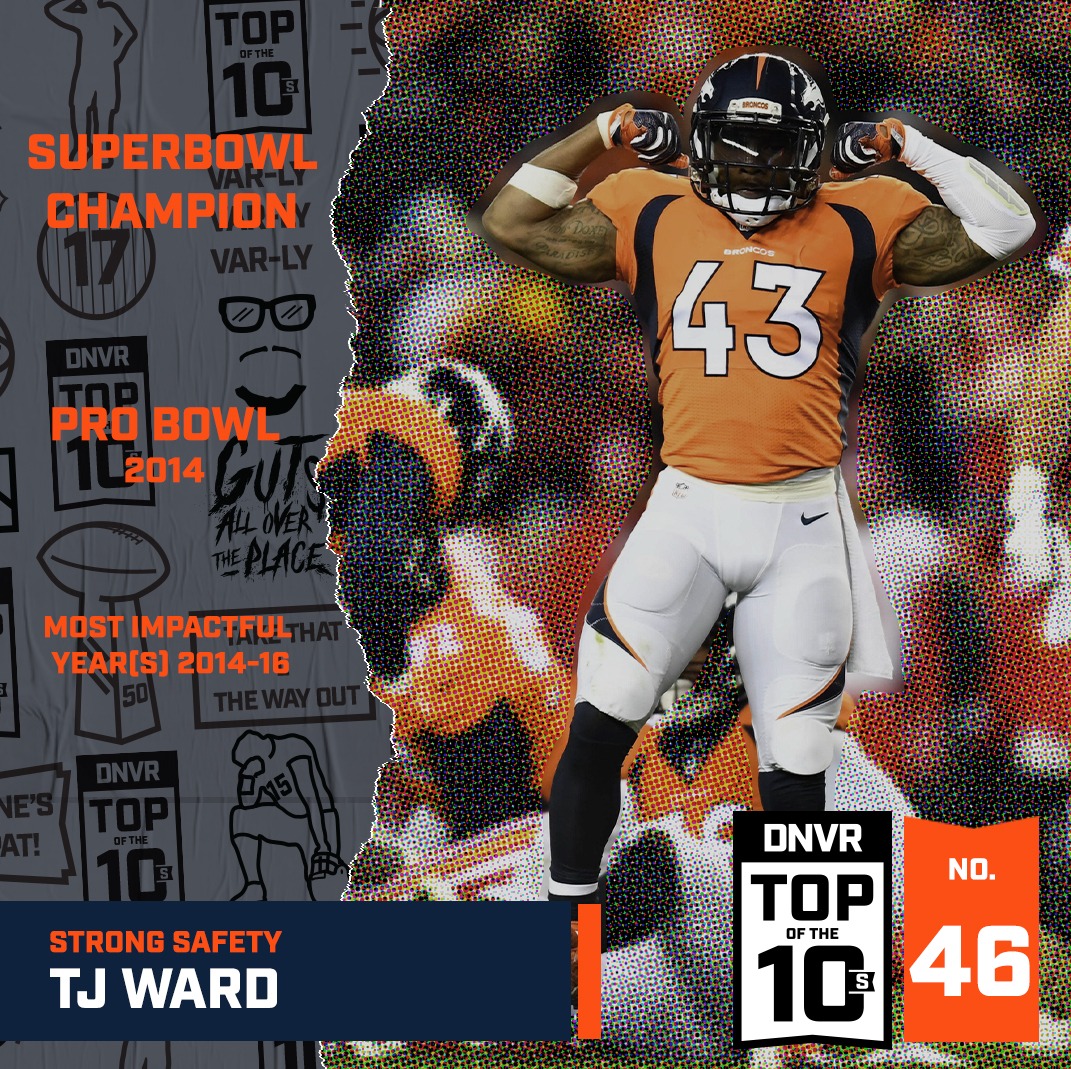
Andrew Mason: The Broncos’ stacked free-agent class of 2014 featured one likely Hall of Famer (DeMarcus Ware), another who will be in the Hall conversation (Aqib Talib) and a charismatic player who worked his way into the franchise’s all-time top 10 in receptions and receiving yards (Emmanuel Sanders). But Ward was actually the first free-agent domino to fall as the Broncos reshaped their defense in the wake of a Super Bowl XLVIII throttling at the talons of the Seahawks. Ward was a Swiss Army knife on the Broncos’ dominant D. He worked as a safety in their base package and as an in-the-box linebacker in their nickel alignment, and proved equally adept at both roles, serving as the thumper of the famed “No-Fly-Zone.” Chris Harris Jr. was the brain of the group. Talib was its heart. Darian Stewart was its conscience. But Ward was its soul, and when the Broncos released him at the final cutdown in 2017, an era ended.
45. Carmelo Anthony
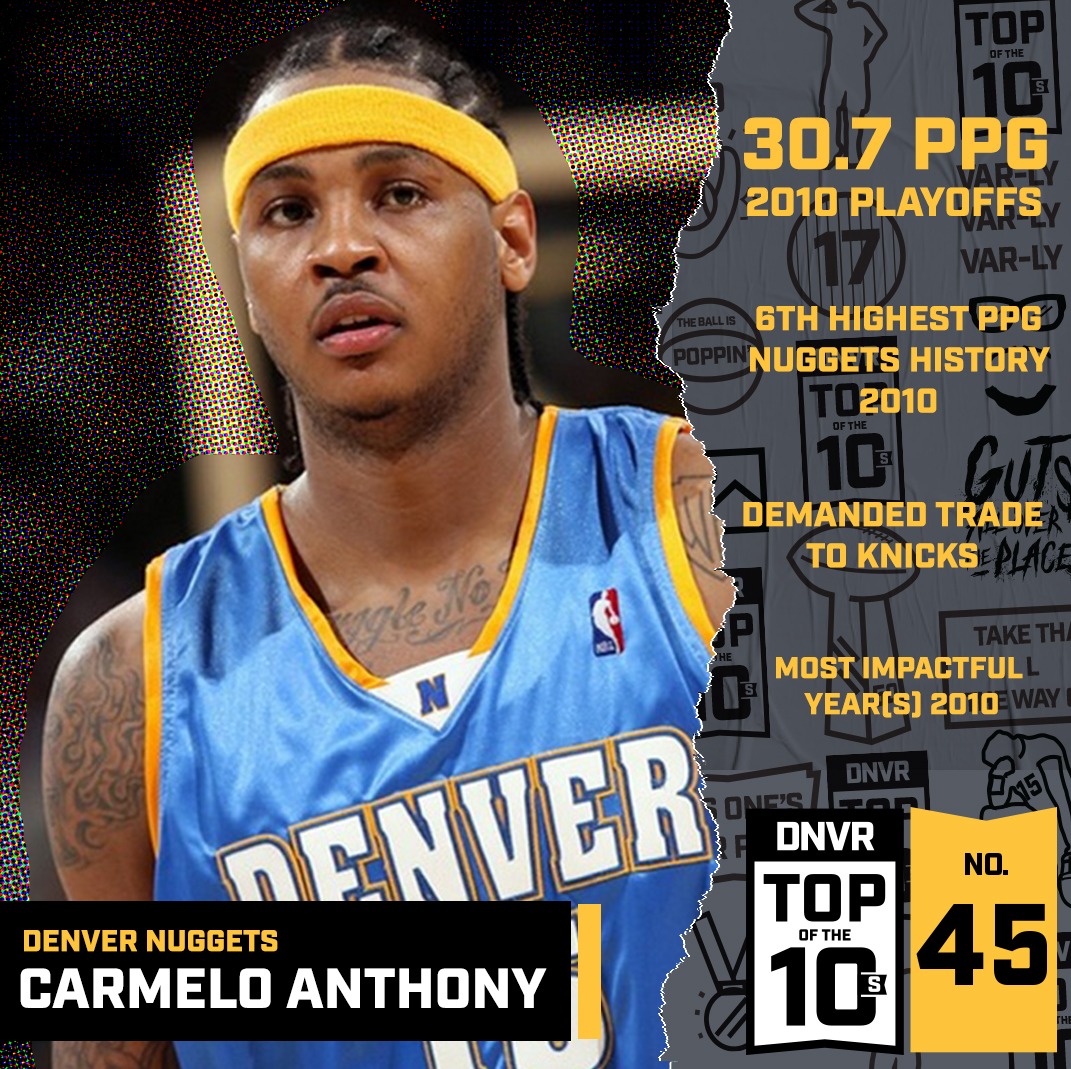
Adam Mares: Melo only played 93 games for the Denver Nuggets in the 2010’s but he still had a few memorable moments. His 42 points in game one of the first round of the 2010 NBA playoffs was both a career-high and tied a franchise playoff high that stood until last April when Nikola Jokic scored 43 against the San Antonio Spurs. He is also the only Nuggets player to score at least 50 points in a game this decade. But Melo’s impact on the Denver sports scene since 2010 has been defined by his trade demand and the impact that trade had on the franchise over the next nine years. In that way, he serves as more of a prologue to the 2010s than as his own chapter.
44. Patrick Roy
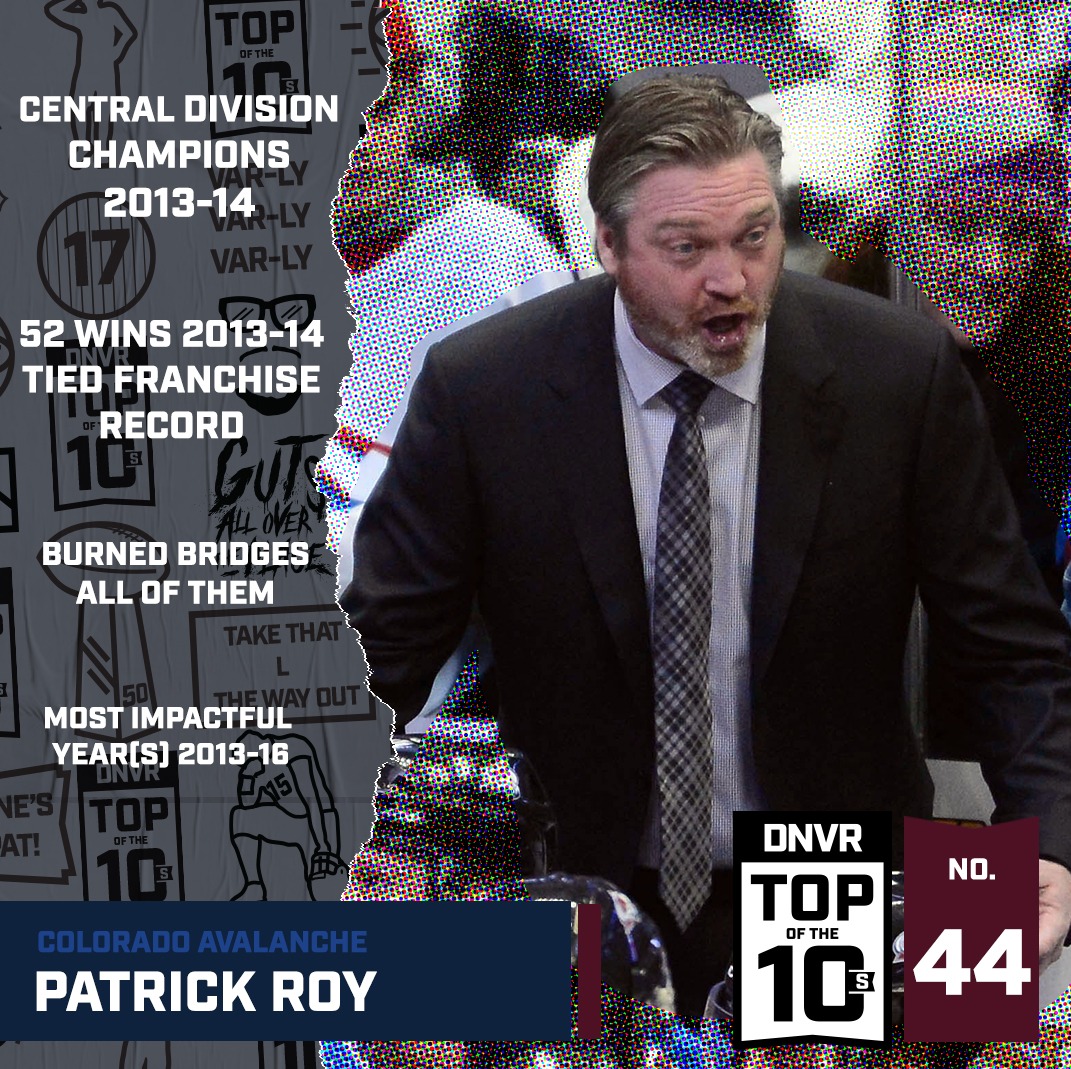
AJ Haefele: There was simply no way to tell the story of the Avalanche this last decade without Patrick Roy. His arrival was significantly hyped and in a blowout win on opening night, he literally tried to tear the building down to get at the opposing coach. Patrick Roy and Joe Sakic were back leading the Avs and they won 52 games and the only division title of the decade in the first year of their grand experiment. As Roy’s legendary competitive nature nudged Sakic and the organization into investing in win-now ventures with older players, the team slowly decayed through Roy’s three years. After not getting his way in the summer of 2016, Roy stuck to his forever-proud guns and walked out on the Avalanche, setting them up for a nightmarish season that ultimately ended with the franchise landing Cale Makar. It started hot, it cooled in the middle, and it ended with a press release to French media as Roy didn’t even bother to let the Avs know ahead of time. For the first time in his life, Roy’s walking away appears to have allowed the place he left behind to actually get better in his absence. We’ll always have opening night in 2013.
43. Dick Monfort
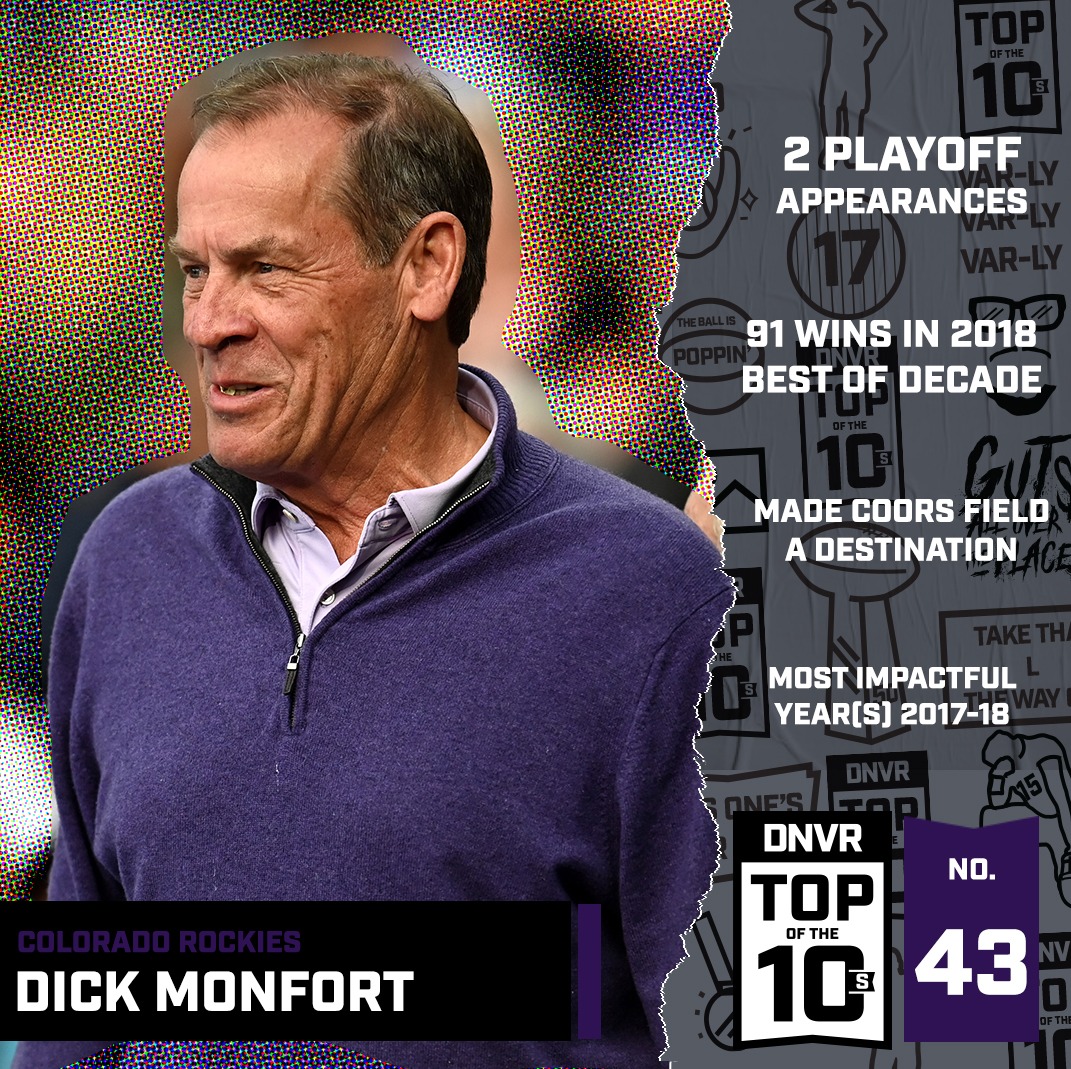
Drew Creasman: There is plenty to critique when it comes to Dick Monfort. The Rockies haven’t exactly been shining examples of on-field success during his tenure. But when he is graded on a curve, one must recognizes a larger context showing plenty of MLB teams who have been far less competitive in the decade as most of the spoils go to a small handful of clubs. Through the struggles, Monfort has maintained a nearly unmatched, phenomenal ballpark experience, managed to retain and extend guys who are both star players and fan favorites (Nolan Arenado, Charlie Blackmon) and has arguably done more for the local community, especially LoDo, than any owner in town. There’s also something to be said in a sport swimming in scandal right now that Monfort has largely avoided it and got the one big moral question that came across his desk, the decision to pay Jose Reyes to go away, absolutely right.
42. Danilo Gallinari
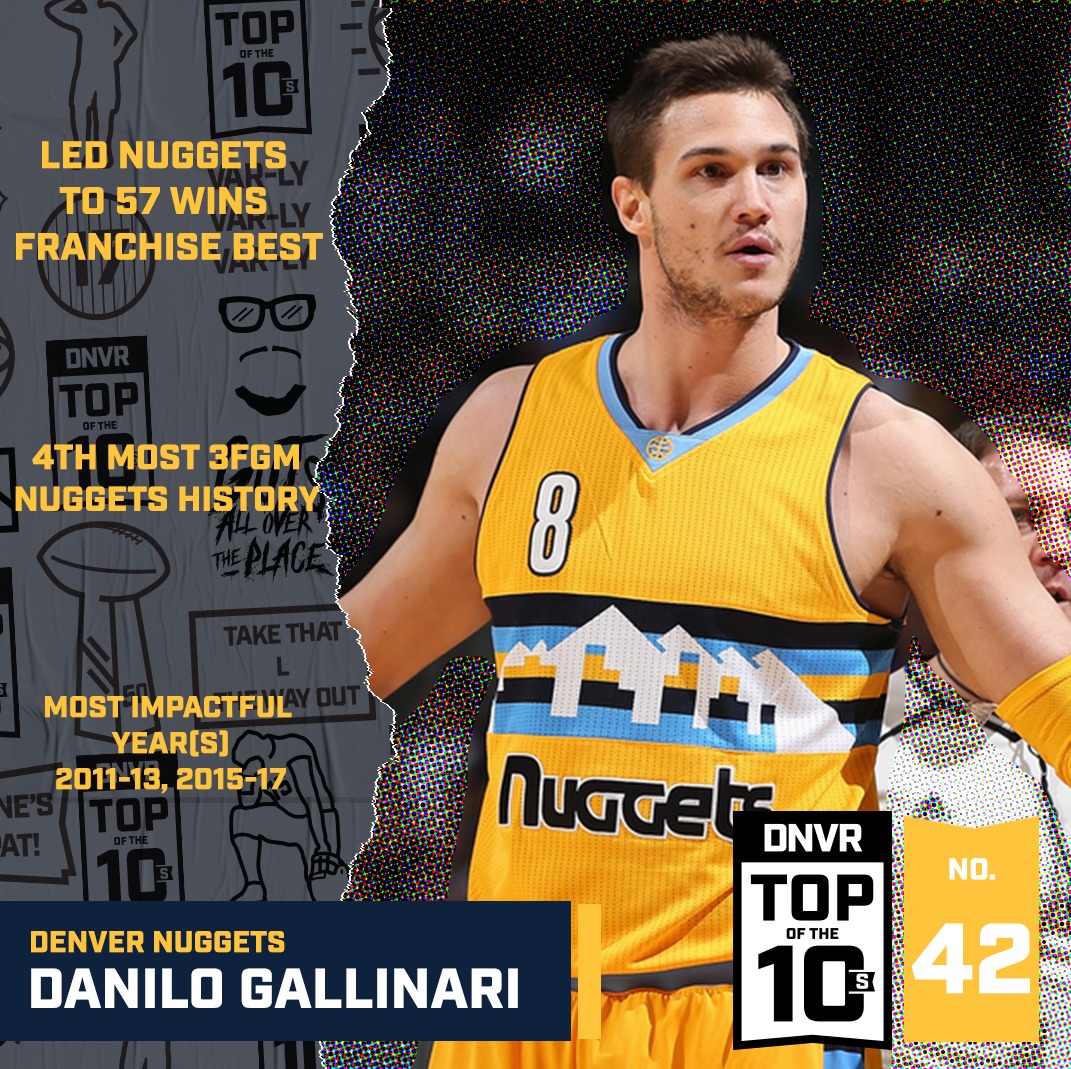
Harrison Wind: Danilo Gallinari arrived in Denver at the start of the decade as the prized trade chip acquired in the 2011 blockbuster deal that sent Carmelo Anthony to the Knicks. He departed the Nuggets’ organization near the end of the decade in 2017 just as Nikola Jokic was asserting himself as the franchise’s cornerstone. In between, Gallinari served as a bridge from the Melo era to the current iteration of the Denver Nuggets behind Jokic and Murray . The Nuggets made the playoffs in Gallinari’s first three seasons with the organization, finishing fifth, sixth, and third respectively in those three years (the Nuggets would have had a good shot at making the playoffs in 2013-14 — Brian Shaw’s first season with the team — but Gallinari missed the entire year due to an ACL injury.) Gallinari wound up spending parts of seven seasons in Denver and will be remembered as a featured player on the 2012-13 Nuggets team which won 57 games and went 38-3 at home. He’s a symbol of the fast-paced offensive-first teams of the George Karl era, and also should be looked back on as a potent scorer on the wing, a mismatch nightmare, and a generational shooter who never quite reached his ceiling due to the injuries that scarred much of his time in Denver. Gallinari embraced being a Denver Nugget and still has a home in the city today.
41. Jorge De La Rosa
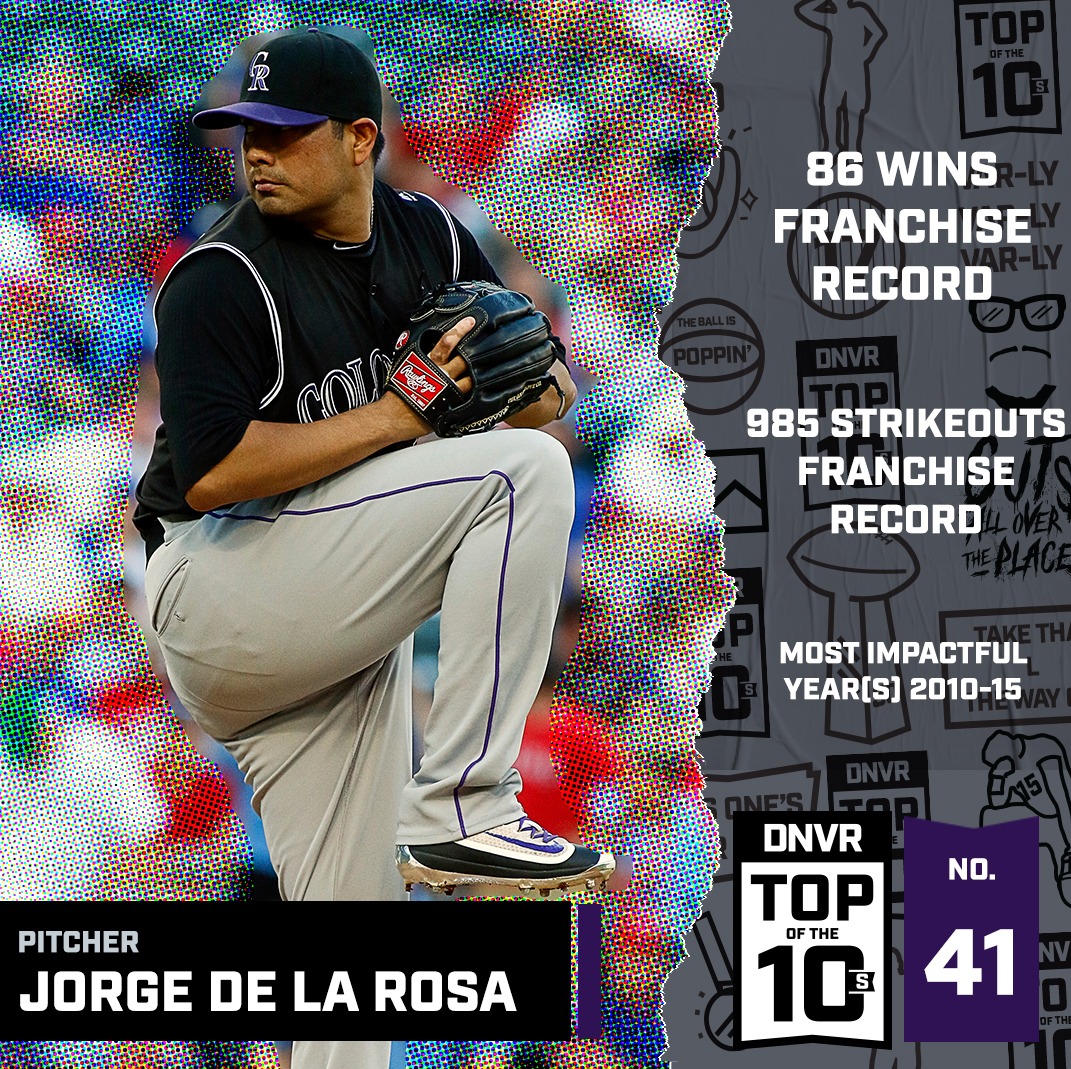
Drew Creasman: One of the most underrated athletes in Denver history, Jorge De La Rosa has as strong a claim to being the best pitcher in Rockies history as anyone. He never put up the huge splashy numbers but he was consistently solid pitching in a Rockies uniform which is not really a thing that happens. He stands to this day as the only example of a starting pitcher coming from outside Colorado and excelling. If you happen to attend a game at 20th and Blake during his time here, you had a 72 percent chance of seeing him notch a victory. His 53-20 record at Coors Field may never be topped. The winningest pitcher in franchise history, De La also holds the franchise strikeout crown with 212 more than second place. He unfortunately left the team before they would make the postseason but will always be loved in Denver for defying all the odds and becoming one of our own.
40. Paul Millsap
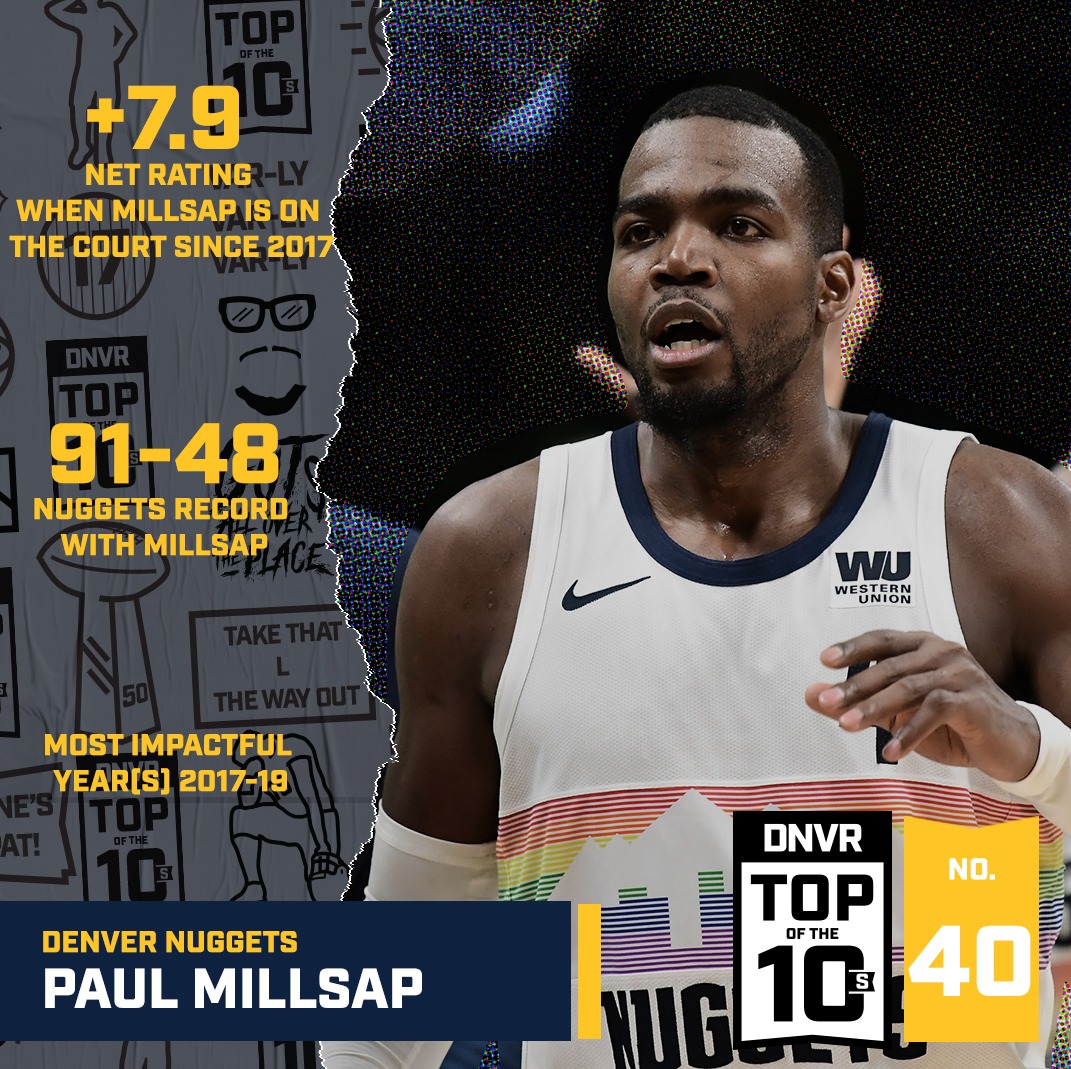
Brednan Vogt: Paul Millsap is among the most, if not the most impactful player the Denver Nuggets have ever acquired through free agency. The four-time All-Star arrived intending to turn the much-maligned Nuggets’ defense into an elite one, and Denver’s subsequent transformation on that end is not possible without him. He was the perfect addition to this Nuggets team and Nikola Jokić in the frontcourt. The Nuggets have posted a +7.9 net rating with Millsap on the court since 2017, and are 91-48 when he plays in a Nuggets uniform. It is inconceivable that Denver wins 54 games in the Western Conference and advances to the second round for the first time in 10 years should they fail to reach that team-friendly deal in July of 2017. Millsap has been among Denver’s best players to start this new campaign and is an anchor of the top-ranked defense in the league.
39. Derek Wolfe
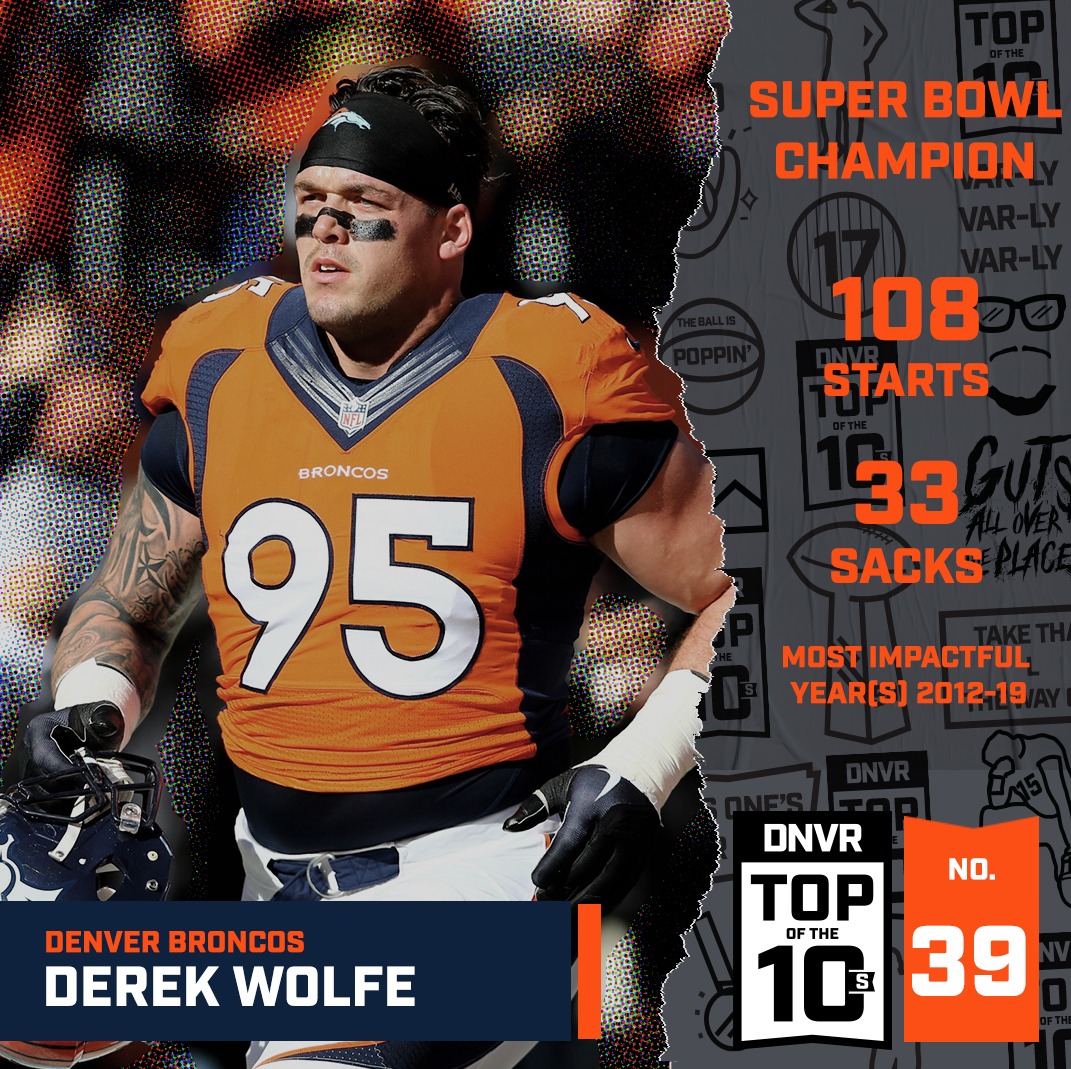
Andrew Mason: With 33 sacks in eight seasons as a Bronco, Wolfe was the team’s steadiest presence on the defensive line throughout the decade. But it’s his ability to overcome injuries and play through pain that has defined him. At various points in his career, Wolfe has dealt with a bruised spinal cord, a seizure, multiple other neck injuries, a hairline fracture in his elbow, a sprained ankle and, most recently, a dislocated left elbow that came after the best stretch of his career, when he had seven sacks in just six games. Despite the injuries, he’s started 108 games in his career, more than all but one Broncos defensive lineman in the last quarter-century.
38. Ryan Clady
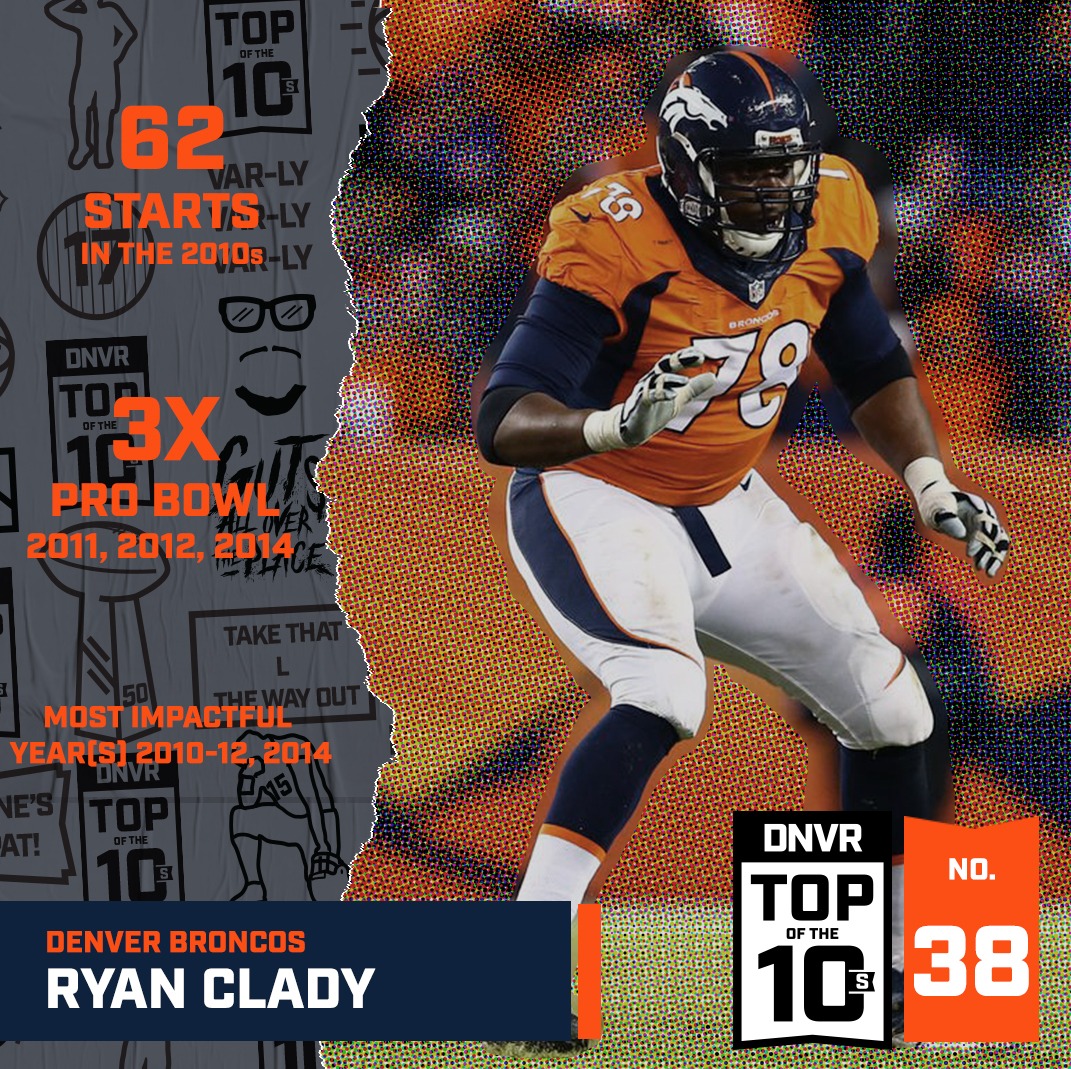
Zac Stevens: Denver’s 2008 first-round pick lived up to his premier draft spot and then some his first seven years in the league. Outside of missing 14 games in 2013 due to a Lisfranc injury, Clady started and held down the left side of Denver’s offensive line in every single game from 2008 to 2014. In that time, Clady joined rarefied air, earning four trips to the Pro Bowl, two First-team All-Pro’ honors and a Second-team All-Pro. Unfortunately, a torn ACL in the 2015 offseason ended Clady’s playing career with Denver. Think about this, if it weren’t for the dang injuries, the 33-year old could very well still be Denver’s premier franchise left tackle they’ve been looking for since he left Denver and subsequently retired.
37. Jared Bednar
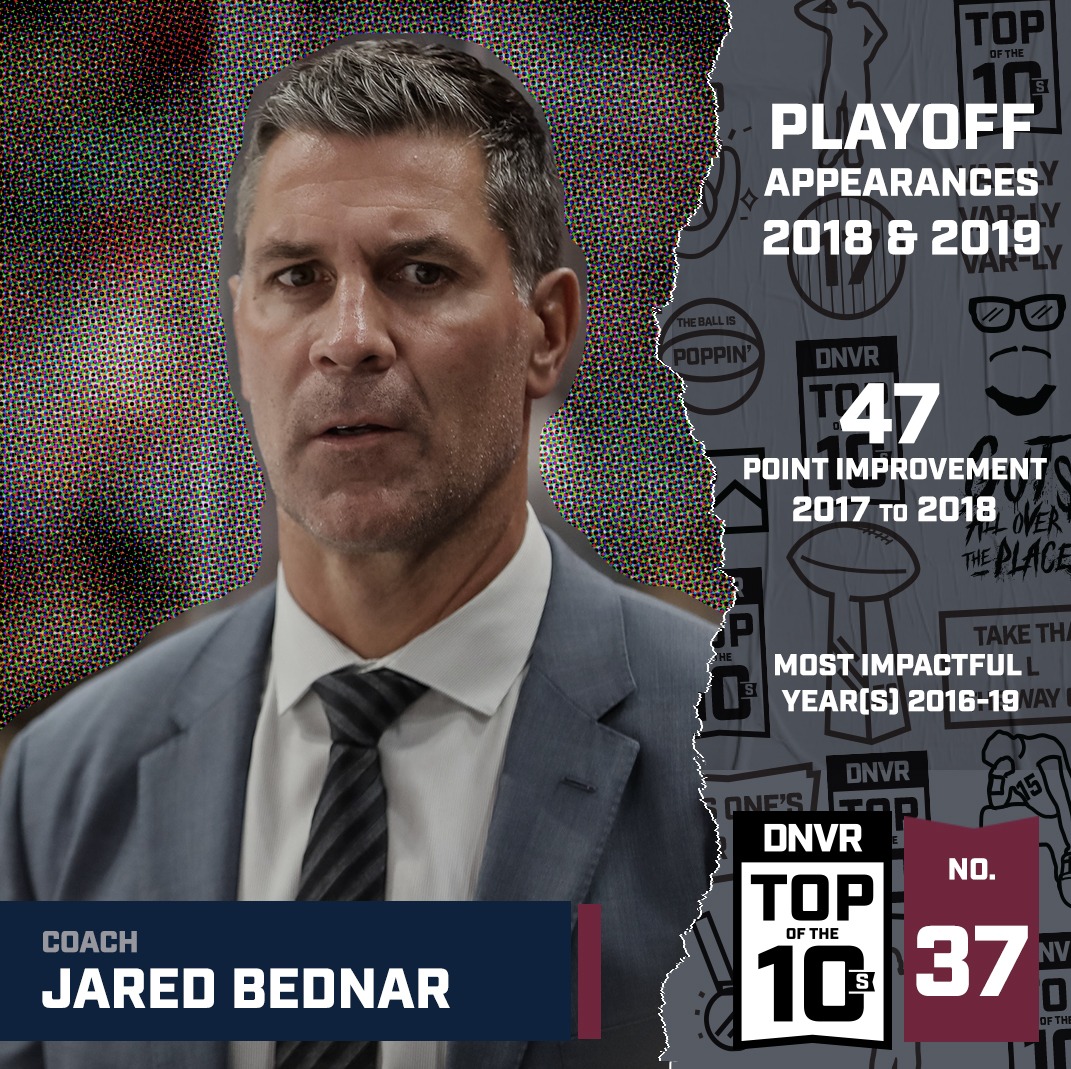
Nathan Rudolph: Patrick Roy’s abrupt departure in the summer of 2016 left the Avs with a coaching hole to fill. Enter Jared Bednar. Coming off an AHL championship, he was a coach with a lot of promise but a new face to the NHL game. His first season at the helm was an unmitigated disaster. While a multitude of factors beyond Bednar’s control played into this, his name will always be tied to one of the worst seasons ever in the modern NHL. Despite this the Avs remained faithful in their new coach and it paid off. Bednar would respond with a massive turn around season, posting a 47 point improvement and bringing the Avs back to the playoffs for the first time in four years. Superstars like Nathan MacKinnon and Mikko Rantanen have blossomed under him and in 2018-19 he would become the only Avs coach this decade to guide the team to the playoffs in consecutive years and would mark the only time making it beyond the first round.
36. Erik Johnson
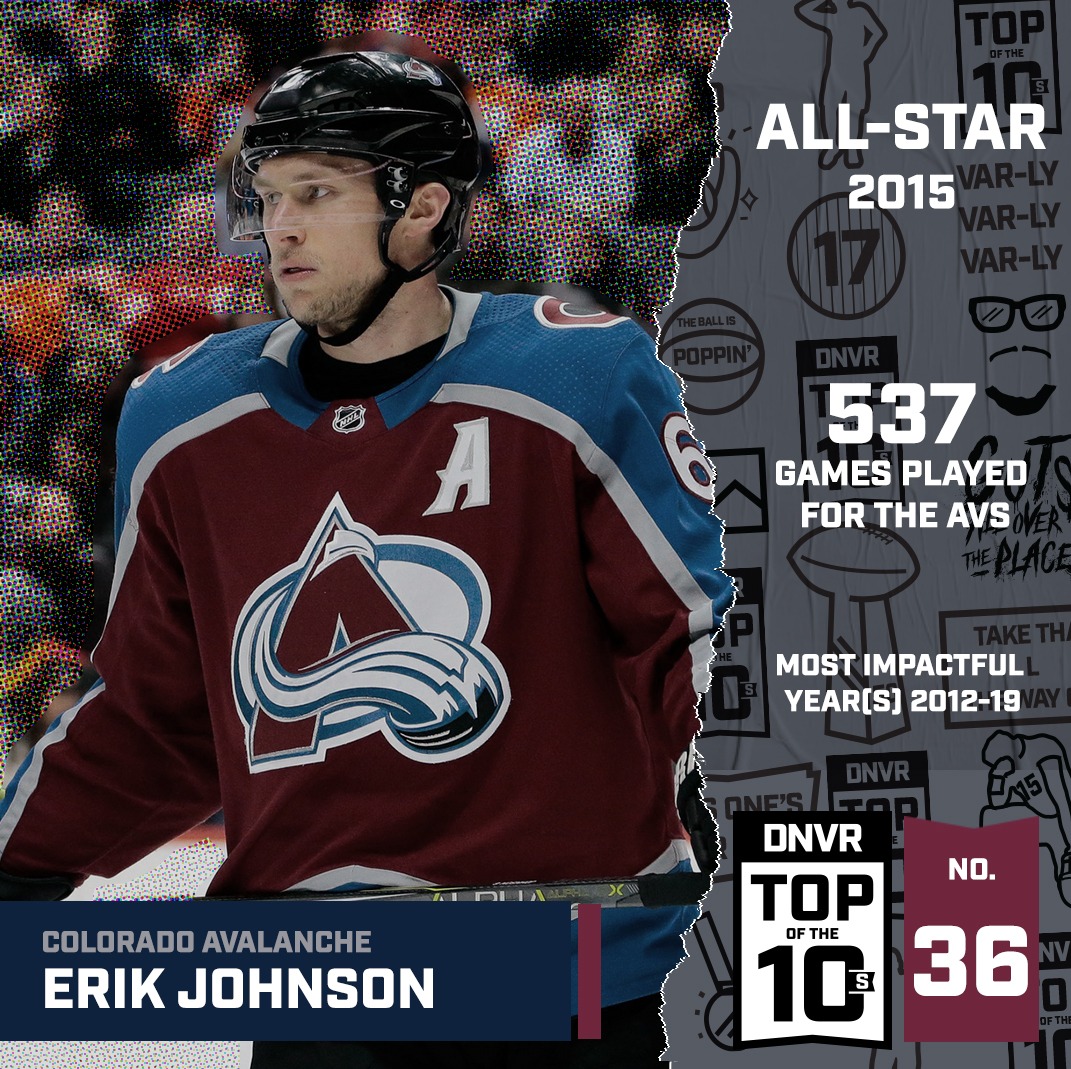
Evan Rawal: When the Avs acquired Erik Johnson in the middle of the night in 2011, they did so looking for that all around #1 defenseman the franchise had lacked since Rob Blake left in 2006. While Johnson never became that franchise changing defenseman, he was a key cog when the Avs won the division in 2014, putting up a career high 39 points in 80 games and playing in all situations. The following season, he was on pace for over 20 goals and was selected to his first NHL All Star team before an injury ended his season, and didn’t allow him to play in the game. In 2017-18, he averaged over 25 minutes a night as the backbone of the Avs defense while the young players were still finding their way. For years, the Avs blueline was held together by Johnson and Tyson Barrie, as the organization struggled to find those two the help they needed. These days, he is Gabriel Landeskog’s right hand man in the leadership group, as they help mentor the next generation of Avs players looking to bring the Stanley Cup back to Colorado, and he still logs important minutes on the Avs backend. Johnson has remained committed to the Avalanche organization since they acquired him, paying them back for the faith they showed in him as an up and coming player.
35. Emmanuel Sanders
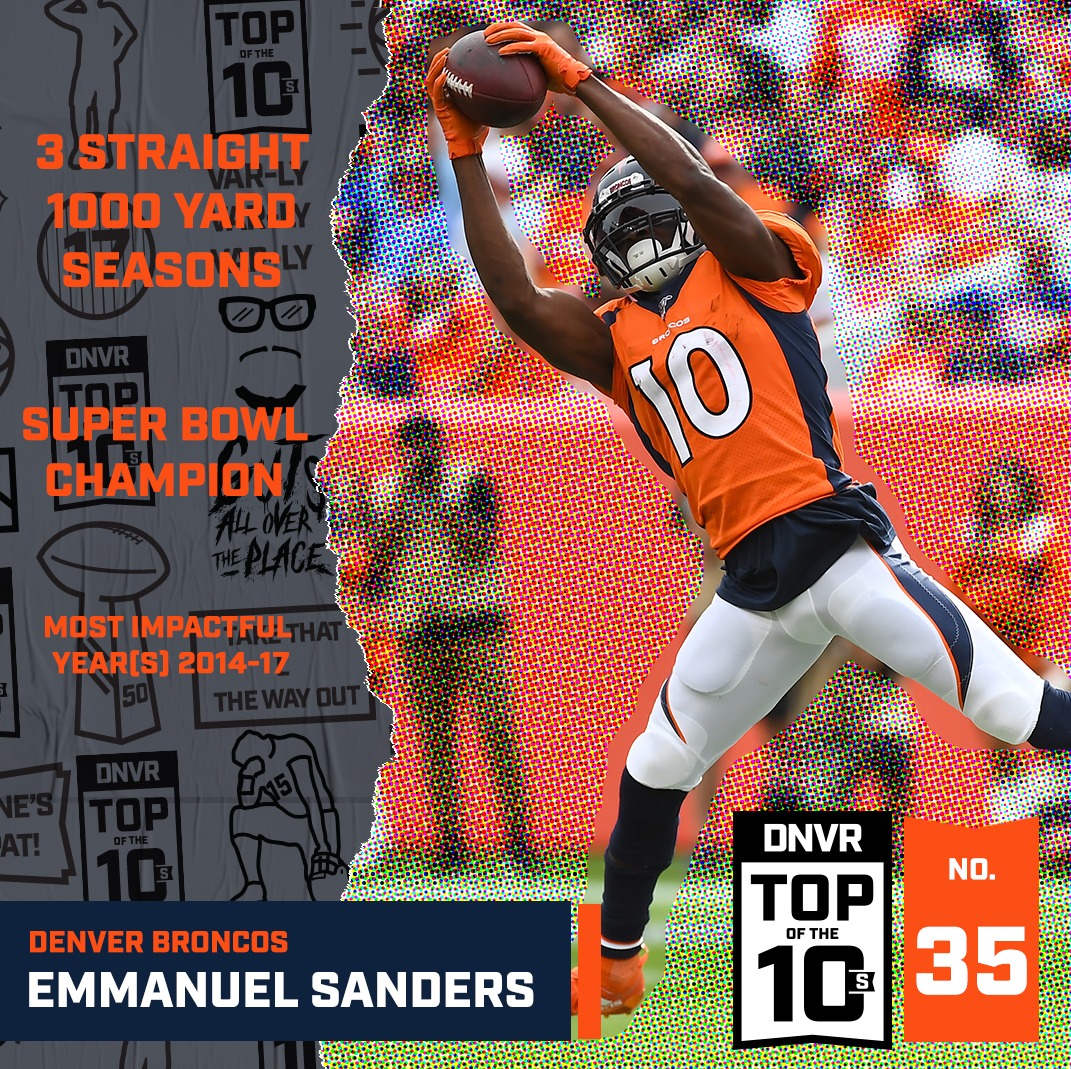
Andrew Mason: When the Broncos signed Sanders in March 2014, questions arose as to whether the erstwhile No. 3 receiver with Pittsburgh could match the production of Eric Decker, who had just signed a deal with the Jets that included $15 million in guaranteed money. Sanders hadn’t even posted a single 100-yard game in four seasons with the Steelers. But he answered all questions within his first month as a Bronco, posting 100-yard games in three of his first four starts in orange and blue. By the end of his 101-catch, 1,401-yard season, Broncos fans asked, “Eric who?” Although Sanders’ production slipped after Peyton Manning’s retirement, he still worked his way into the franchise’s top 10 in receptions and receiving yardage. But he struggled to accept the Broncos’ post-Peyton reality of questionable quarterbacking and tepid offense, and his vocal discontent led to a midseason 2019 trade to the 49ers.
34. Tyson Barrie
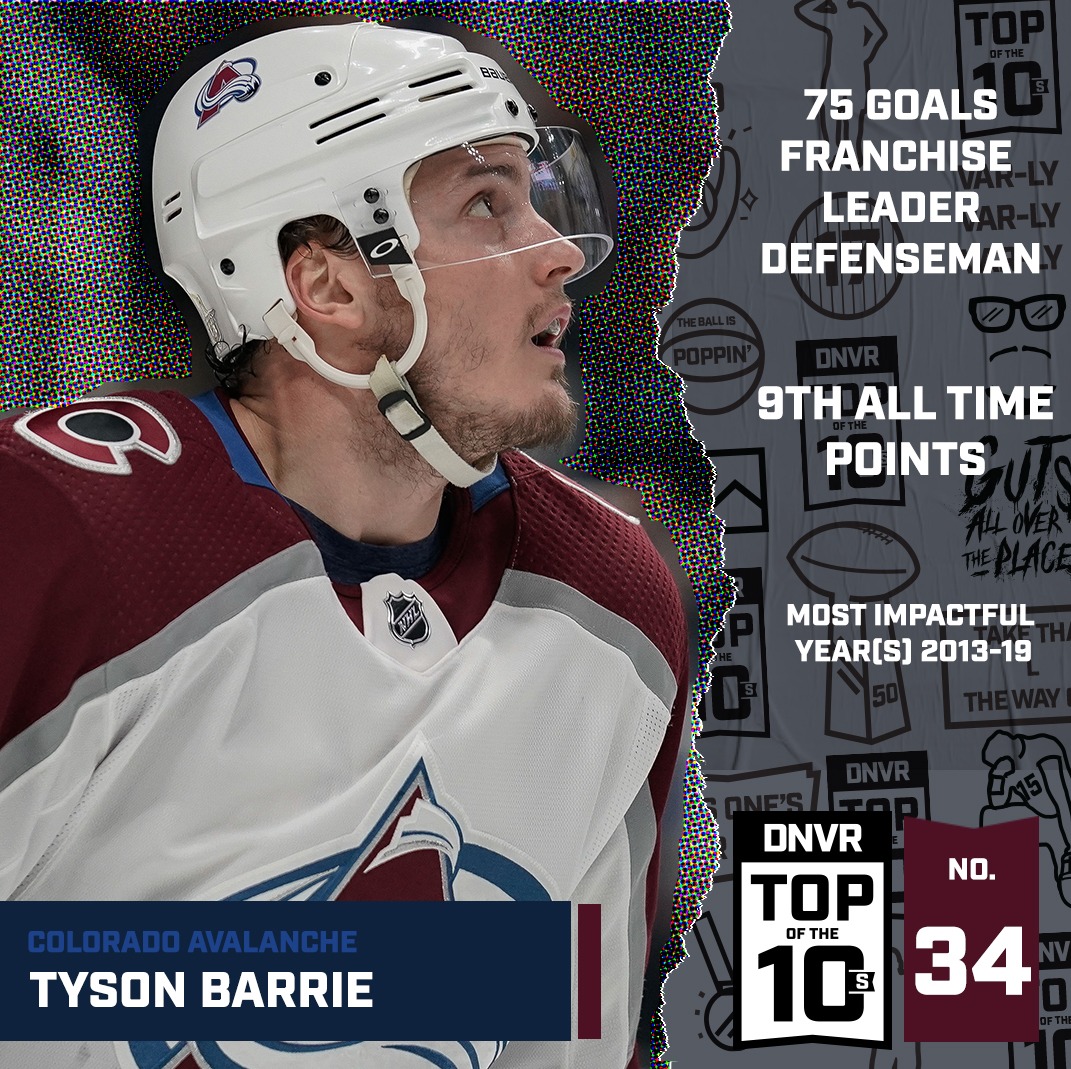
AJ Haefele: Barrie was the Little Engine That Could for the Avalanche. He was the only player all decade not drafted in the first round they managed to develop into an NHL regular. In doing so, Barrie became the franchise’s leading scorer among defensemen and left the franchise over the summer as a record holder in many categories. He burst onto the scene when Patrick Roy arrived and stuck around long enough to be a driving factor in the Avs making the postseason each of the last two years. As good an offensive defenseman as he was on the ice, Barrie’s time in Denver will be equally remembered for being an excellent person away from the rink. A smiling assassin on the ice, Barrie carried over his happy-go-lucky ways with him to the locker room and beyond and will go down as one of the more memorable personalities in Avalanche history. He was a lovable tryhard who helped usher back in an era where the Avs were once again relevant.
33. George Karl
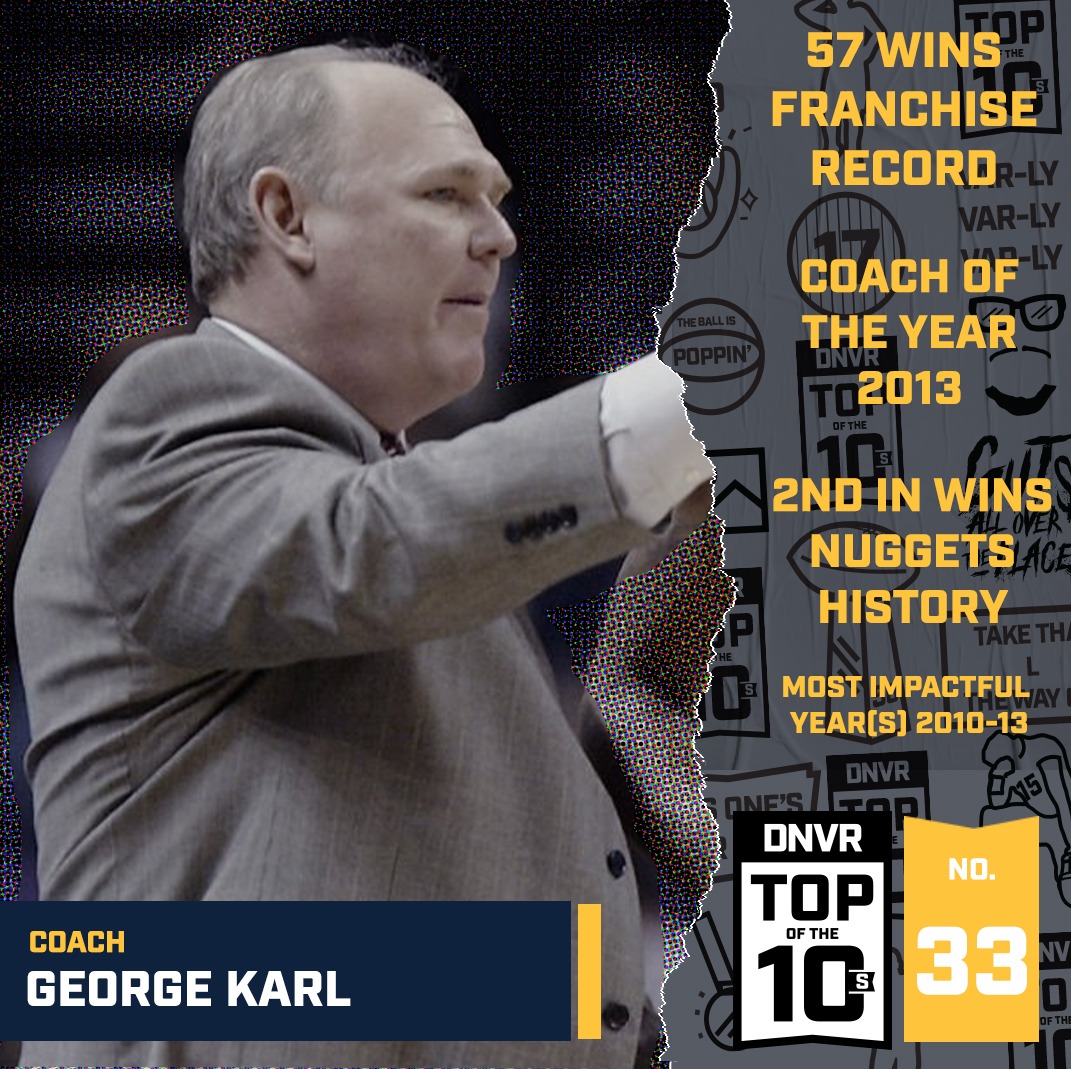
Adam Mares: Coach Karl probably has a resume worthy of a much higher ranking. In the 2010’s he led the Nuggets to a franchise-record 57 wins, became the 2nd winningest coach in Nuggets history, and won the NBA’s coach of the year award. He managed the transition from the Carmelo Anthony era to the Danilo Gallinari era without skipping a beat. And perhaps most important of all, his brand of fast-paced, free-wheelin’ basketball fit nicely into the mold created by Doug Moe three decades earlier. But his unceremonious firing and departure was a symbolic one for the Nuggets. Eight times his teams made the playoffs in Denver. Seven times they were bounced in the first round, including all four of his post-season appearances in the 2010s. Fair or not, Karl’s legacy in the 2010’s was that of a coach who could produce regular season success but never came close to building a true title contender.
32. Champ Bailey
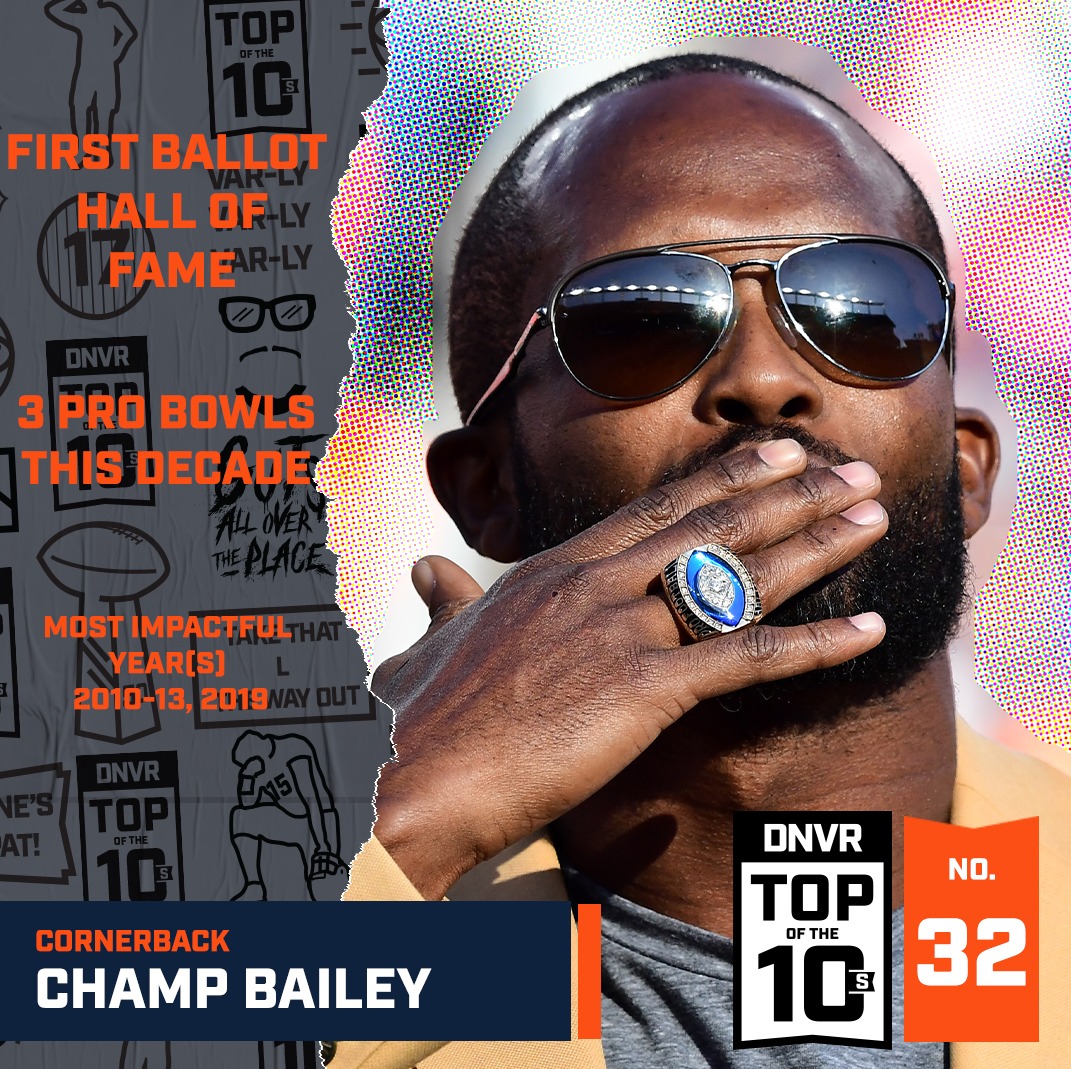
Andrew Mason: The apex of his career came in the mid-2000s, when a ball thrown in his direction was as likely to be intercepted as it was to be caught by the opposing wide receiver. But even in his twilight years, the eventual first-ballot Hall of Famer was still capable of shutting down No. 1 wide receivers, earning three Pro Bowl selections this decade before age and injuries caught up with him in 2013, leading to his retirement a year later. Bailey’s biggest contribution to the Broncos might have come when he signed a piece of paper: a new contract to which he agreed in February 2011. He had been poised to hit free agency, and with the Broncos coming off five consecutive seasons without a playoff appearance, no one would have blamed him for leaving. The re-signing of Bailey was the first big strike of John Elway’s stint as general manager, and when he drafted Von Miller two months later, the Broncos’ rapid reconstruction was under way. The Broncos couldn’t get over the hump in Super Bowl XLVIII to give Bailey the final piece of his career puzzle, but his legacy as the finest cornerback in Broncos history is secure.
31. Jeff Bridich
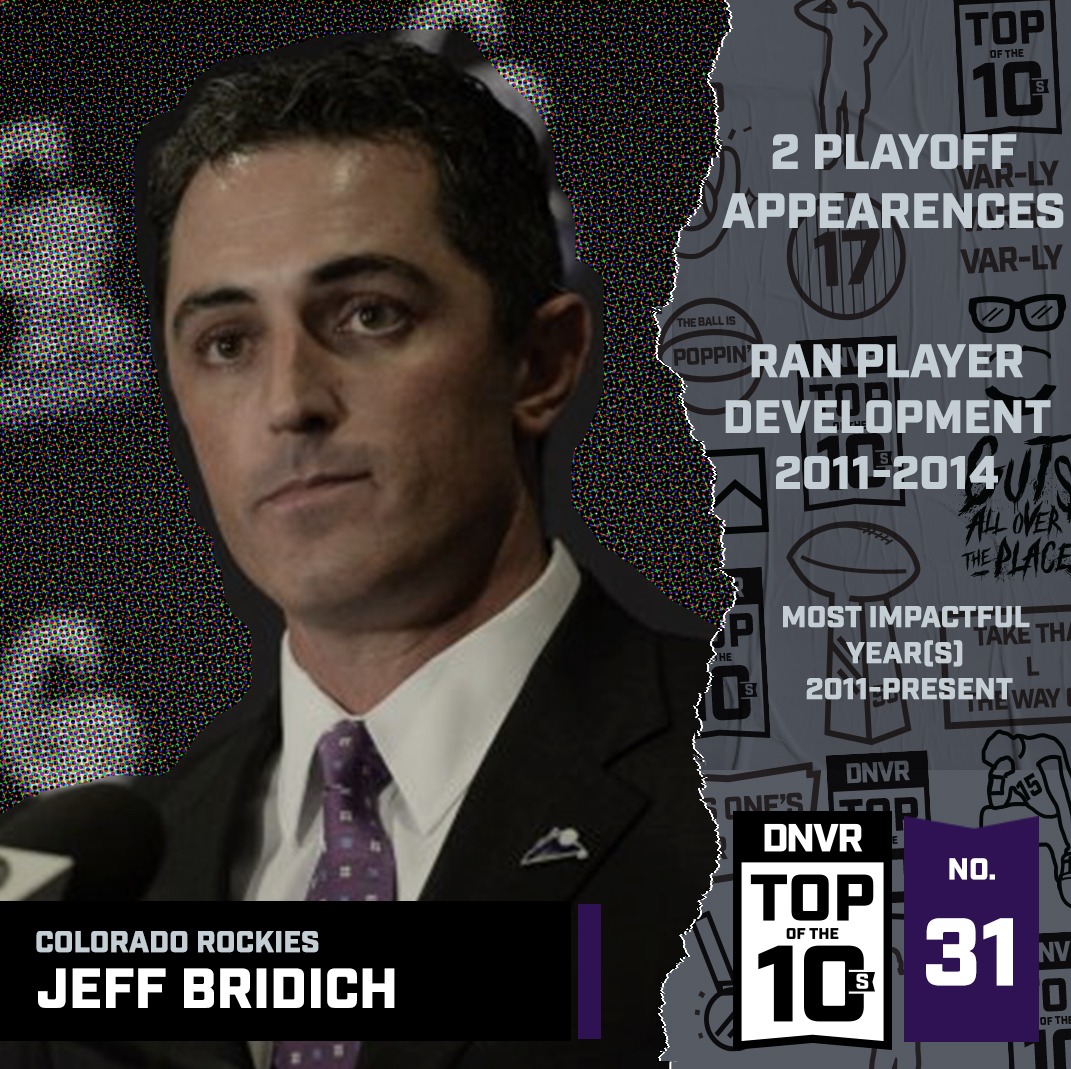
Drew Creasman: Let’s start by getting over the recency bias. Yes, Jeff Bridich is currently in hot water with much of Rockies fandom thanks to some controversial comments and 2019 turning into one of the most disappointing seasons in franchise history. But just eight months ago, he was riding an extremely positive wave of momentum. He took over as the organization’s director of player development in 2011 and a farm system that had been seen as a joke suddenly started to churn out superstars. He helped convert Nolan Arenado, Trevor Story, and Charlie Blackmon from non-first-round-draft-picks into perennial All-Stars and even potential Hall-of-Famers. He took over as the GM after 2014 and almost immediately made the bold move of trading face-of-the-franchise, Troy Tulowitzki, beginning a new era in Colorado baseball.
The club improved significantly on their record every year thereafter, eventually making the postseason in back-to-back campaigns before the first step back of his tenure this past season. His misses are infamous and there have been more than a few but his hits have given the Rockies their highest level of talent ever. A lot of the frustration over Bridich is that he may not be able to capitalize on all this potential in this window of contention. But he deserves as much credit as anyone for creating that potential and opening that window in the first place.
30. Phillip Lindsay
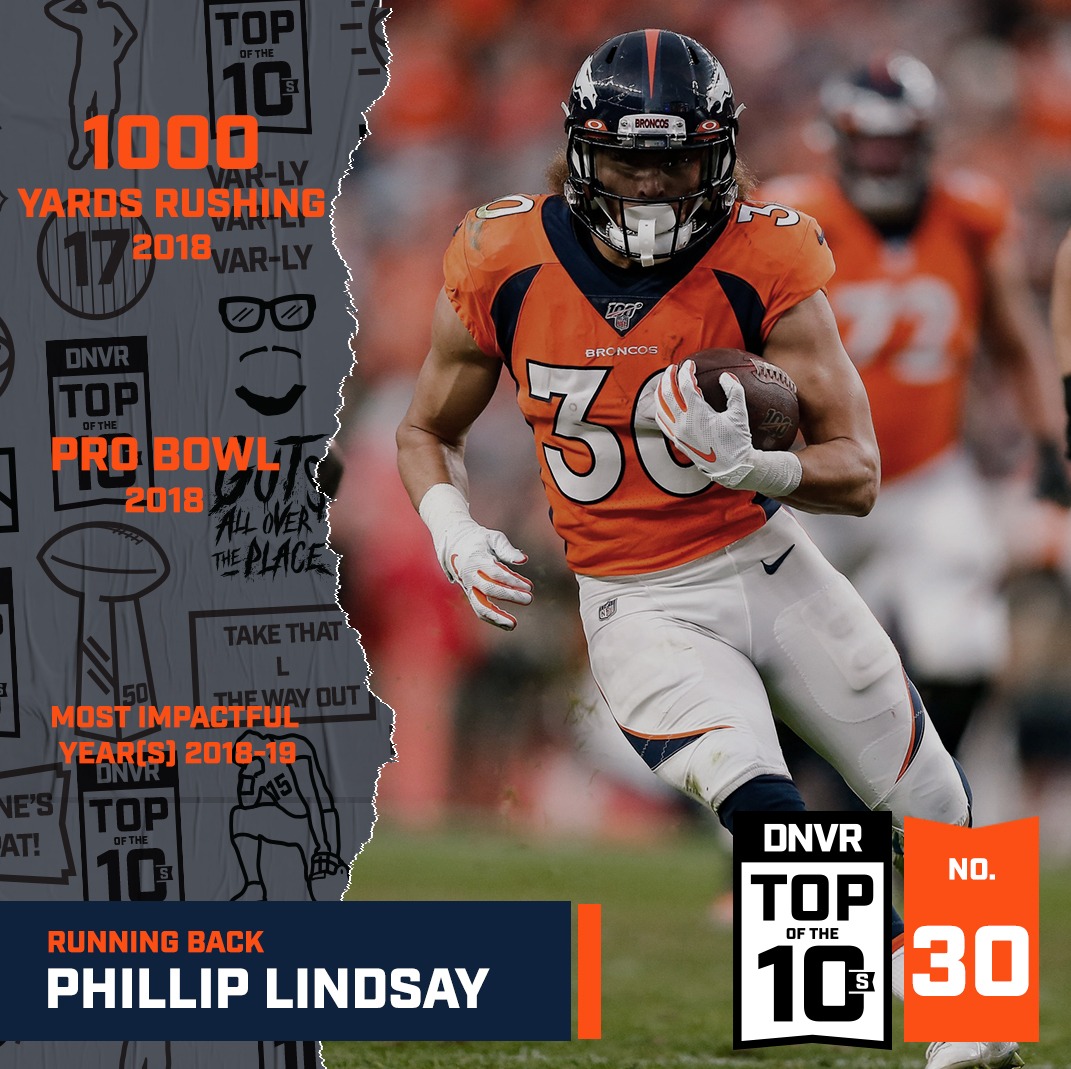
Ryan Koenigsberg: Colorado’s native son. During a dark time for the Broncos, Phillip Lindsay came in as an undrafted rookie with a chip on his shoulder and gave everyone in Colorado something to be proud of in Orange & Blue. In a state with an underdog mentality, we’re talking about a kid out of Denver Public Schools who was under-recruited, went to the University of Colorado, had a storied career, was still overlooked, and then burst onto the NFL scene with a vengeance. Phillip Lindsay is Colorado. Oh, and in his first year with the Broncos, Lindsay became the first undrafted rookie in NFL history to make the Pro Bowl on offense.
29. Semyon Varlamov
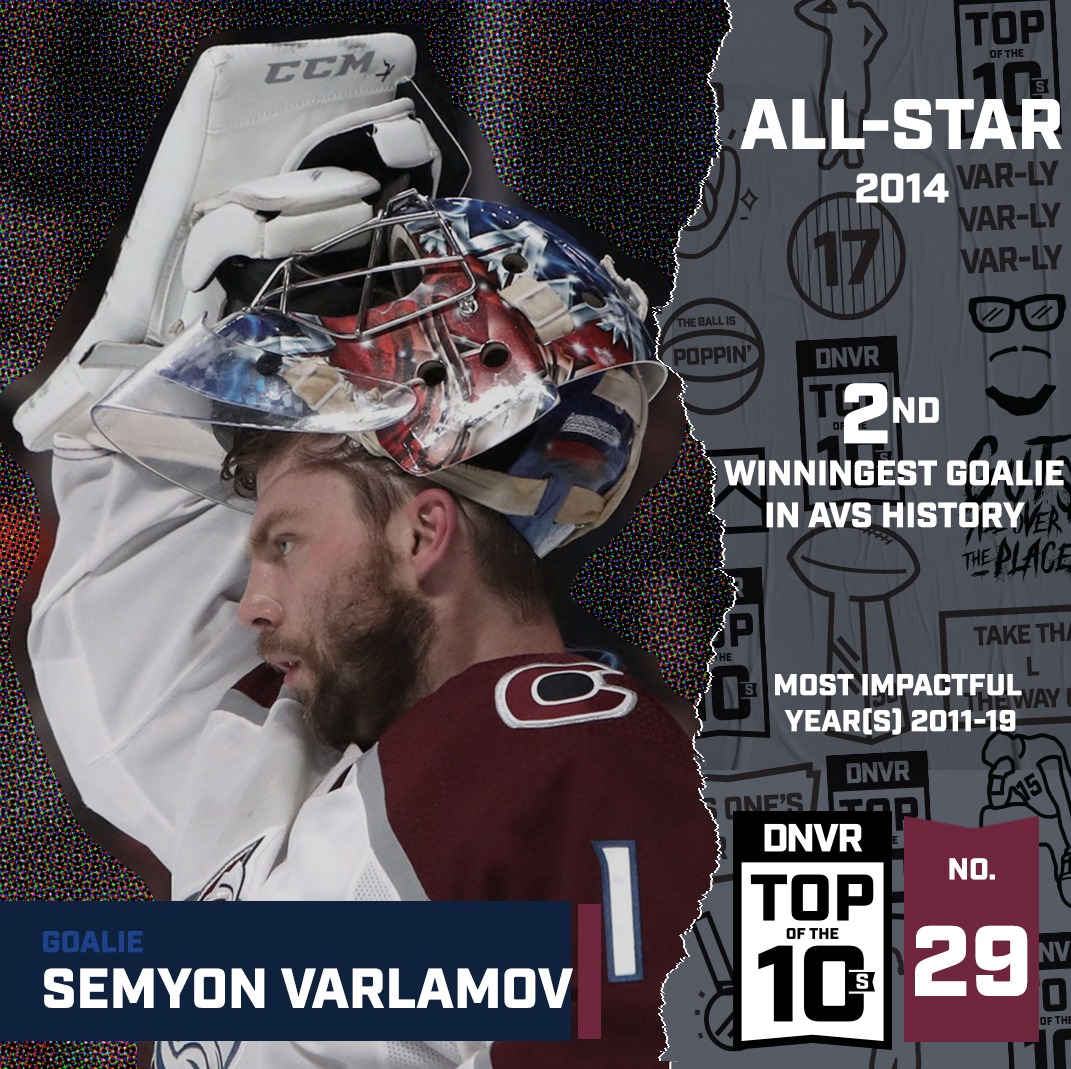
AJ Haefele: Semyon Varlamov’s time in Colorado feels underappreciated now that it’s over. He gave the Avalanche nearly a decade of starting-caliber goaltending and did so on some truly bad defensive teams. He saw so much rubber our friends over at the Denver Rubber Company were starting to get a little jealous. He ended his Avalanche career as by far the second-best goaltender in the franchise’s history behind the immortal Patrick Roy. Varlamov had his issues with injuries and it would not be fair to omit there was an off-ice situation that ended up in court when he was accused of assaulting his then-girlfriend (also important to note: he was never charged criminally and he won the civil case she brought against him because evidence showed her story did not align with the reality of the night in question). On the ice, Varlamov was a ninja spider monkey, at times brilliant and other times a sieve. In the end, he locked down the starting goaltender job for seven of his eight years and is the second-winningest netminder the organization has ever had.
28. Josh Kroenke
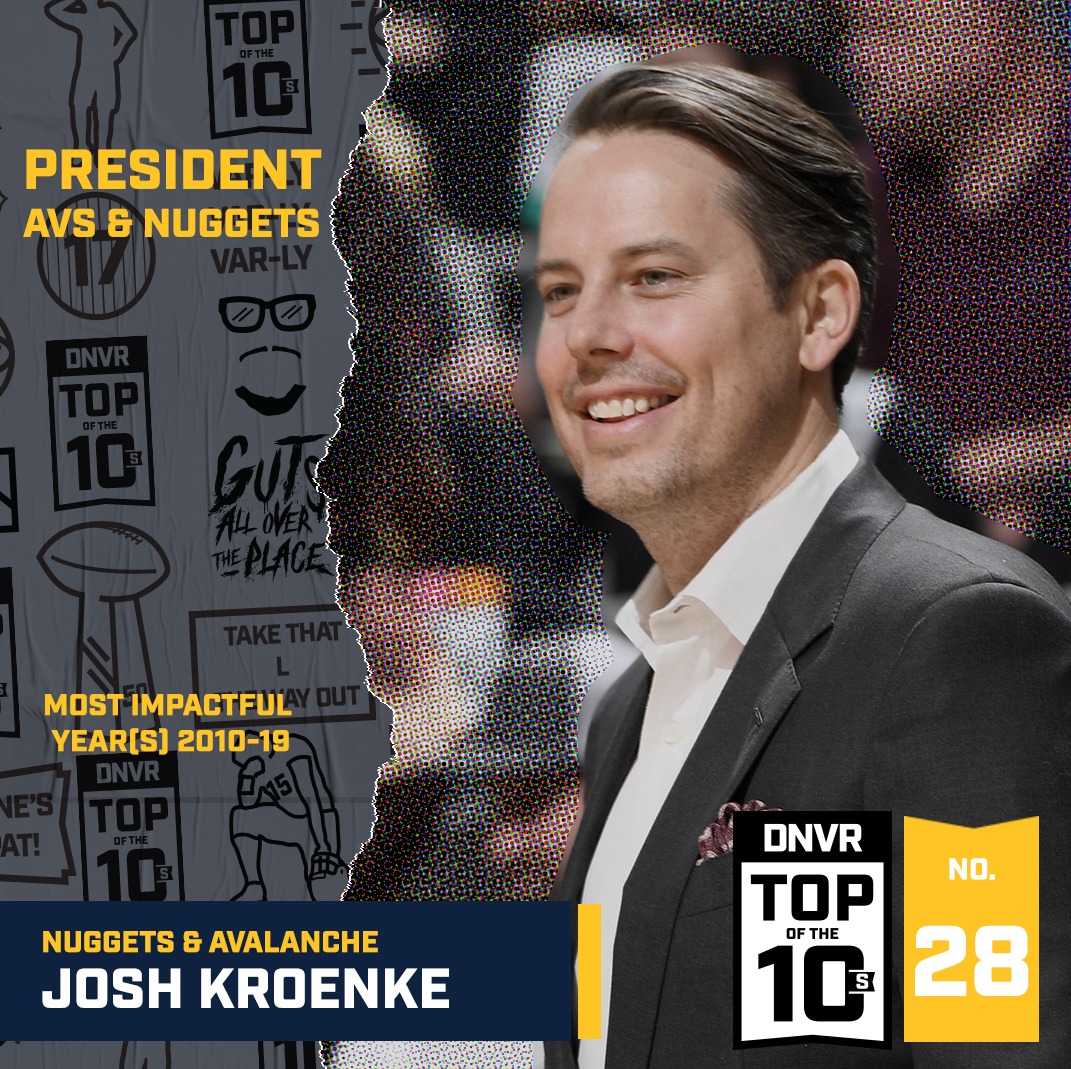
Adam Mares: At the start of the decade, Josh Kroenke was appointed to the role of President of both the Colorado Avalanche and the Denver Nuggets. In many ways, the story of those two teams throughout this decade is the story of Josh Kroenke learning on the fly and molding the teams according to his style of his presidency. The early part of Josh’s tenure was as tumultuous as could be expected for a young heir stepping into such a high-stakes role. The Avs made the playoffs just once between 2011 and 2017 and the breakup with head coach Patrick Roy in 2016 followed by an abysmal 34-point season was a low point for the organization in the 2010s.
Likewise, the departure of Denver Nuggets general manager Masai Ujiri shortly after winning the NBA’s executive of the year award, and the subsequent hiring of Brian Shaw, only reinforced the perception that Josh was unfit to build a successful organization.
But both the Avs and Nuggets have ended the decade on a high note thanks to patient, thoughtful approaches to roster building and the confidence to stick with a plan through adversity. Jared Bednar wasn’t fired after the 2nd worst season in Avalanche history, nor was Michael Malone let go after the Nuggets missed out on the playoffs by one game in back-to-back seasons. Two years later, both teams appear to be set up for sustainable success around young talent and a great culture.
27. John Fox
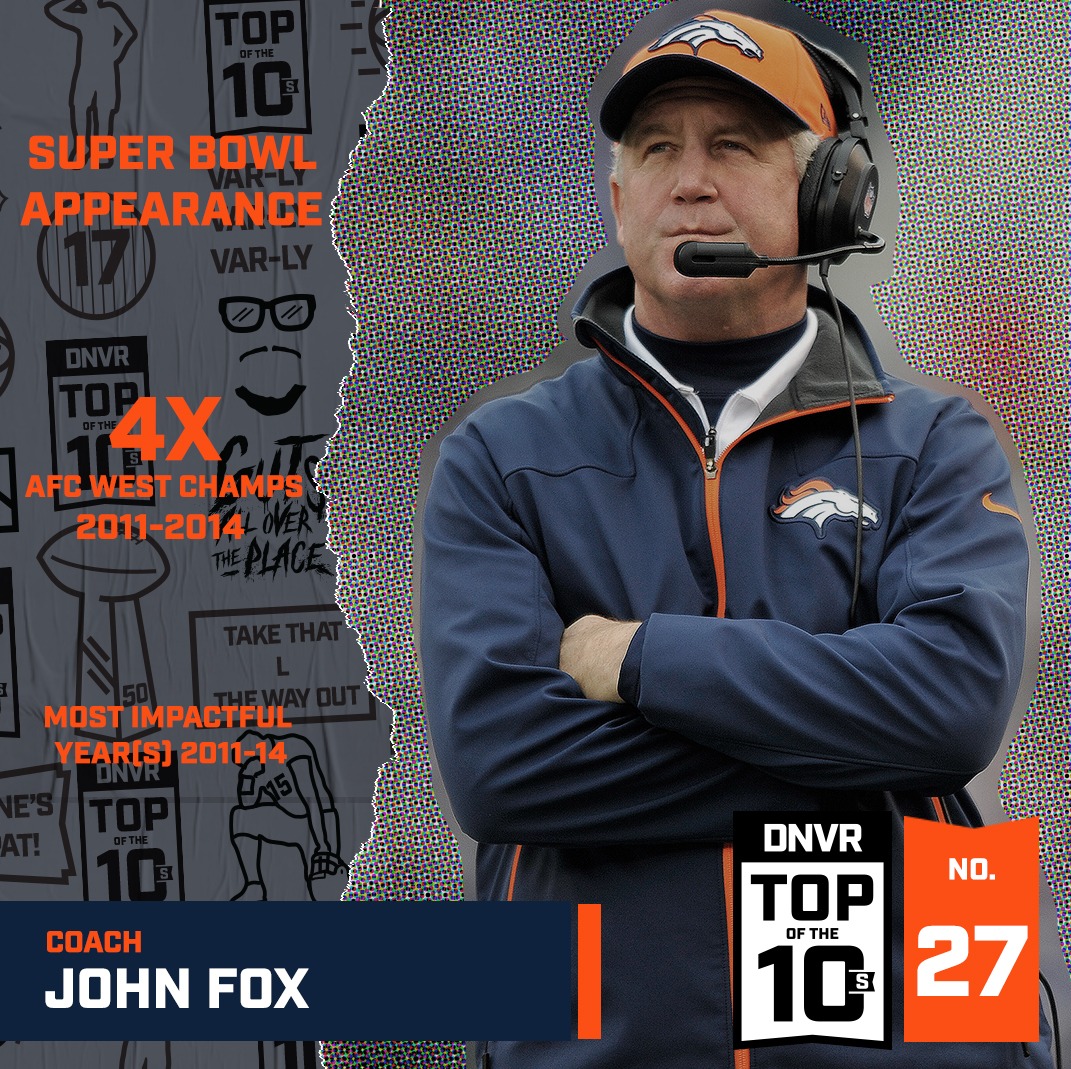
Zac Stevens: John Elway couldn’t have picked a better coach for the Denver Broncos in 2011. Fox was instrumental in building the Broncos back up to a powerhouse after it was left in shambles after thou who shall not be named tore them down. In his four years leading the Broncos, Fox never had a losing season, leading the team to four-straight AFC West titles and an incredible .719 win percentage. Yes, he did have Peyton Manning for three of those years, but he also was the commander during the unimaginable, unthinkable and improbable Tim Tebow ride.
26. Trevor Story
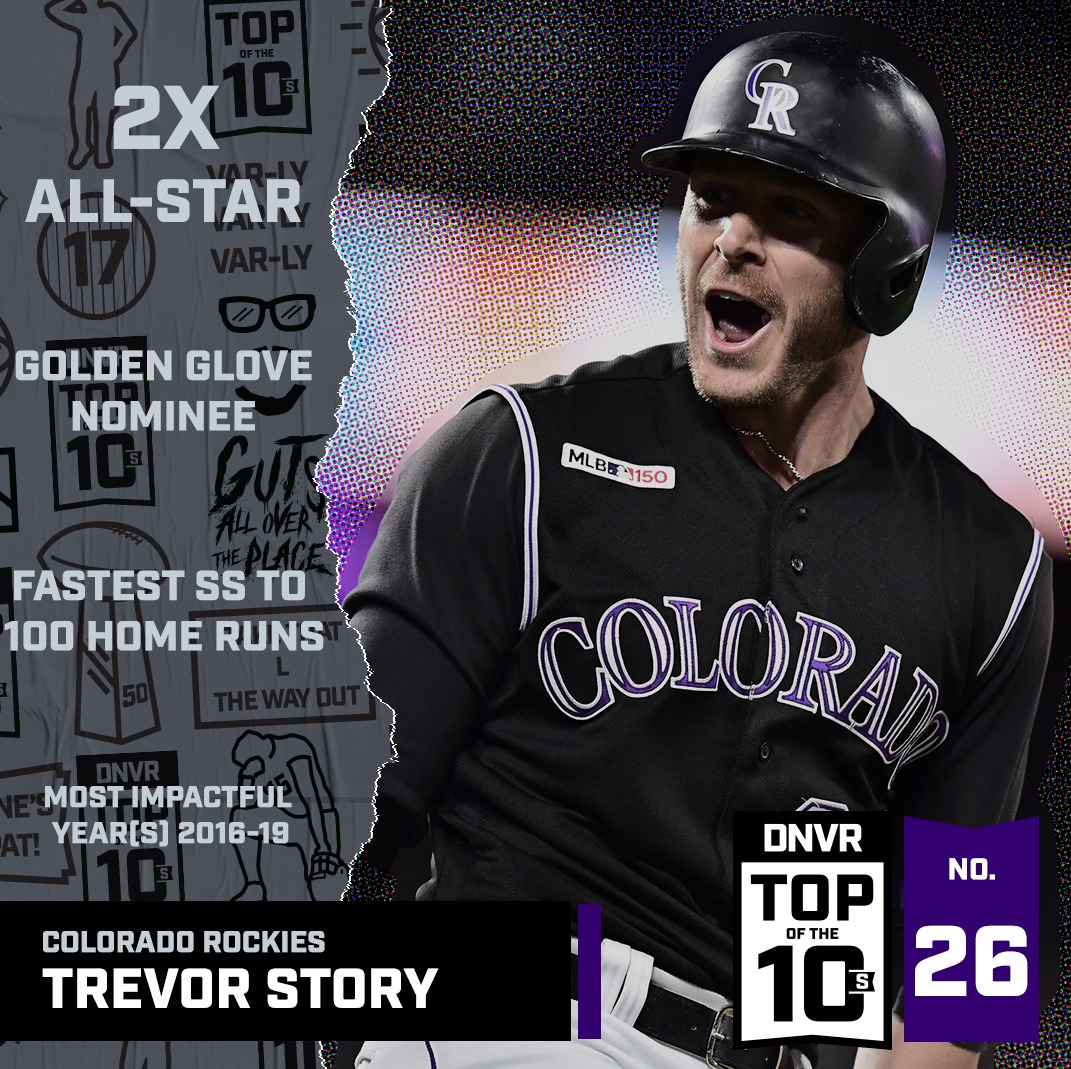
Drew Creasman: It’s early still in his career but Trevor Story is on a blistering pace. He is smashing shortstop power-hitting records and has put himself in categories alongside Alex Rodriguez and Ernie Banks. He’s finally getting recognition for his defense, earning his first Gold Glove nomination in the final year of the decade. Not a top draft pick and never considered a top prospect, Story is one of the Top 20 position players in MLB right now and one of only a handful of true five-tool talents in the game. The only reason he doesn’t rank higher is that he hasn’t quite had enough time to accrue the resume equal to many of the names above him. In terms of pure raw talent and reasons to turn on the TV to watch Colorado sports, though, he is as must-watch as anyone in town right now.
25. Bud Black
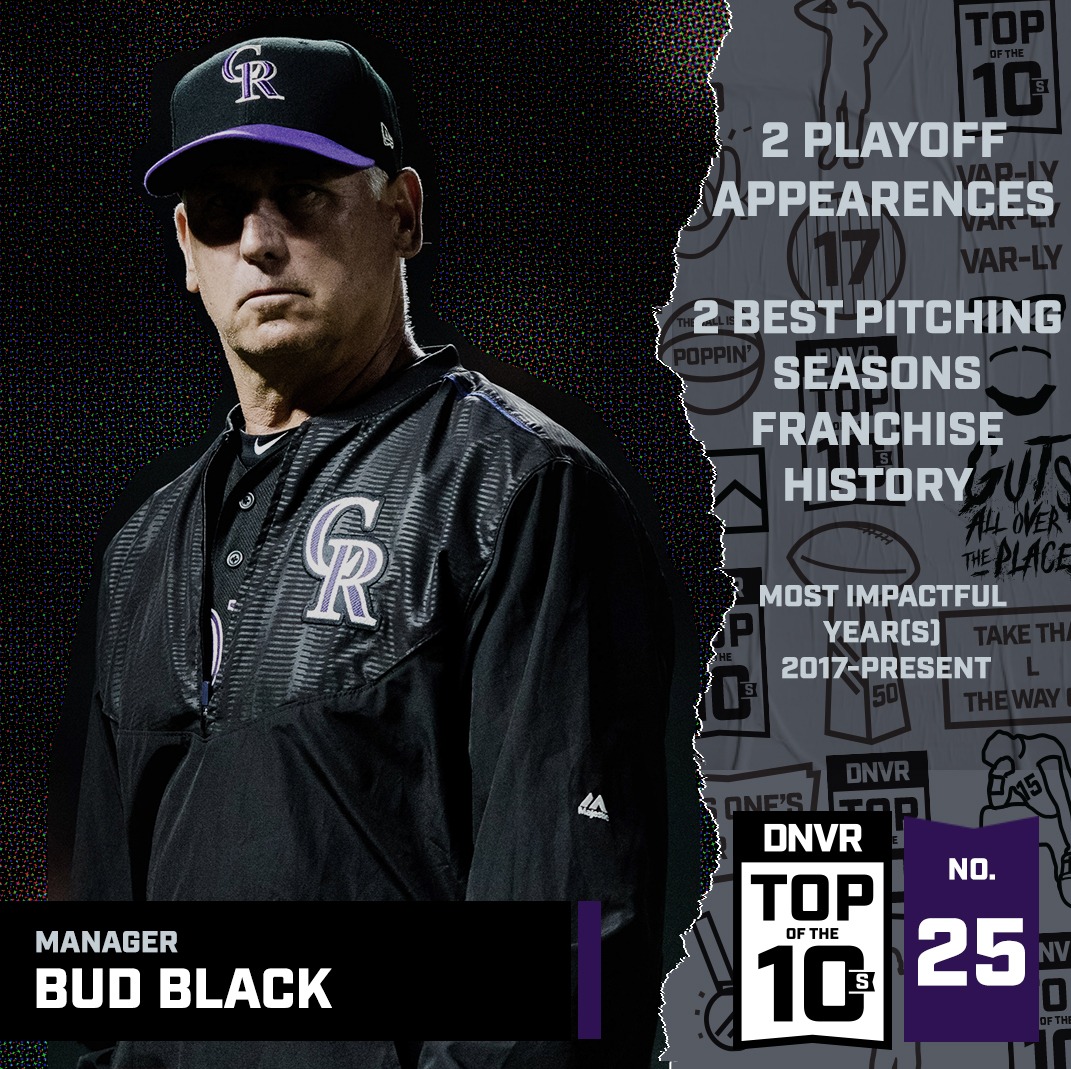
Drew Creasman: For the vast majority of their time as an organization, the Colorado Rockies have been a disaster on the mound. In his first two years with the club, Bud Black managed a squad full of unknown and unproven players who averaged younger than 25-years-old to the best pitching seasons in franchise history. Those two campaigns also, not coincidentally, coincided with the only back-to-back postseason appearances in Rockies’ history. He completely obliterated any lingering notion that the team should just give up on trying to focus on run-prevention and instead aim to outslug everyone. It hasn’t all been sunshine and rainbows, especially after a down year in his third go round, but Colorado baseball has steadied under his leadership. That he has even begun to solve one of the most unsolvable problems in pro sports – how to pitch at Coors Field – is reason enough for his placement on this list.
24. DJ Lemahieu
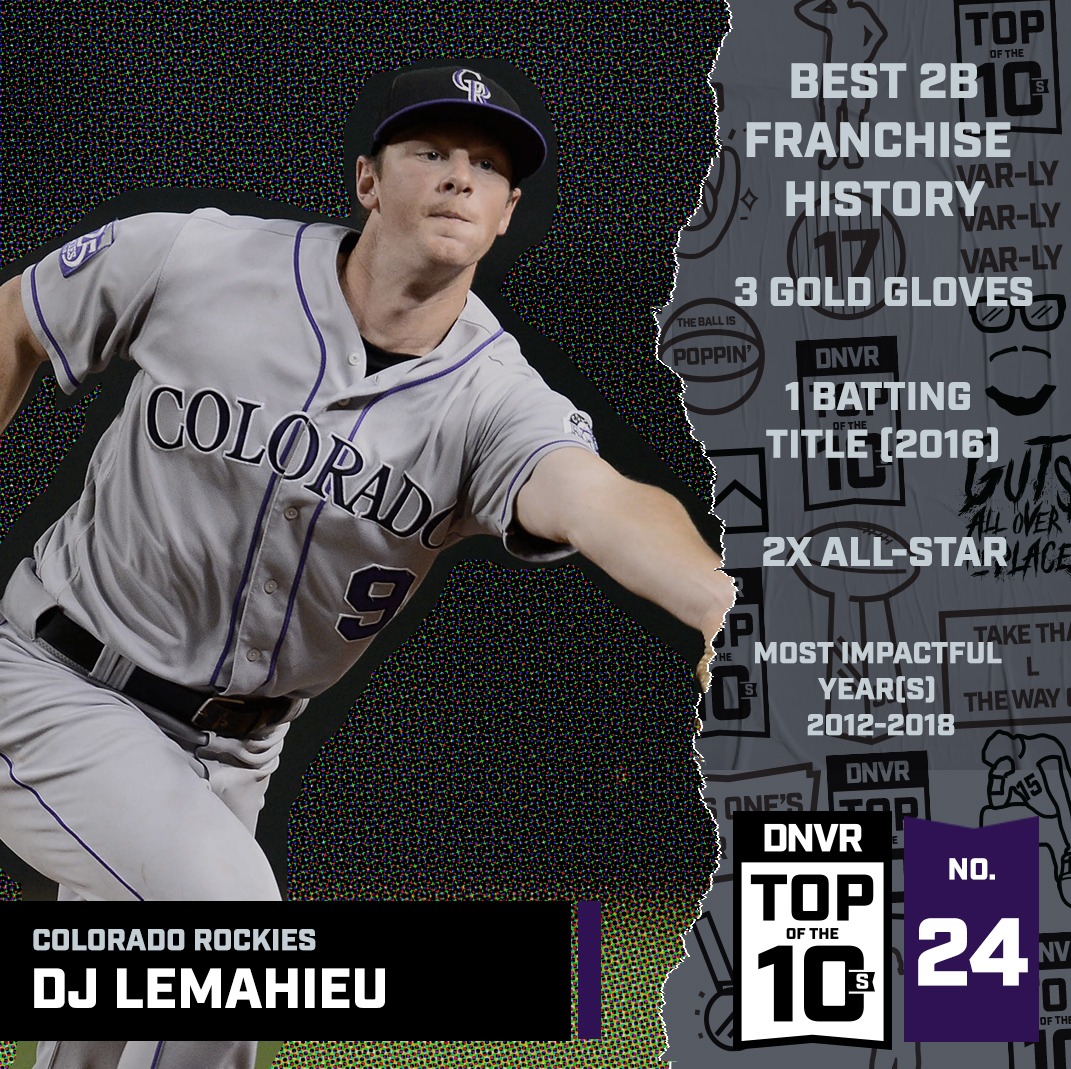
Drew Creasman: Always underrated, even probably on this list, DJ LeMahieu is without question and by a comfortable margin the best second baseman in the history of the Colorado Rockies. Thrown into a trade with the Cubs, he spent his tenure in Denver doing the unheralded work of being an exceptionally sound defender and contact hitter in a game that pays more and more attention to flashy plays and monster home runs. LeMahieu makes positive contributions to almost every single baseball game he plays in. With zero ego and an unending passion for the game, he was a favorite among his teammates in the clubhouse and among fans who appreciated his blue-collar style.
Of all the great Colorado athletes who left for another team this decade, LeMahieu may be the most beloved. He probably hasn’t lost a single fan. His eventual return to Coors Field as a visitor will bring tears to the eyes of thousands and probably to DJ himself. He never got enough attention for his time here, but for those who watched him play every single day, LeMahieu will always be our DJ and one of the greatest to ever wear purple pinstripes.
23. Masai Ujiri
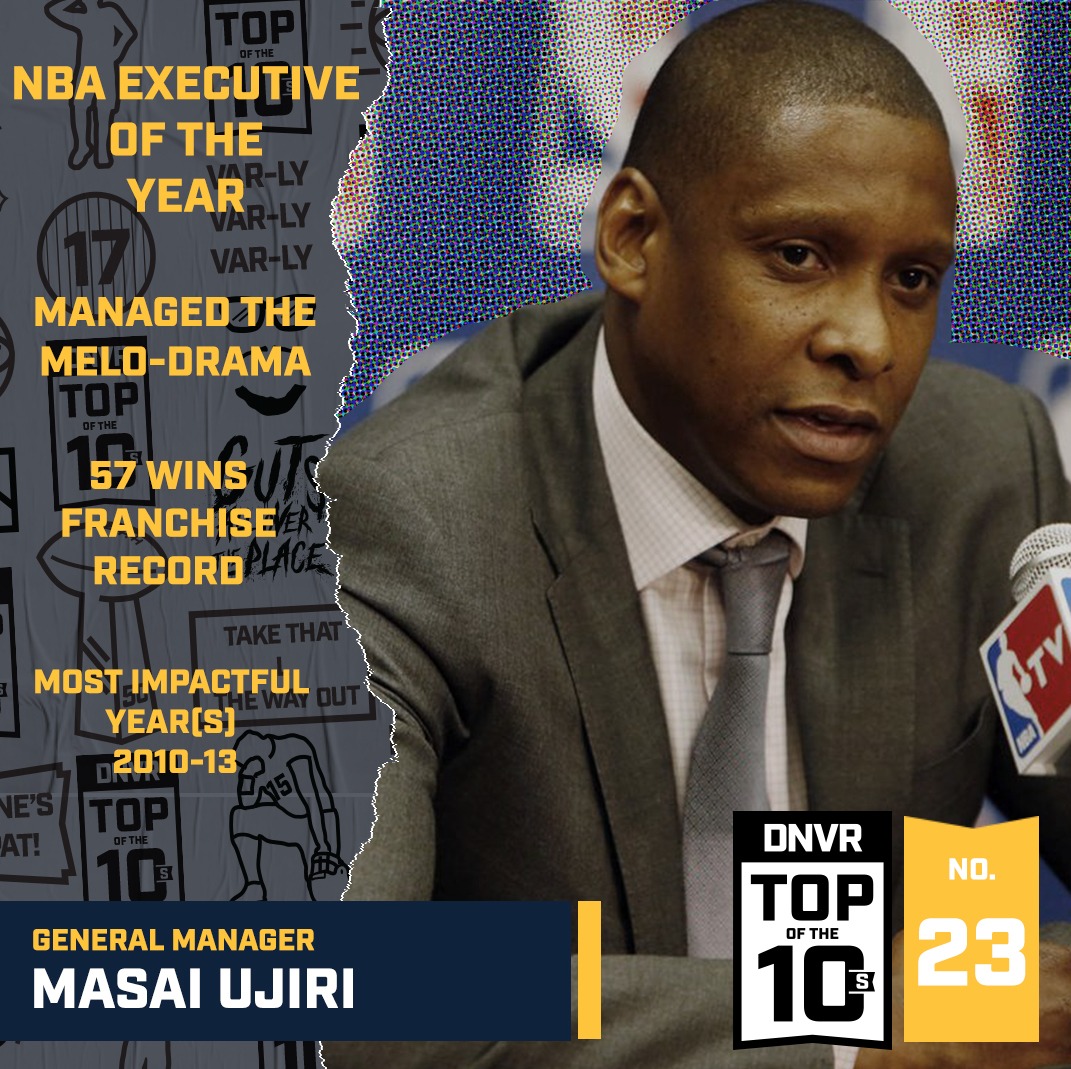
Adam Mares: It’s almost impossible to overstate just how difficult the situation was that Masai Ujiri found himself in a few weeks into his tenure as general manager of the Denver Nuggets back in 2010. The team’s star player, Carmelo Anthony, wanted out. And he was only willing to go to one place, the New York Knicks. So how do you trade a player when all of the leverage is gone?
Miraculously, Masai managed to coax the Knicks into parting ways with half of their roster and enough draft picks to not only stabilize the situation, but build a team capable of winning a franchise-best 57 regular season wins just one season later. Few people could’ve salvaged such a bad situation. Masai somehow did it in his first year on the job.
His departure in 2013 came on the heels of winning the NBA’s executive of the year award. And while Denver eventually rebounded with the addition of Tim Connelly, Masai’s masterful maneuvering during the Melo-drama and his eventual championship with the Toronto Raptors in 2019 makes you wonder what could’ve been had the team been willing and able to keep him in the building for the entire decade.
22. Wade Phillips
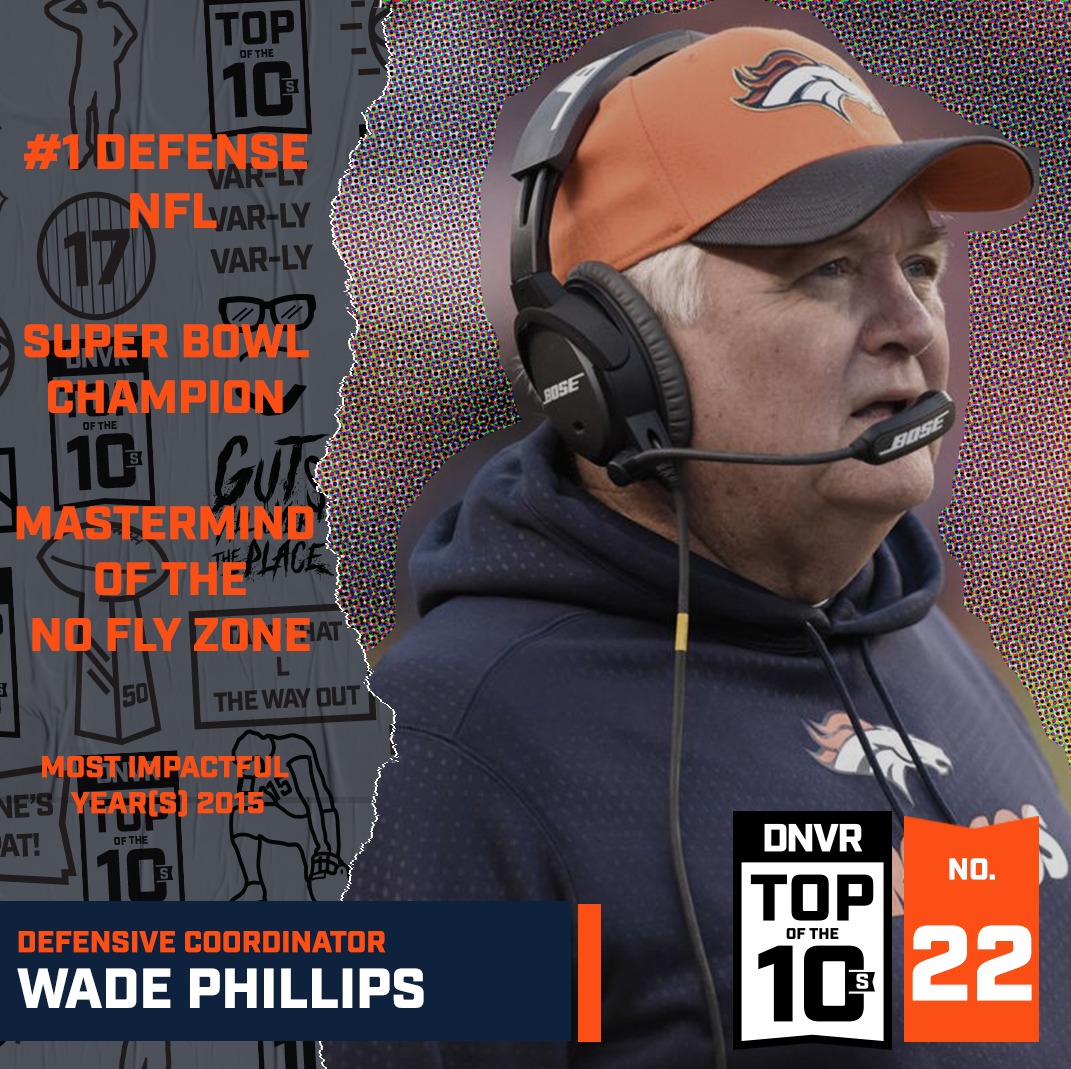
Zac Stevens: Wade’s personality and twitter presence alone might have landed him on this list. But while the Broncos’ former head coach only had a two-year stop in Denver this decade, he made them count as Denver’s defensive coordinator.
One of the oldest yet hippest coaches in the league orchestrated one of the best defenses the NFL has ever seen. Phillips certainly was handed a fantastic deck, but he played his cards just right on Denver’s path to becoming Super Bowl 50 champions. Wade’s most memorable call came in the AFC Championship game, where he dropped Von Miller in coverage, leading to the pass rusher picking off Tom Brady.
As Wade, and Drake, said, he was instrumental in delivering Denver a “really big ring.”
21. Michael Malone
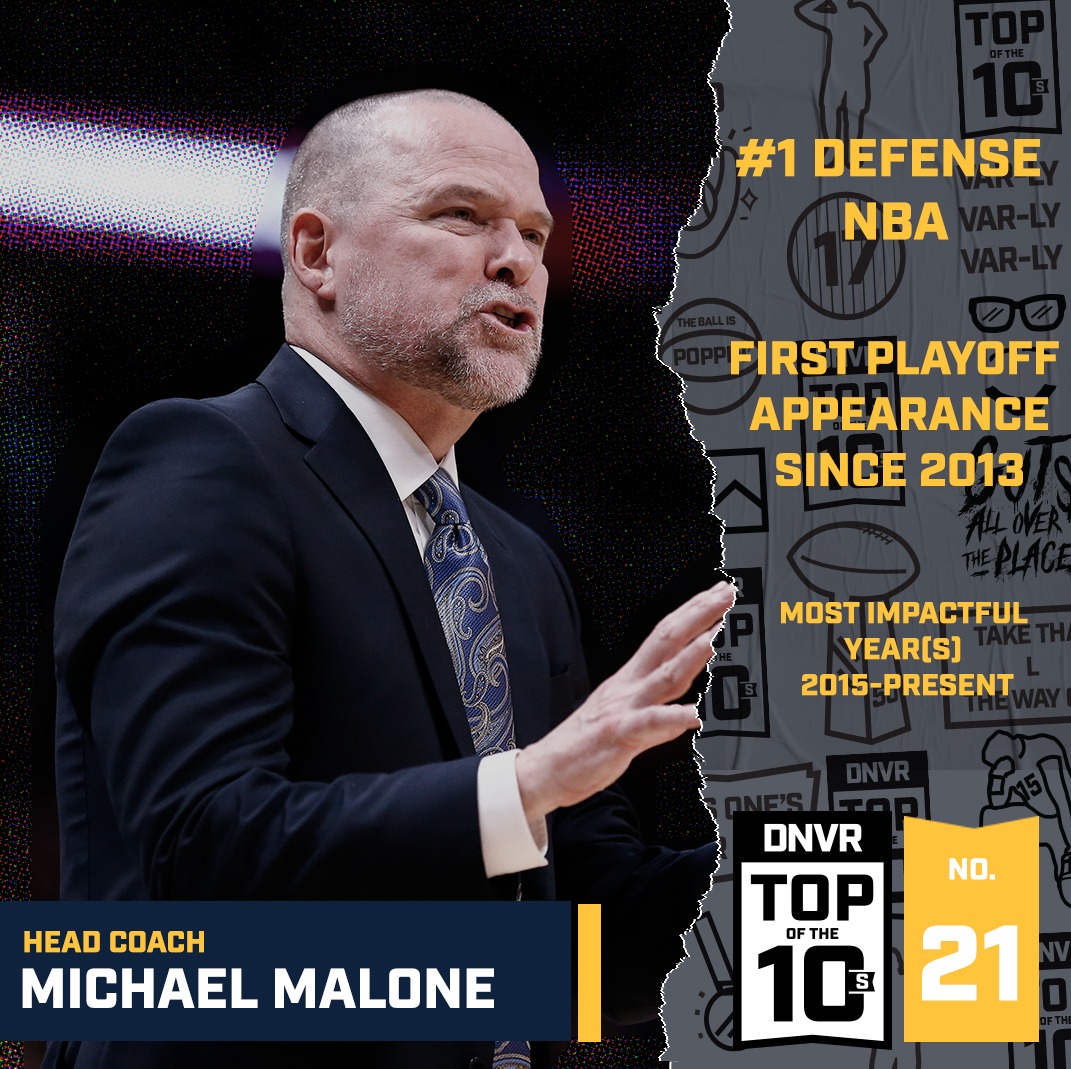
The powers that be tasked Michael Malone with rebuilding a basketball culture from the ground up when he agreed to become the new head coach of the Denver Nuggets in June of 2015. He brought his own set of expectations and goals to the job, including the revamping of a disastrous defense. He’s succeeded on both accounts as the Nuggets have increased their win total by seven, six, and then eight wins in consecutive seasons under his watch. They also boast one of the top defensive ratings in the league as the seeds he planted years ago are beginning to bear fruit. Perhaps the biggest feather in his cap is the lack of friction in a locker room chock-full of rotation caliber talent. For the most part, he’s helped a loaded young team find their respective identities and enabled them to thrive within those roles. Malone is 186-159 in his four-plus seasons in Denver and guided them to the team’s first second-round appearance in 10 years this summer.
20. Matt Duchene
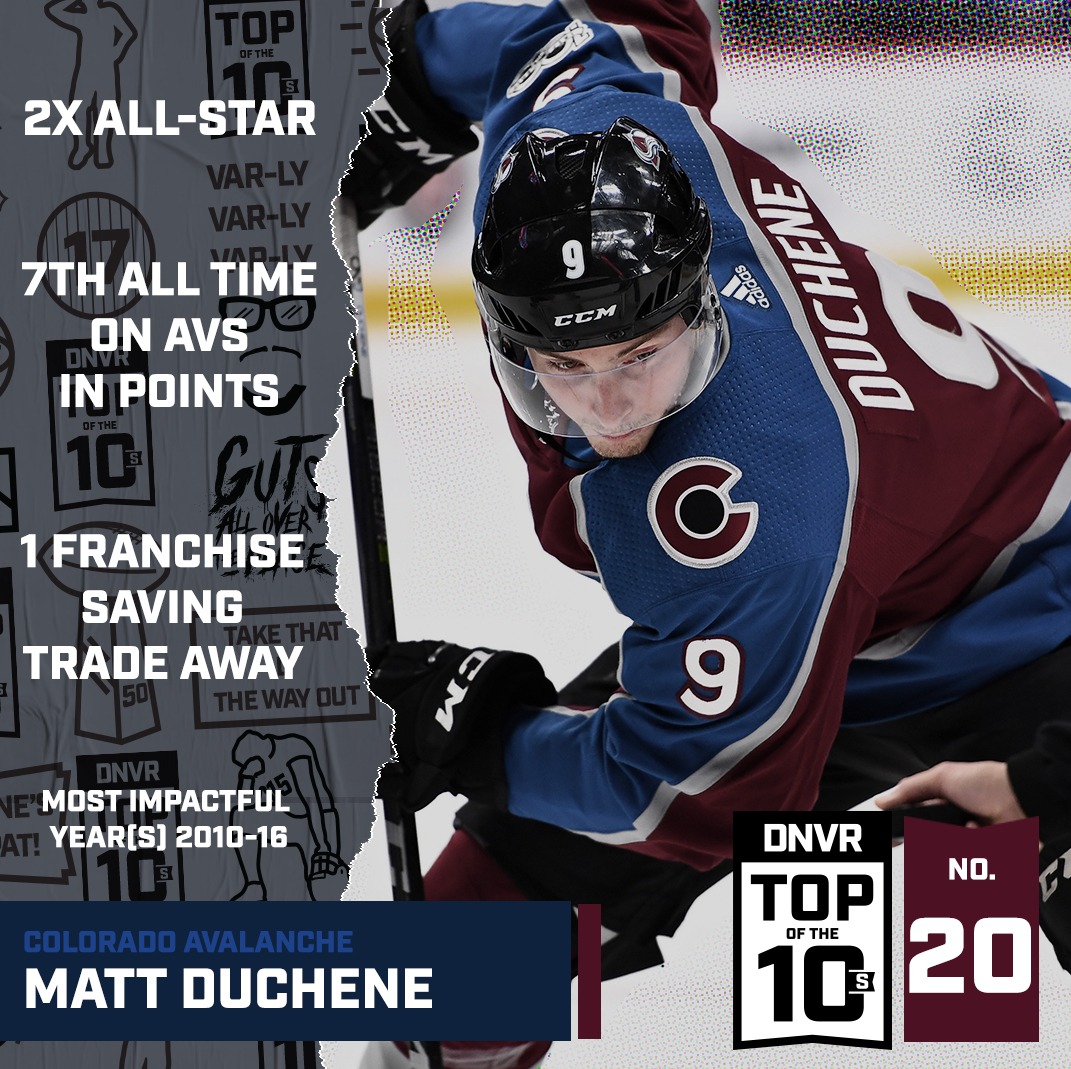
Evan Rawal: What is the first memory from this decade that most Avs fans have? April 6, 2010. In Vancouver, with the game on his stick, Matt Duchene sent the Colorado Avalanche to the postseason with a shootout winner. The rookie, and former 3rd overall pick, looked destined to be the heir apparent to Joe Sakic at that point. What could possibly go wrong? We’ll get to that.
Everyone remembers how he exited Colorado, but there were plenty of good times with the Avs. He was a two-time All Star in Colorado, going in both 2011 and again in 2016. Duchene was the leading scorer on the 2014 division winning team, scoring a career high 70 points in 71 games. His season looked to be over after a collision with teammate Jamie McGinn injured his knee, but he fought back to play in the playoffs, coming back into the lineup in Game 6 against the Wild and picking up three points in two games before the Avs were eliminated. After that, things got a little rocky.
After scoring his 30th goal of the season in a blowout loss, Patrick Roy called him out in a press conference. He looked defeated, like most of the team, during the abysmal 16/17 campaign, and ultimately asked to be traded. Joe Sakic didn’t immediately give in, waiting until the right offer came along, forcing Duchene to show up to camp the following year, which was a little…awkward. He was ultimately traded on November 6, 2017, and the Avs will reap the benefits of the trade return for the next decade. Even with the ups and downs, Duchene sits 7th all time on the Avs franchise scoring list, and was the face of the franchise for a good portion of the 2010’s.
19. Aqib Talib
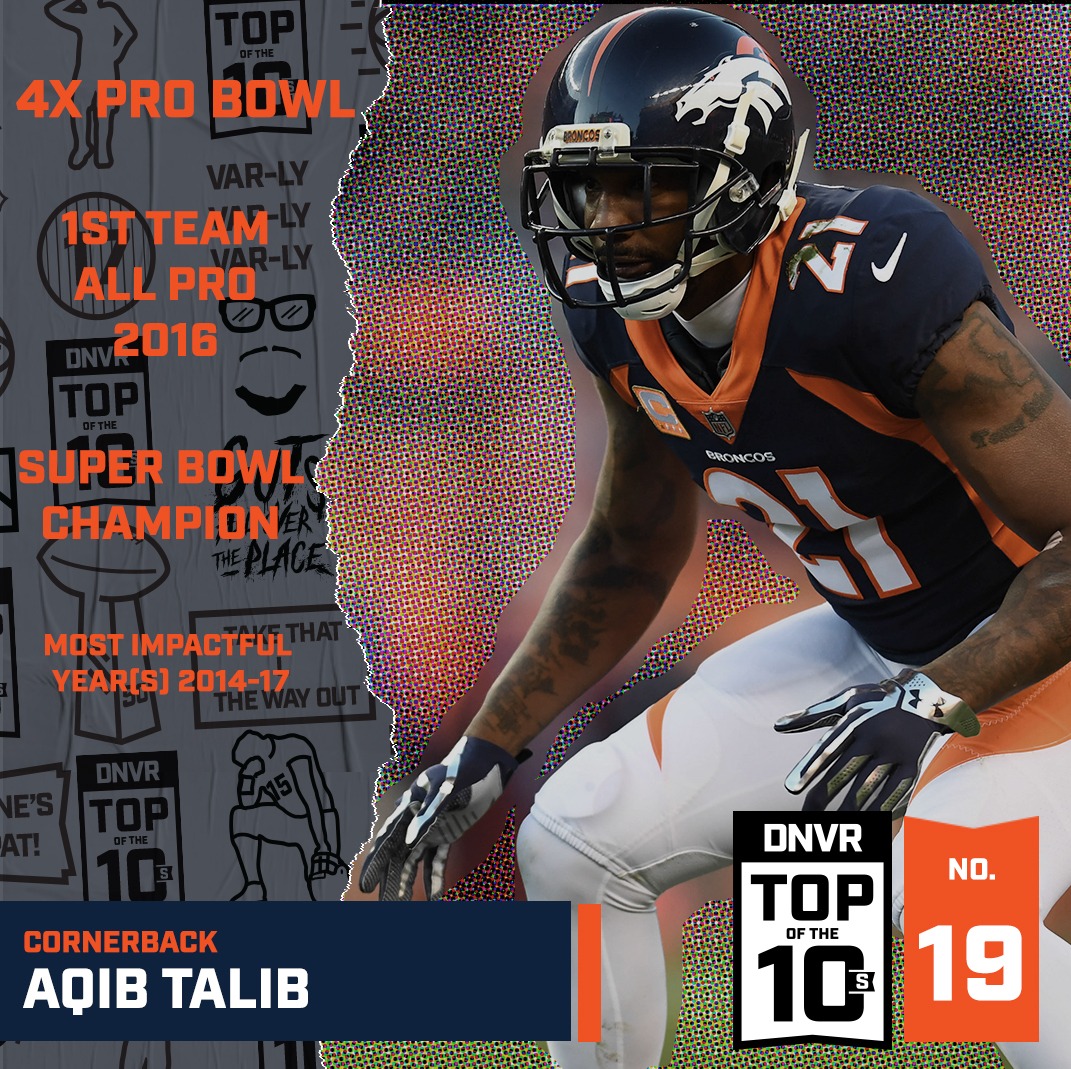
Ryan Koenigsberg: From the soundbytes, to the swagger, to the propensity for a personal foul, Aqib Talib, in many ways, embodied one of the greatest secondaries of all time, the “No Fly Zone.” While he had plenty of talent around him in Chris Harris Jr., Bradley Roby, T.J. Ward and Darian Stewart, it was Talib who turned them into the group of badasses that they really were.
While he was highly criticized for the play, his vicious facemask penalty in the early going of Super Bowl 50 sent a message to the Panthers that the defense was out for blood that day. Like it or not, it was the type of tone-setting move that Talib was known for, and it’s a big part of the reason that defense was quite literally feared.
And let’s not discount his talent. A Pro-Bowler in every year he was a Bronco and a first-team All-Pro in 2016, Talib is undoubtedly one of the best shut-down corners in the history of the franchise.
18. Tim Tebow
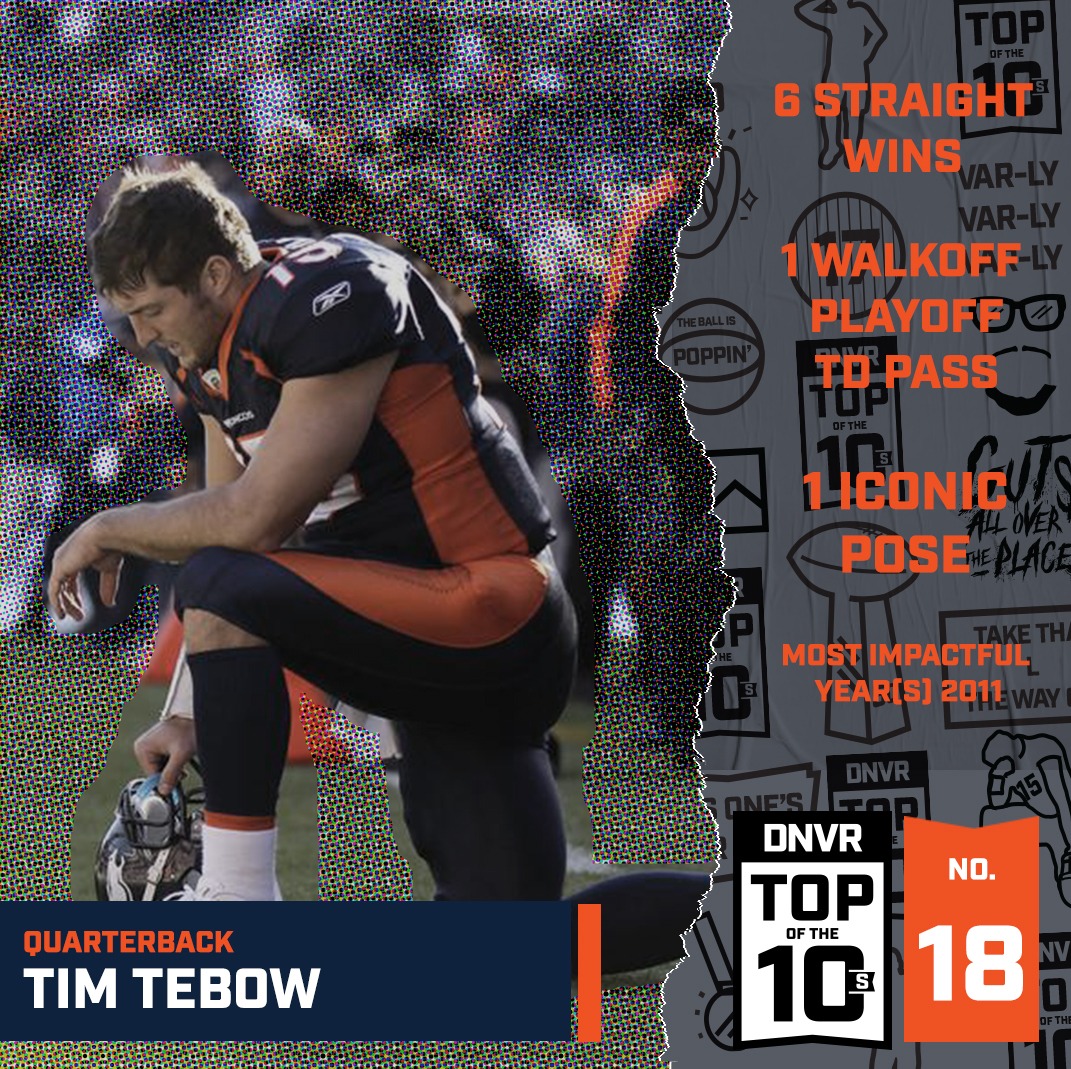
Andrew Mason: Everything about Tim Tebow’s brief flash as the Broncos’ starting quarterback in 2011 was serendipitous. Coaches using unorthodox tactics. Opponents making baffling mental mistakes — such as Chicago’s Marion Barber III inexplicably running out of bounds to give the Broncos extra time for one late comeback. Even numbers that created a buzz among the particularly religious segments of Tebow’s fan base. But above all, Tebowmania would not have happened if the Broncos had not had a resourceful coach: John Fox. Five years earlier with the Panthers, Fox took his team to Atlanta without its starting QB (Jake Delhomme) and with a backup in Chris Weinke who had an injured throwing shoulder. He instructed his then-offensive coordinator, Dan Henning, to devise a package based around the absence of a healthy passer. From that, the “Wildcat” formation was born. Carolina ran 52 times, and Weinke attempted just seven passes as the Panthers upset the Falcons, 10-3.
Drawing from that experience and humbled by a 45-10 thrashing to the Lions that showed the limits of Tebow in a traditional pro-style offense, Fox instructed quarterbacks coach Adam Gase and offensive coordinator Mike McCoy to figure something out. What they devised was an option-heavy attack that caught the Raiders out of position. Tebow and running back Willis McGahee ran past Oakland’s befuddled edge rushers and linebackers, and a six-game winning streak that turned a 2-5 nightmare into a division title was on.
Within the locker room, the Broncos fan base and the swath of Tebow acolytes far and wide, there was belief. Outside of those realms, skepticism lingered and ran rampant after the Patriots, Bills and Chiefs exposes Tebow in a three-game losing streak to close the regular season. The Broncos backed into the playoffs and prepared to face the Steelers, but speculation about being ready to turn to backup Brady Quinn ran wild. Quinn wasn’t needed, however, as Steelers defensive coordinator Dick LeBeau chose not to mimic the tactics of the teams and coordinators that had defused Tebow. He guided the Broncos to an early lead, and then, on the first play of overtime, hit Demaryius Thomas in stride for an 80-yard touchdown that sent Mile High into delirium.
The S.S. Tebow crashed on the rocks of New England six nights later, and the Broncos knew that their option-based offense with an inaccurate quarterback was unsustainable. But by guiding the Broncos to an 8-5 record and a playoff win as their starter, Tebow provided a jolt that made the Broncos relevant for the first time in six years. Without that turnaround, Peyton Manning might have been a Tennessee Titan instead. But Manning saw the promise in Denver that Tebow had unlocked, and he chose the Broncos.
The Tebow Era was a comet: a burst of light across the firmament. But it turned out that its tail dusted the Broncos in magic that led to Manning and the best four-year run in Broncos history.
Not bad for a 46-percent passer.
17. Pat Bowlen
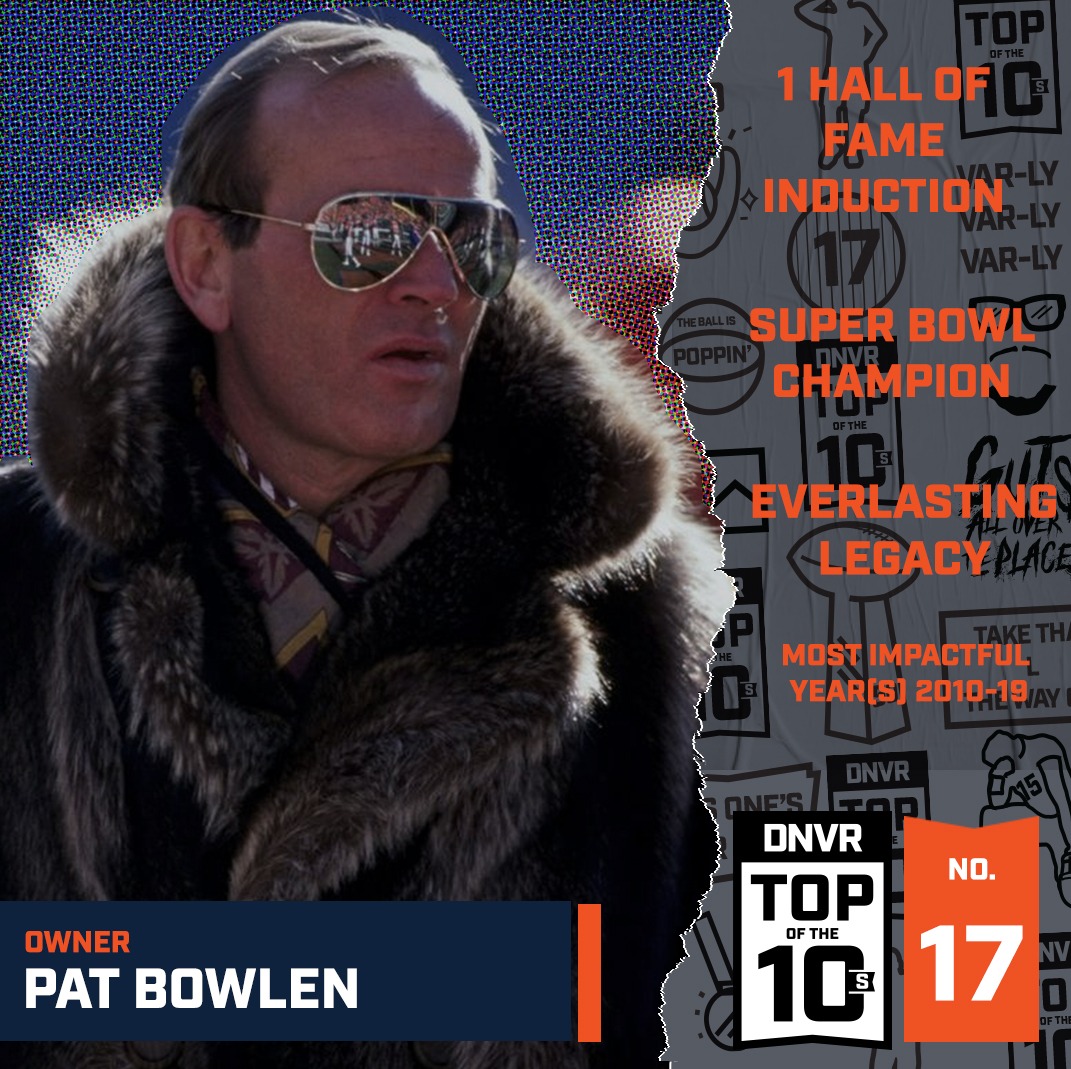
Ryan Koenigsberg: One of the most highly-debated names on this list, in terms of where he belongs, Bowlen’s contribution to the decade has a lot to do with what he set in motion in the early years of the 2010s.
During a rare time of strife for his beloved Broncos following the failed Josh McDaniels experiment, Bowlen turned to the best player in his franchise’s history, John Elway, to come in and restore order, giving him the title of general manager and executive vice president of football operations.
Of course, Elway did just that, and while No. 7 gets most of the credit for the courtship of Peyton Manning, which led to the best four-year stretch in franchise history, The Sheriff himself has also since said, “Mr. Bowlen was a big part of the reason why I ended up coming to Denver.”
While he officially stepped away from the team in 2014, Bowlen also gets credit for his induction into the Hall of Fame earlier this year, a big moment for the city, as Denver finally saw the best owner in its sports history get the honor he so rightfully deserved.
16. Tim Connelly
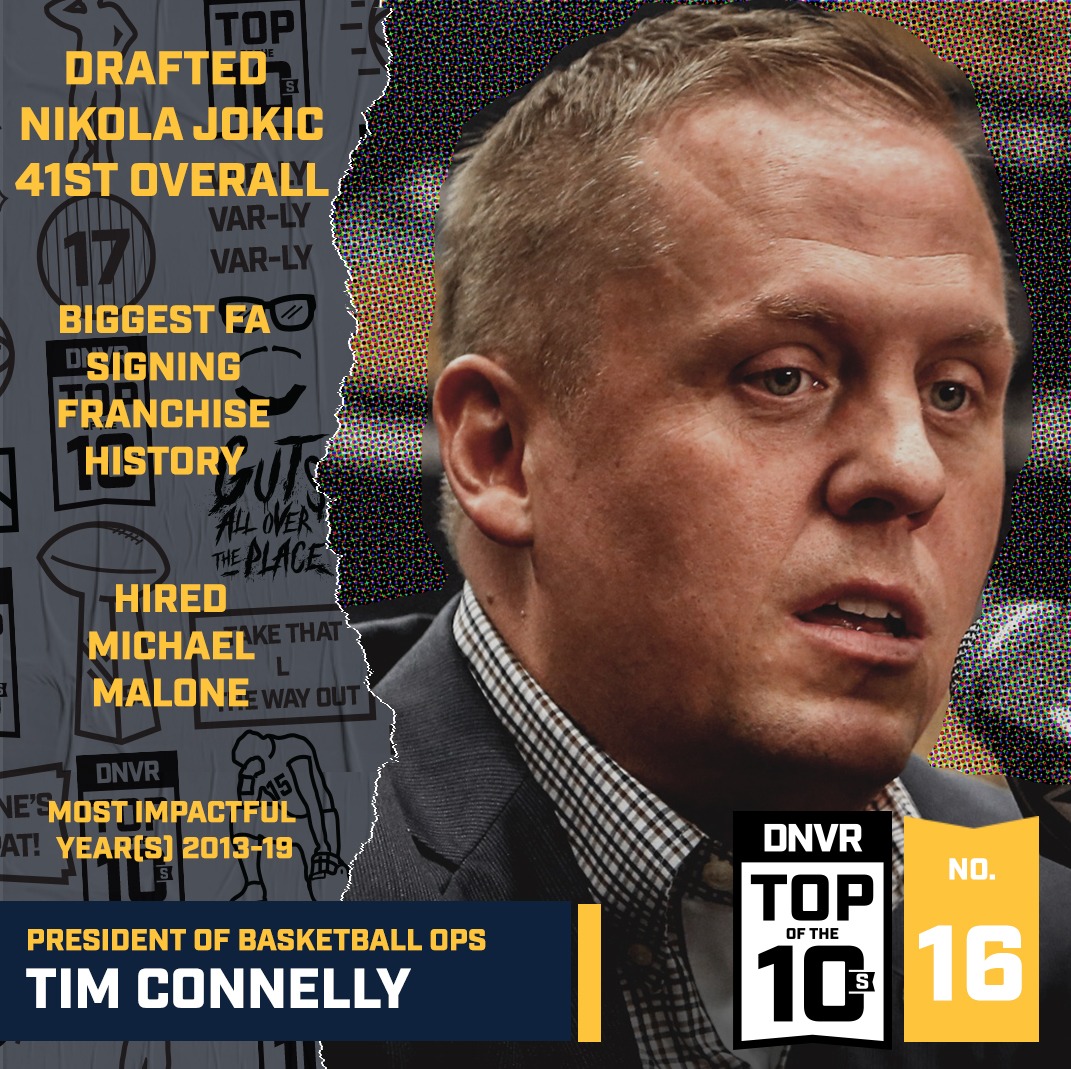
Harrison Wind: Tim Connelly had big shoes to fill as Masai Ujiri’s replacement when the Nuggets hired him in 2013, and over the last six seasons he’s transformed the Nuggets from a lottery-bound team with no direction to a championship contender. Connelly has done most of his work through the draft, mining the second round for talent like Nikola Jokic at 41st overall in 2014, and Monte Morris at 51st overall in 2017. He’s hit on way more picks than he’s missed on in the first round too, nabbing Jamal Murray with the seventh pick in the draft in 2016 and pulling off a franchise-altering trade in 2014 when he flipped the No.11 selection (Doug McDermott) for the No. 16 and 19 picks that draft which turned out to be Jusuf Nurkic and Gary Harris.
Nine of the 14 players on the Nuggets’ current roster were acquired through the draft including rotation pieces Malik Beasley and Juancho Hernangomez. In free agency, Connelly’s patient and prudent approach put Denver in position to sign Paul Millsap in 2017, which further transformed their culture and helped usher in a new defensive-first mindset. Connelly also plucked Torrey Craig, who started 11 of 14 playoff games for the Nuggets last season, out of Australia. Trades like the acquisitions of Will Barton and Mason Plumlee have bolstered Denver’s rotation, while low-risk high-reward draft selections of Michael Porter Jr., Jarred Vanderbilt, and Bol Bol could set the Nuggets up for continued success well into the next decade.
15. Gabe Landeskog
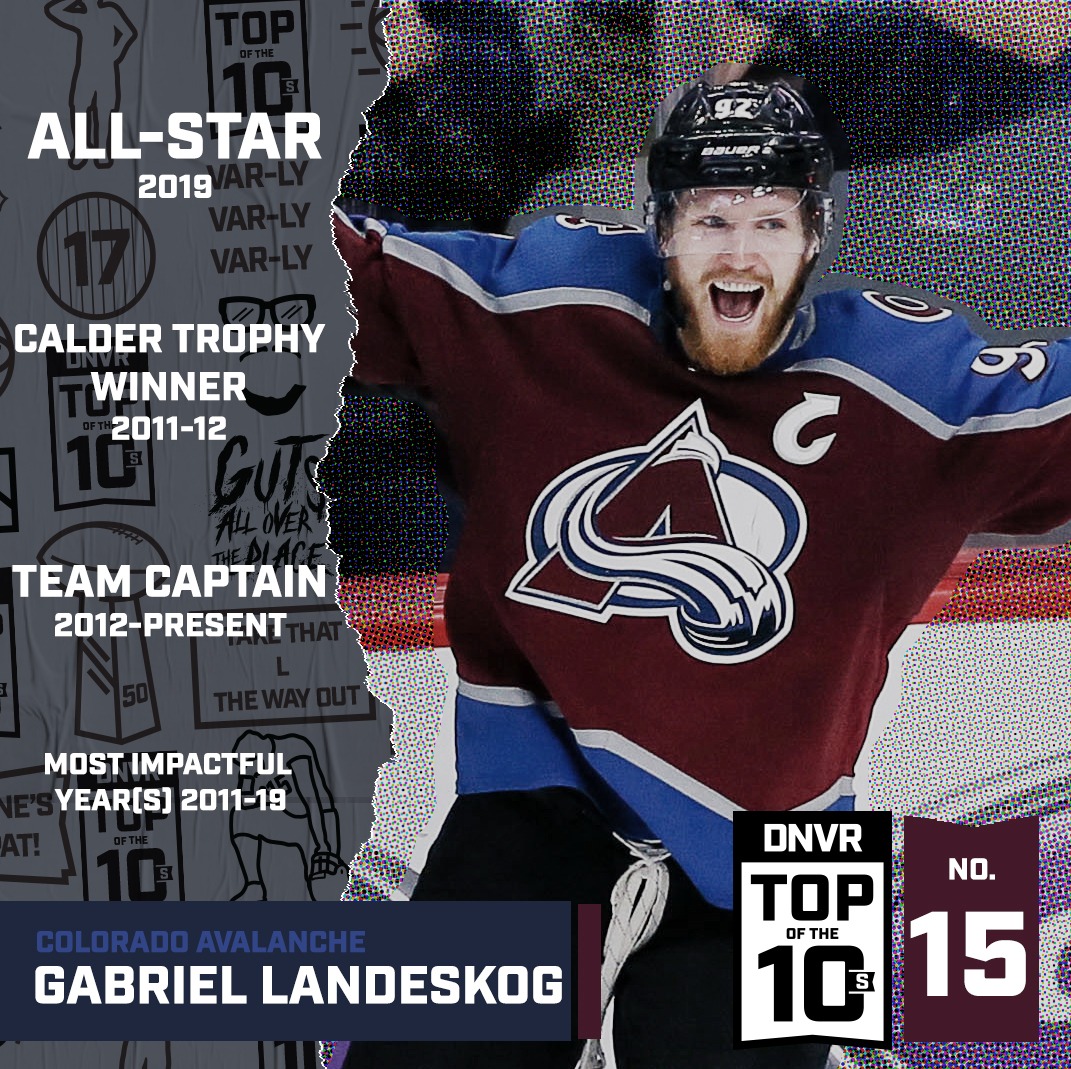
AJ Haefele: There are few faces more recognizable over the last ten years of Colorado sports than Gabe Landeskog’s. Named the youngest captain in NHL history (at the time), Landeskog took over the primary leadership responsibility in an organization that has prided itself on only allowing the best of the best to carry the weight of that job. Joe Sakic, Adam Foote, Milan Hejduk, all players whose jerseys hang in the rafters of Pepsi Center. Now, Landeskog.
While his career accomplishments have been a slow burn and nobody would argue he’s ever been the team’s best player, you can certainly say he’s long been the heart and soul of the franchise. When things went south in 2016-17, some players asked out. Landeskog specifically asked to stay. He understood the pride that once accompanied being a member of the Avalanche and wanted to work to restore that image. Since then, the Avs have made the postseason twice, winning their only playoff round of the decade and are off to another hot start this season.
Landeskog’s elevation to the top line next to Nathan MacKinnon and Mikko Rantanen created the NHL’s most lethal duo for over two full seasons, culminating in career-highs for all three players. Landeskog’s offensive flair is occasionally overshadowed by his two-way excellence.
A very good player, Landeskog is an elite human being and his work in the Denver community, his anti-bullying campaigns and his standing as the face of the Avalanche in the You Can Play Project all cement his standing as an even better person off the ice than he is player on it.
I imagine next next decade we’ll be talking about the retirement of Landeskog’s jersey alongside his fellow Avalanche captains.
14. DeMarcus Ware
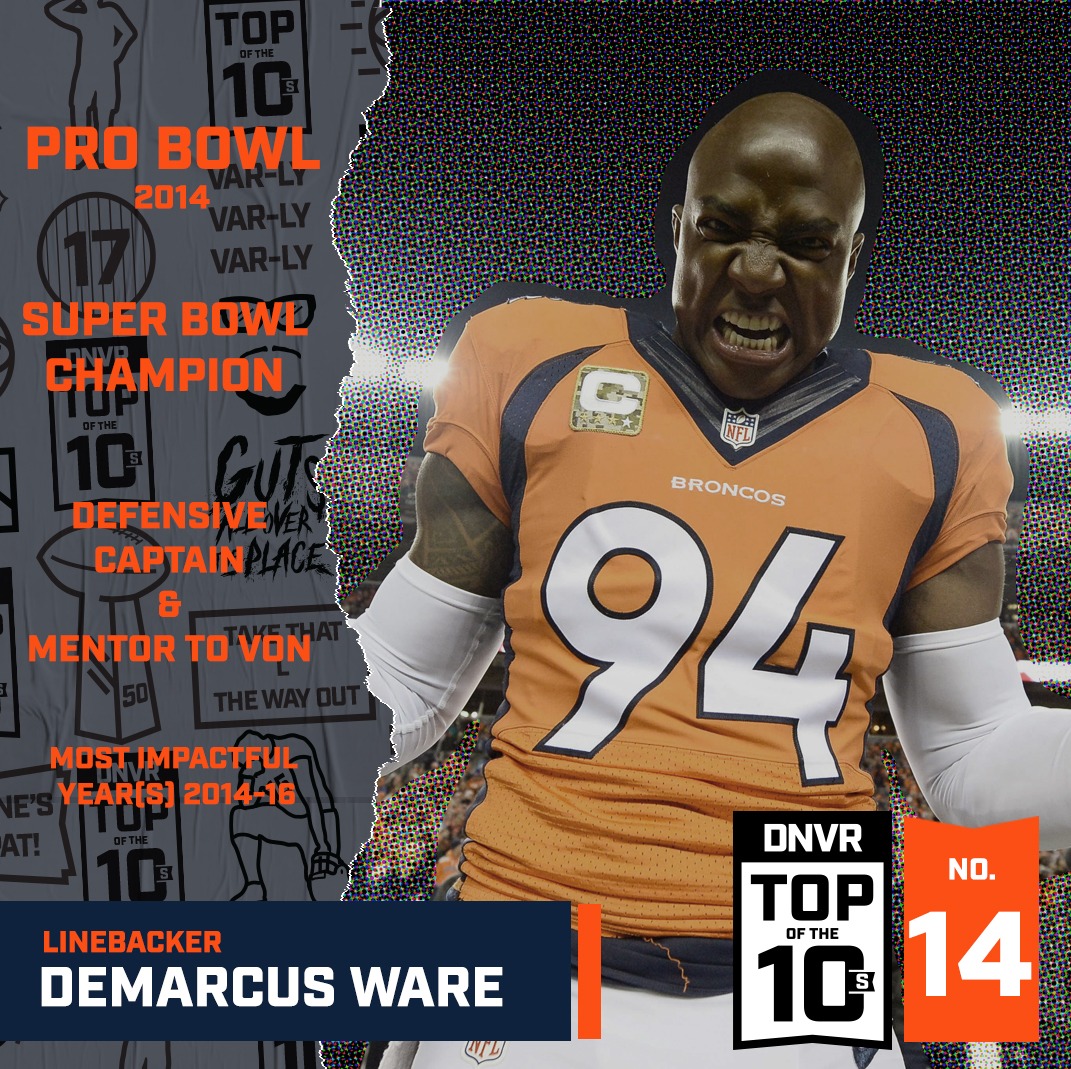
Zac Stevens: John Elway signed two first-ballot Hall of Famers in the decade. The first was, of course, Peyton Manning. The second was DeMarcus Ware. And much like Peyton, Ware’s impact was much more than just on the field.
Ware was the unquestioned leader of the defense—addressing the team the night before the Broncos won Super Bowl 50 to mentoring Von Miller to the player and person he is now.
On the field, No. 94 was pretty darn good, too. While Ware only spent three seasons in Denver, he was crucial in transforming the Broncos from an offensive juggernaut to an all-time defense. As good as Von was in the playoff run to Super Bowl 50, Ware was nearly as good—racking up 3.5 sacks, including two in the Super Bowl, and leading the team in quarterback hits in the playoffs with 12.
Ware’s 138.5 career sacks were mostly as a Cowboy, but his most meaningful were in Orange & Blue.
13. Troy Tulowitzki
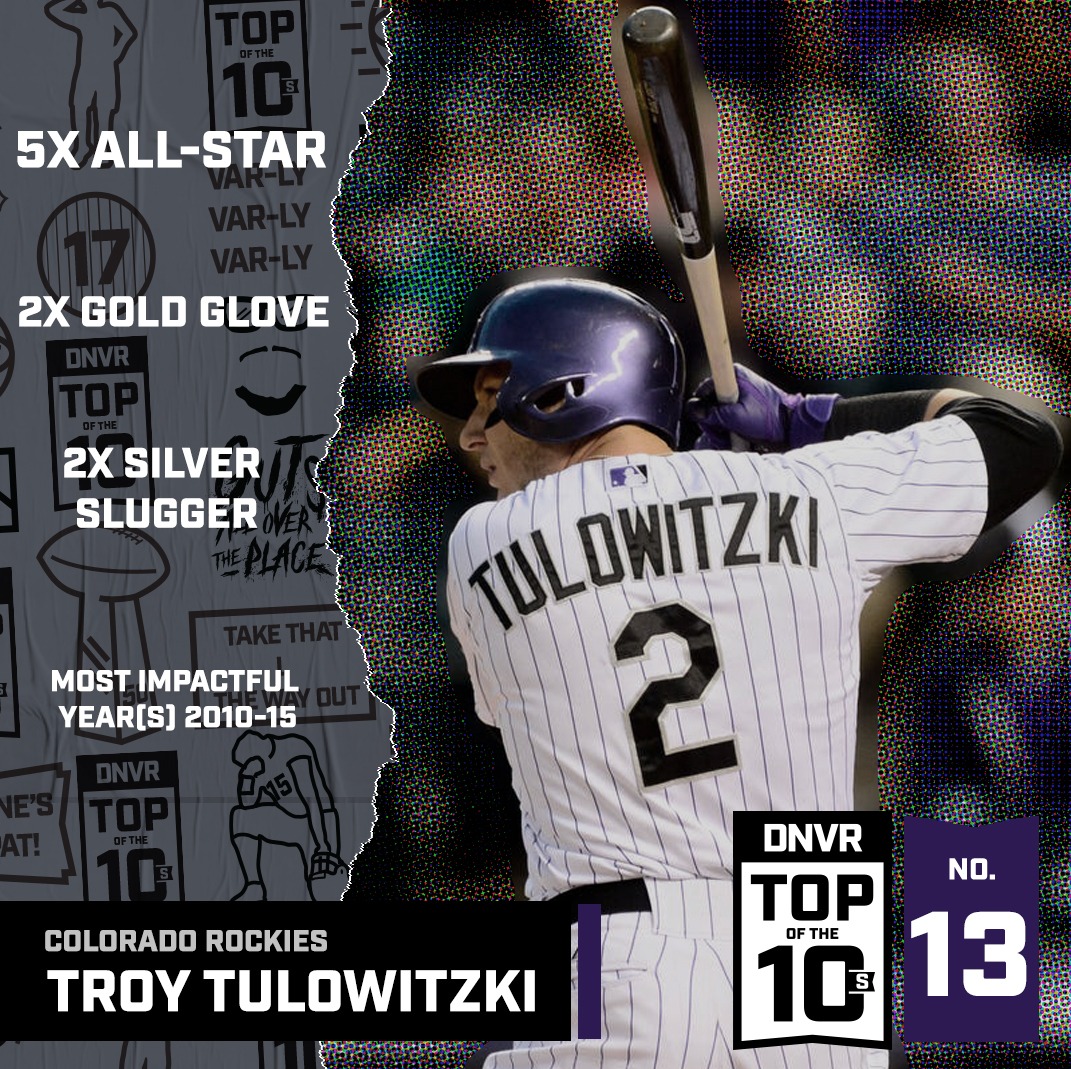
Drew Creasman: The ending was brutal and most of his time in Denver was mired by “what ifs” defined by injuries that stole away so much promise, but Troy Tulowitzki may just be the single most talented baseball player to ever put on purple. When he took the field, he was arguably the single most valuable player in MLB on both offense and defense. He had his own chant as a rookie, stupefied Vin Scully (and the rest of us) by hitting 15 home runs in 15 games in 2010, and set a new standard for what can be expected of All-Star shortstops. Sadly, a surefire Hall-of-Fame career was derailed by a litany of injuries and despite his obvious greatness, Tulowitzki was never able to reach his true potential. At his best, he dominated the game in a way that few, even today, are capable of.
From 2010-2014, he hit .312/.387/.553 with 11 home runs and 361 RBI. Probably the greatest post-humidor stretch of offense the club has seen. He was also the best defender in baseball at the most demanding position by catcher. That’s why he received MVP votes in four different years in the decade.
Even with all the issues plaguing his career, culminating in the fact that he has now retired, by just about every metric, Tulowitzki was the best shortstop of the decade.
12. Charlie Blackmon
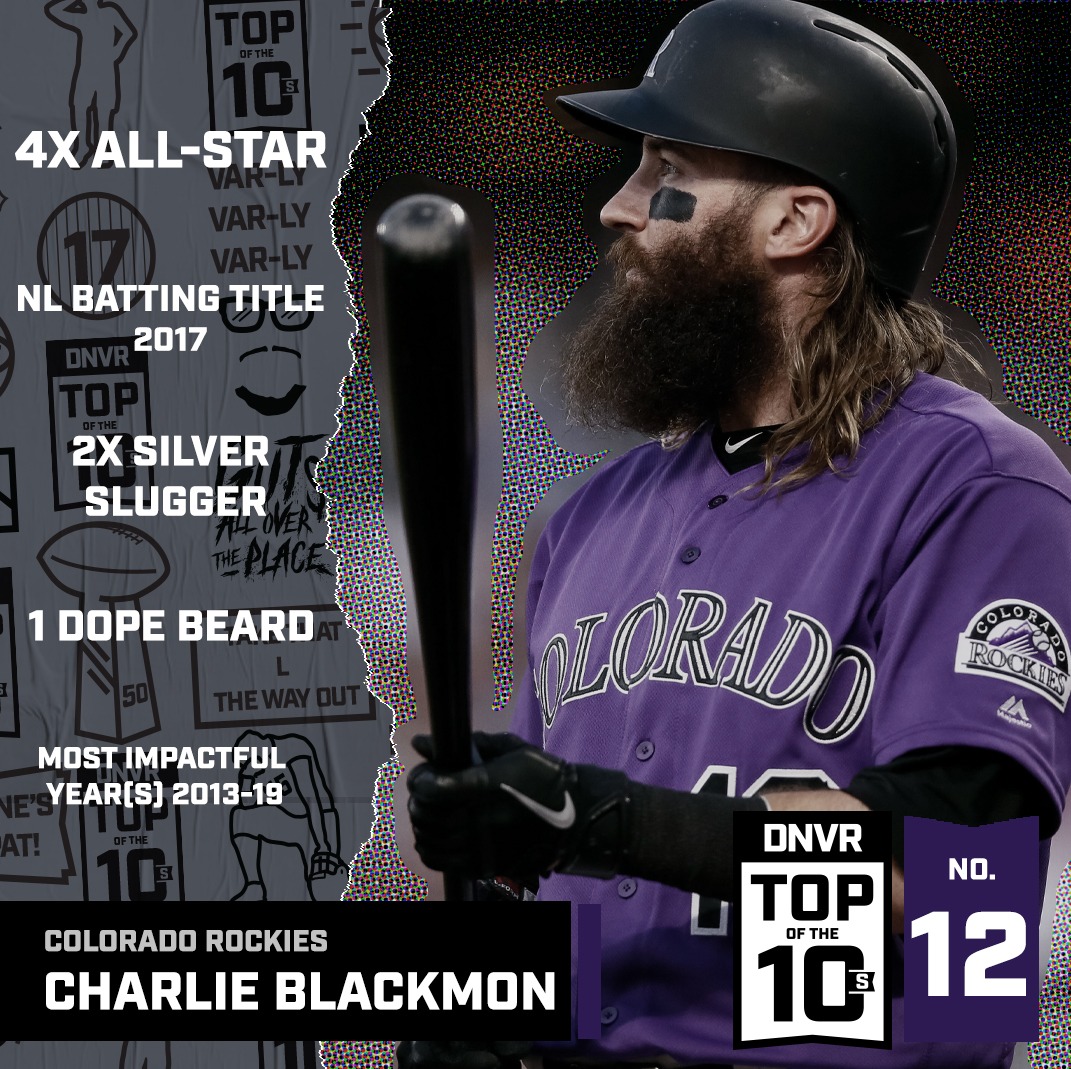
Drew Creasman: Charlie Blackmon has been overlooked and underrated for so long it can be staggering to look back at what he has accomplished while everyone was looking the other way or waiting for the other shoe to drop. The beginning of his career was inconsistent and uneven, leaving most fans and pundits to conclude he was a slappy, contact hitting tweener whose ceiling was as a fourth outfielder. But in 2014 he began to transform himself through a now legendary process of meticulous preparation and he became one of the most feared hitters in baseball.
Since then, he has appeared in four All-Star games, taken home two Silver Sluggers, won a batting title and received MVP votes twice, finishing in fifth place in 2017. That season was, by the numbers, the single greatest for a leadoff hitter in the history of Major League Baseball.
Perhaps as important as any of that, Blackmon has become a part of the fabric of the city of Denver. In an organization that has had more than its fair share of phenomenal outfielders over the years, he has become as beloved as any of them. His beard is an iconic image for sports in Colorado. His walk-up music is a part of our daily religion in the summer. His serious-yet-fun, work-hard-play-hard, put-your-teammates-first-and-do-what-it-takes-to-win attitude is a perfect fit for his adopted community. A lifetime Rockie to this point and perhaps forever, Charlie Blackmon is first in the lineup and first in the hearts of countless Colorado baseball fans.
11. Demaryius Thomas
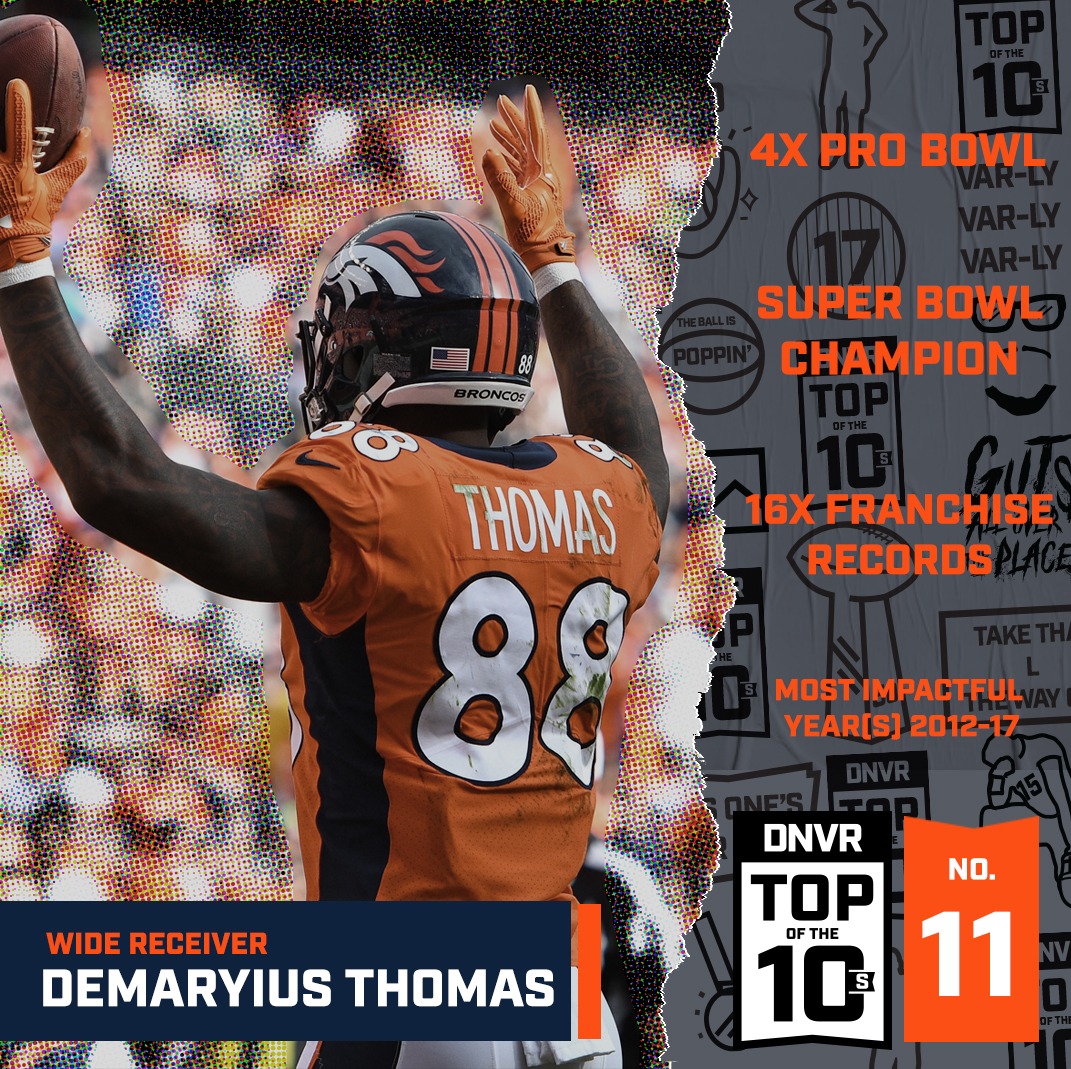
Ryan Koenigsberg: Somehow, Demaryius Thomas is the most under-appreciated Bronco of all time and, at the same time, one of the best, if not the Broncos receiver of all time.
Did he have his run-ins with the drops? Sure. But to use that as a reason to belittle his accomplishments as a Bronco is simply asinine. Thomas holds the Broncos’ franchise records for most receiving yards in a season (1,619), most receiving TDs in a season (14), most receiving yards per game (76.3), most playoff receptions (53), most playoff touchdowns (6), and many, many more.
Five straight 1,000-yard seasons, five Pro Bowls and a shiny Super Bowl ring to boot.
On top of all that, Thomas was as tough as they come at the receiver position. After injuries mired his first two years with the organization, he started a remarkable 114 straight games from the beginning of his third year all the way to the day he was traded to the Houston Texans in 2018, playing through injury after injury and producing all along the way.
DT is a legend, don’t let anyone try to tell you otherwise.
10. Gary Kubiak
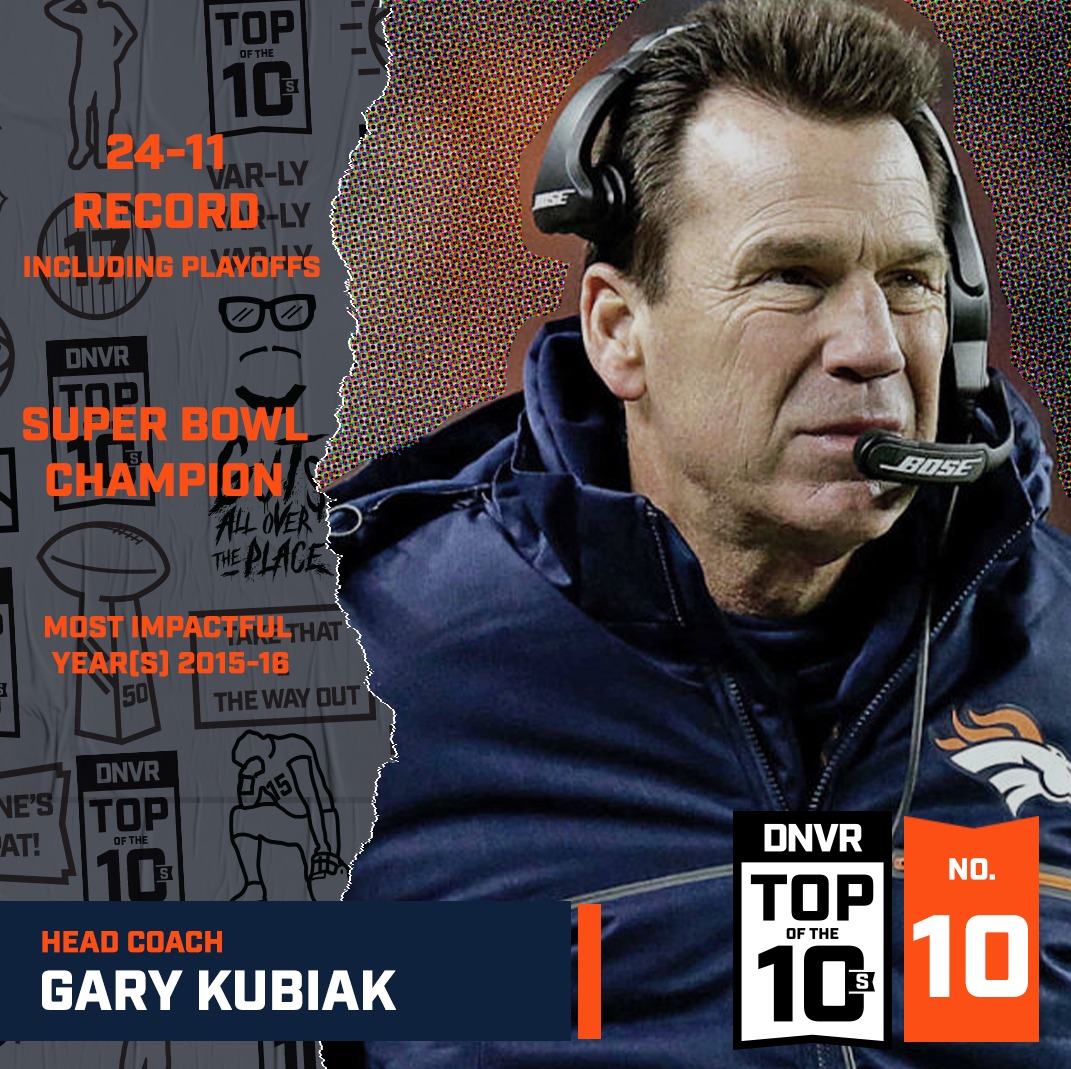
Andrew Mason: Most NFL coaching tenures can be a success without winning a Super Bowl, because with few exceptions, a new head coach arrives to fix a team that is broken in many areas. John Fox, Kubiak’s predecessor, inherited a team that had not made the postseason in five years; even though the Broncos failed to win Super Bowl XLVIII, his four-year tenure was still a resounding success given the core he was handed.
The Broncos’ former backup quarterback and offensive coordinator didn’t have that luxury. He took over the team that had acquired Peyton Manning under Fox’s watch, a club that was a powerhouse, having won 40 games in the previous three seasons. Only winning the franchise’s third Super Bowl would suffice, and with age catching up to the 39-year-old Manning, time was running out.
Kubiak tweaked the offense, installing some of his time-tested concepts while retaining some shotgun and spread aspects of the scheme Manning favored. To say there were bumps was an understatement; at times in 2015 the Broncos offense resembled a battered Jeep that had just traversed a war zone. But Kubiak had also hired Wade Phillips as his defensive coordinator and turned him loose, and by midseason it was apparent that the strengths and success equation had effectively moved 180 degrees from where they were just two seasons earlier.
He navigated Manning’s injury and the week-to-week updates regarding Brock Osweiler with aplomb. Instead of letting questions about the starting assignment linger, he declared Osweiler the starter on Monday for several weeks in succession, preventing the quarterback quandary from morphing into a distraction. Then in Week 17, with the offense mired in a turnover-fueled rut and the Broncos trailing the Chargers, Kubiak sent Manning back into the game, awakening the Broncos in time to save the game and make their postseason run.
Kubiak seemed to punch every button perfectly to maximize what Manning had left by the end of his career, and the Super Bowl 50 triumph ensured that the only goal in front of Kubiak was accomplished.
Still, Kubiak seemed poised for what lay ahead, and the Broncos’ last three seasons might have been far different if Kubiak had not been hospitalized after a 2016 loss to Atlanta with a complex-migraine condition. That came three years after he suffered a mini-stroke while coaching the Texans, and the combination of the two incidents was enough to drive him from the head-coaching role after the season. Still, he wasn’t done with the Broncos, and his heavy involvement in the 2018 draft class helped lead to one of the most fruitful Broncos rookie crops in recent memory. A potential return to the sidelines in a coordinator’s role vanished when he and Vic Fangio could not agree on all terms. So Kubiak walked down the road, headed to Minnesota to continue guiding an offense his way, with his long-time assistants Rick Dennison and Brian Pariani in tow.
Kubiak would not have been the right coach for the Broncos when Manning arrived. He might not be the right coach for them today. But he was the right man at the right moment in 2015, and the Broncos wouldn’t have their third Lombardi Trophy without him.
9. Joe Sakic
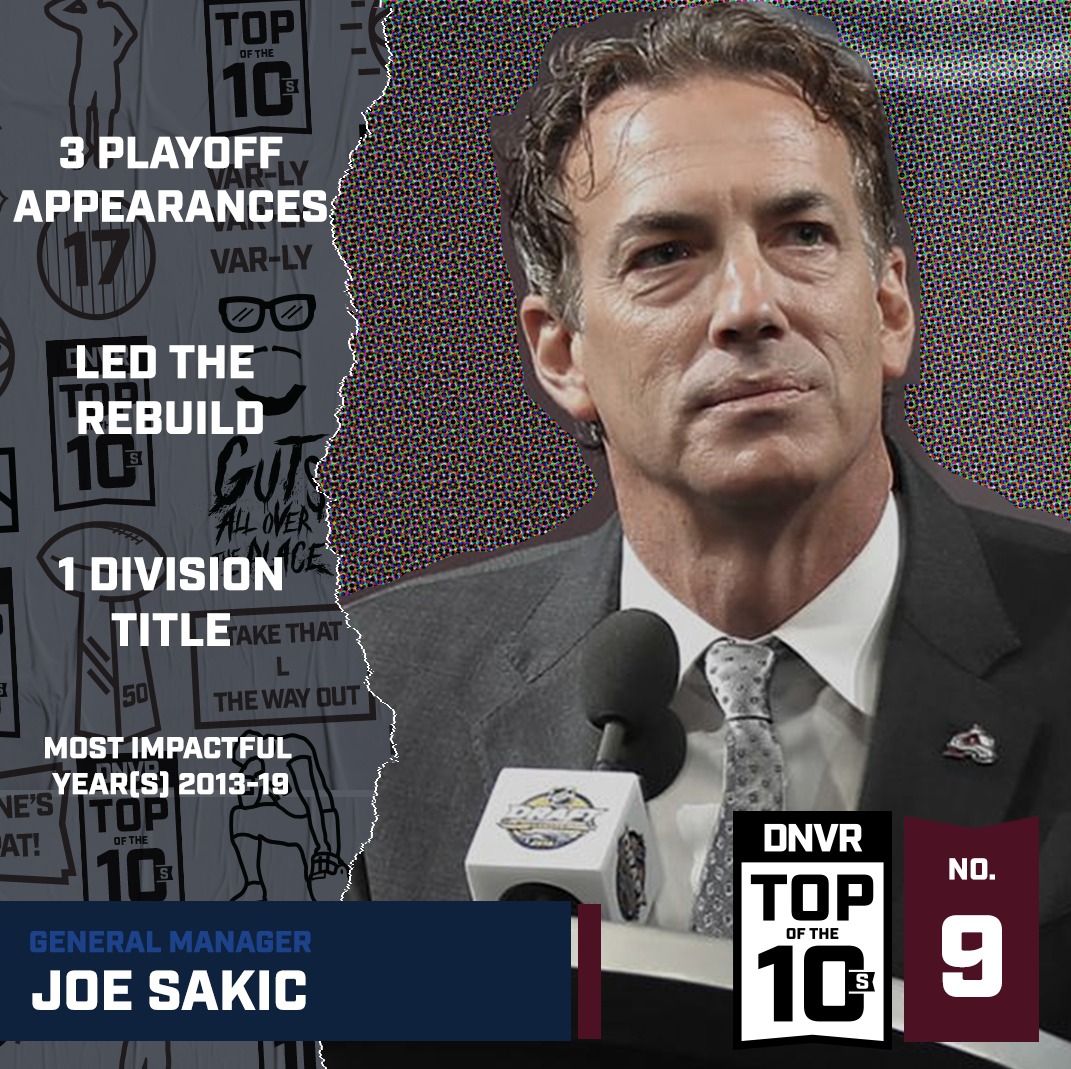
AJ Haefele: Things were…complicated early in Sakic’s tenure. He took over alongside Patrick Roy and the first thing he did was sign…Patrick Bordeleau. Let’s just say a lot has changed. There were trades for Brad Stuart and Reto Berra. There were free agent contracts for Francois Beauchemin and Jarome Iginla. They got older, slower, and more out of touch with the modernization of hockey. The 2013-14 division title won in Sakic and Roy’s first year together was a mirage, a team built on unsustainable percentages and fairy dust.
Then in the summer of 2016, things changed. Roy’s influence seemingly waned, Sakic began asserting a more modern vision of what he wanted his team to be. Build around Nathan MacKinnon and get younger and faster. Results were slow initially, as evidenced by the 48-point team he spent nearly to the cap ceiling building. That team was full of short-term players, however, and gave way to the full-blown youth movement the next season.
2017 was the year it all changed for Colorado. The Avs lost the draft lottery and selected Cale Makar fourth overall and Conor Timmins at the top of the second round. Sakic then made the biggest move of his GM tenure when he traded Matt Duchene. Duchene had requested a trade around Christmas the year before and waited patiently as Sakic got the deal he best felt helped his organization. It was a windfall, landing the Avalanche a package of seven pieces from two teams. The primary pieces turned out to be Sam Girard and Bowen Byram and the organization went from lacking any high-end defensive help to be flush with it.
Combined with the breakouts of MacKinnon and Mikko Rantanen, both of whom were also drafted with Sakic at the helm (and significant input from Roy), the Avalanche are back as the envy of many organizations around the league. They are young, fun, and on the verge of dominance. Sakic is coming off a summer in which everything he did turned out to benefit the Avalanche. He’s simultaneously built one of the NHL’s best teams and prospect pools.
Where I come from, we call that a yahtzee.
8. Chris Harris Jr.
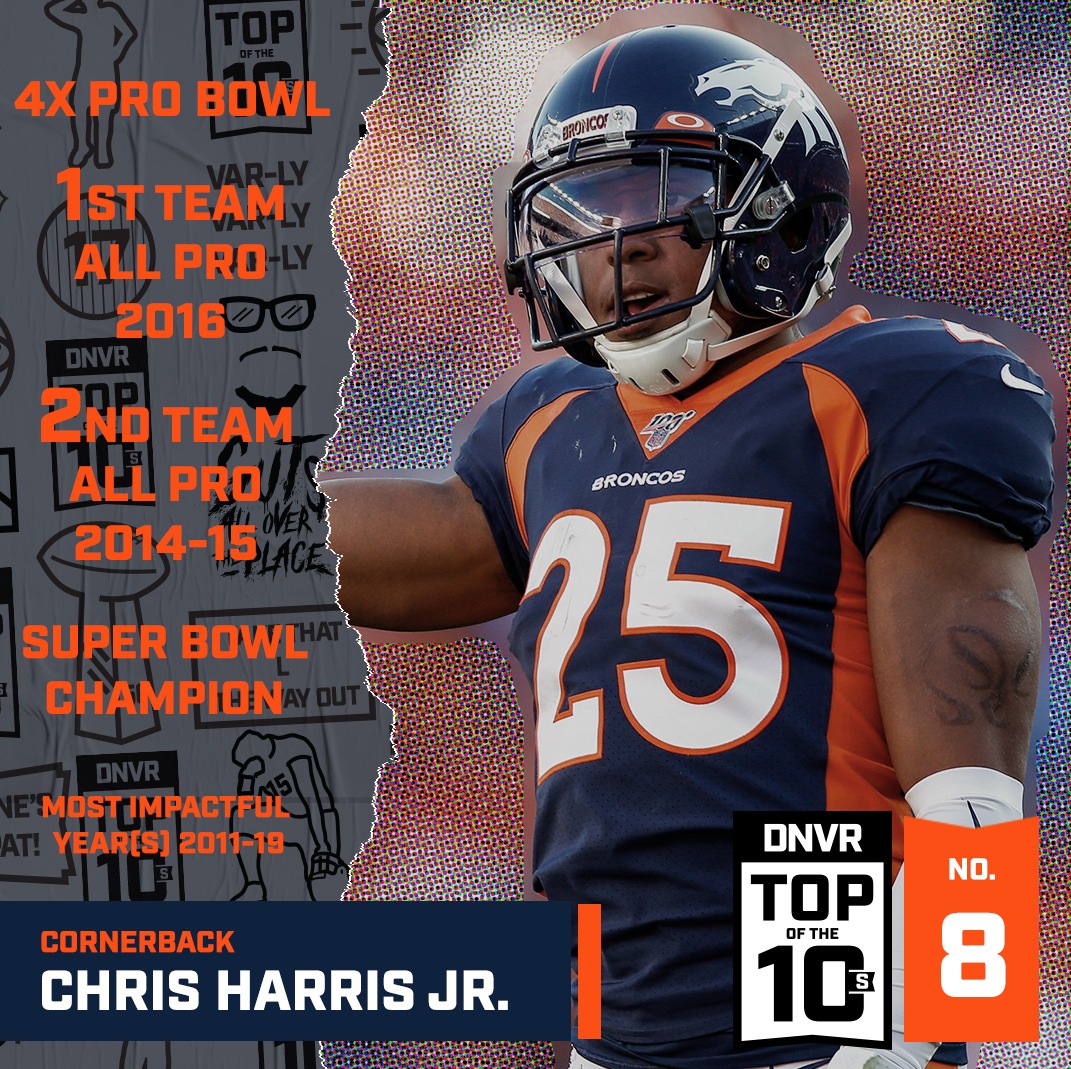
Ryan Koenigsberg: 254.
254 players were taken in the 2011 NFL Draft. Chris Harris Jr., an undersized defensive back out of the University of Kansas, was not one.
After waiting, and waiting, and waiting, he got a call from the Denver Broncos during the “priority” free agent signing period directly after the draft, but “priority” is a strong word here.
When we talk about undrafted free agents, we always say “follow the money” because the players who get the largest signing bonuses usually have the best chance of making the team. Well, of 10 UDFAs signed by the Broncos that year, Harris’ $2,000 bonus was the smallest of the group.
Out of nowhere, though, the kid from Tulsa, Oklahoma made the team and before long, he was on the field. In Week 8, just one week after Tim Tebow made his season debut as the starter, Harris made his first NFL start due to injuries at the position, and he never looked back, making that just one of his now 118 starts in the NFL.
His accolades say he’s a one-time All-Pro, two-time second-team All-Pro and a four-time Pro-Bowler, but anyone who has followed his career in Denver will tell you that his mantle deserves to be a lot more crowded than that.
The true respect for Harris, especially in his prime, came from quarterbacks, who flat out refused to challenge him most of the time, making it hard for him to rack up the interceptions, pass break ups and other stats that lead to those accolades.
But his peers know, just ask A.J. Green, who had this to say in a 2017 Player’s Tribune article titled The 5 Toughest Corners I’ve Ever Faced: “This is the highest compliment I can give a football player — if you look at Chris on film once or twice, you might think, ‘Alright, this guy is a pretty good corner, but what’s the big deal?’ I can tell you from going against him that he’s one of the smartest, quickest corners in the game… Chris stayed very underrated for a long time because his game is so mental. He’s going to get in the film room on Tuesday and by Sunday he knows every little thing you like to do.”
Harris is the unofficial founder of the ‘No Fly Zone,’ a secondary consisting of Harris, Aqib Talib, T.J. Ward, Darian Stewart and Bradley Roby that will go down as one of the best in NFL history, most famously for their efforts in Denver’s 2015 run to the Super Bowl. In the playoffs, the NFZ helped hold the combination of Ben Roethlisberger, Tom Brady and reining-MVP Cam Newton to a total of one touchdown and three interceptions. Not bad, eh?
Harris has been a stalwart in the Denver community and a fantastic representative of the Broncos and the city of Denver. He’ll be a Ring of Famer before long and will deserve strong consideration for the Hall of Fame after that.
Not bad for an undrafted kid, huh?
7. Carlos Gonzalez
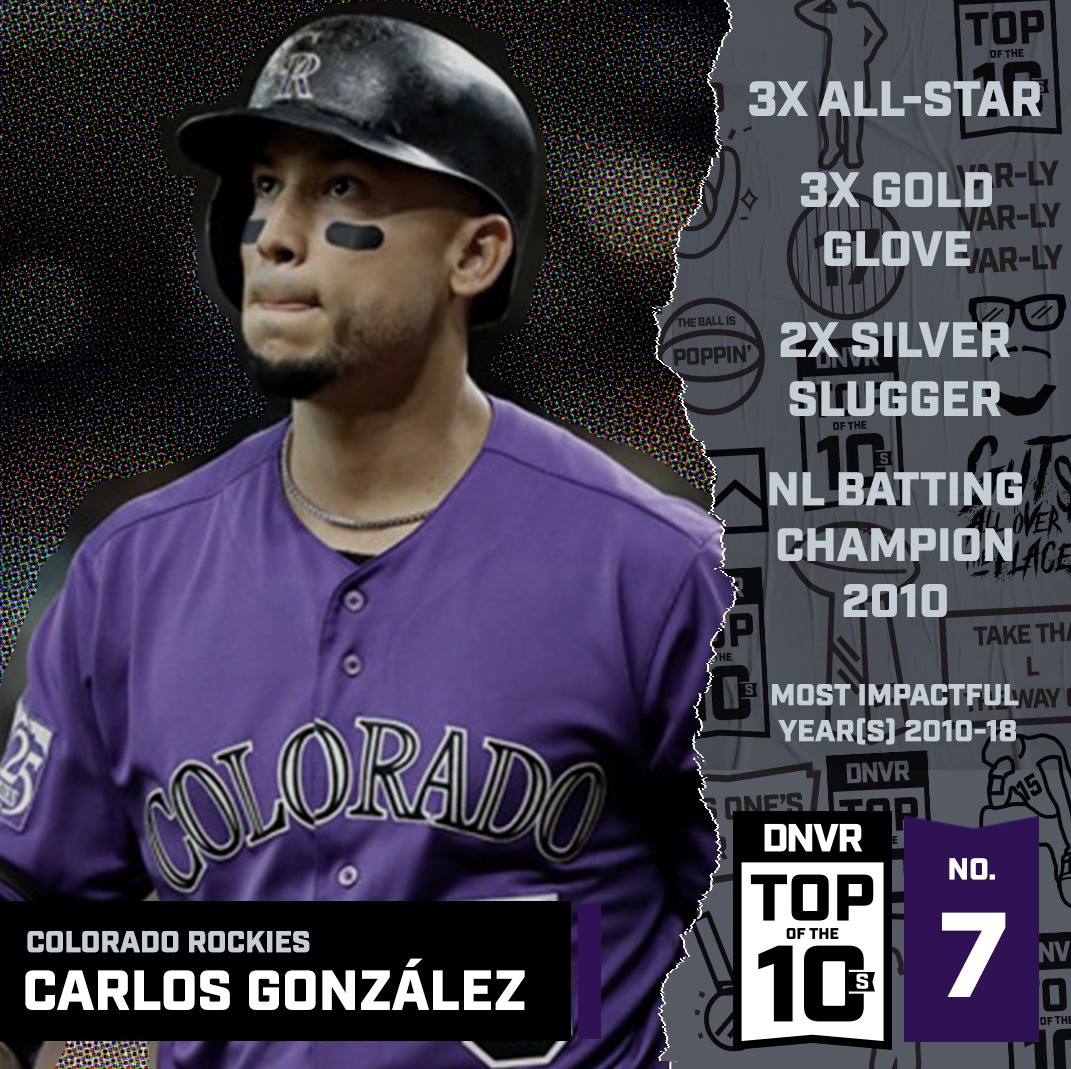
Drew Creasman: Because we are limiting this conversation to this decade, we cannot give Carlos Gonzalez credit for bursting onto the scene in 2009 and stealing the show in the NLDS as a rookie with a sweet swing and smooth smile. But we sure as hell can bask in his greatness displayed over the next nine years in Colorado. His best season came in 2010, when he led the National League in hits, batting average, and total bases, finishing third in MVP voting. He would never quite reach those heights again quickly became an indispensable Rockie.
He is now second only to Todd Helton in games played in purple with 1,247. He’s second in plate appearances, and third in runs scored, hits, total bases, and doubles behind Helton and Larry Walker. He is also fourth in the franchize in stolen bases and home runs.
At his best, he could do it all on the baseball diamond. He skated around the bases and outfield with ease, unleashed cannon fire from a left arm you had to see to believe, and regularly put on a fireworks display at the plate. He was as electric as anyone in the game, it was like he lived to bring a crowd to their feet.
And he was loved. By teammates and coaches and fans. Even by opponents and the press. CarGo treated everyone with respect, was gracious with his time and energy, and never hesitated to give back to the community. Injuries stole away what might have been an even more stellar career.
But he meant so much more to this city than his still-impressive numbers. He bridged the gap between two eras of Rockies’ baseball, oftentimes serving as the best reason to be a fan in the down years. His importance to the hispanic community here is immeasurable. His impact on the organization innumerable. His ability to make every room he walked into just a little bit better of a place to be is a lesson we should all take with us.
Carlos Gonzalez in a Colorado Rockies uniform was a constant reminder to everyone what sports are really supposed to be about: fun.
6. John Elway
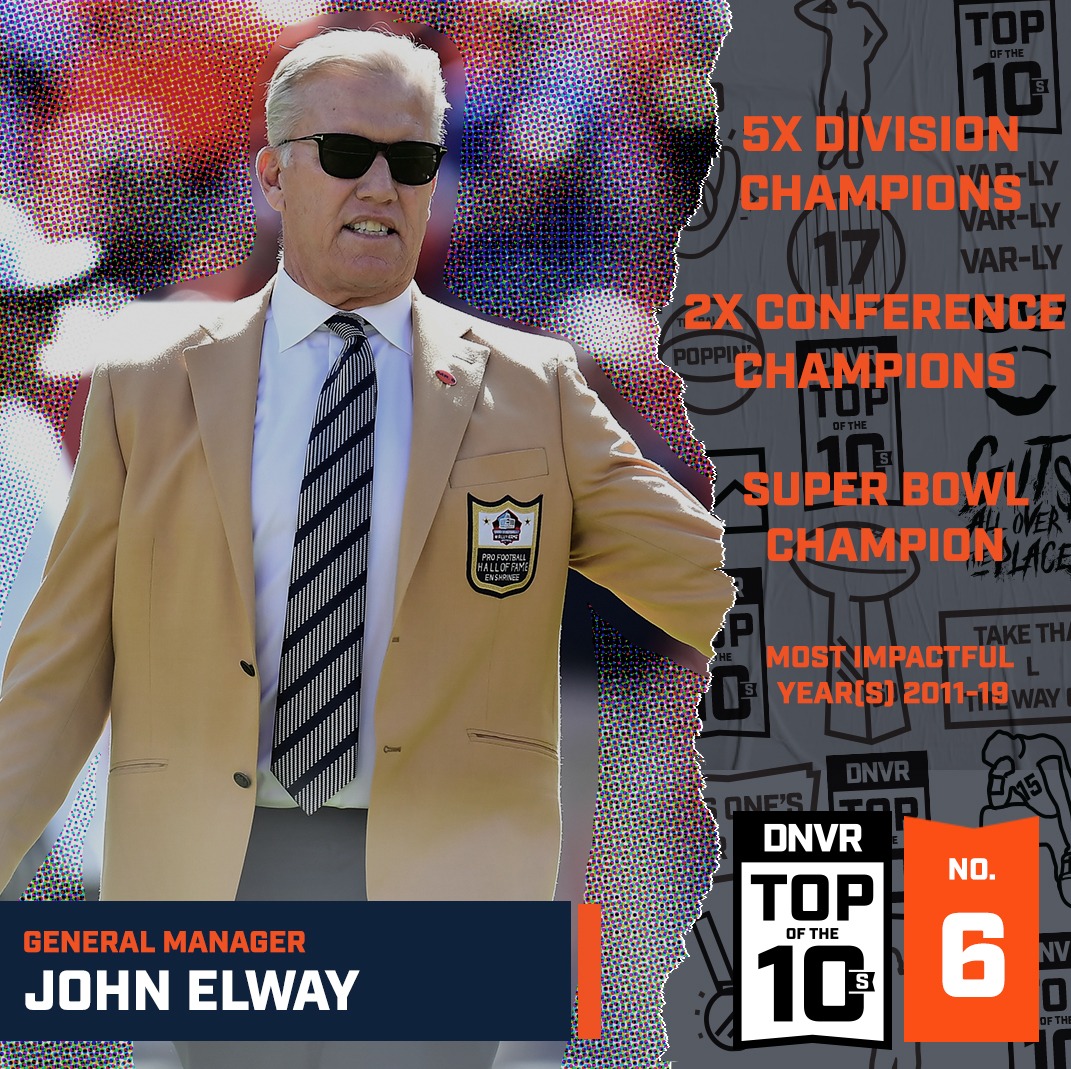
Andrew Mason: When Elway returned to the Broncos in January 2011, the team had gone four years without a winning season, five years without a playoff appearance and had just concluded its worst season in 43 years. It had been dealt a black eye with the “Spygate II” incident involving the illicit videotaping of a 49ers walk-through practice at Wembley Stadium a day before the Broncos played them. Years of poor drafting had left the roster in disrepair.
There was nowhere to go but up.
But Elway didn’t step into his new gig blind. He had a taste of football management in six seasons running the Arena Football League’s Colorado Crush, which folded when that league went on hiatus after the 2008 season. One year ended in a championship, but the defining year of Elway’s Arenaball days was a 2-14 season in its inaugural campaign. After the disastrous season, he fired coach Bob Beers, a longtime family friend of the Elways and a former Broncos scout who had been around for the Super Bowl years of the 1990s.
One season after Elway made that difficult call, the Crush was 11-5. Two years later, he held aloft the Arena League’s bulky Stanley Cup ripoff trophy. And in all that, Elway learned a lesson: If something isn’t working, you cannot be tied down by emotional connections or past successes together.
So after the 2011 season, when much of Broncos Country clamored for Tim Tebow to remain the quarterback, Elway was already poised to go in another direction, believing that Tebow’s ceiling had already been reached. That led to a pursuit of Peyton Manning, which led to a contract and Elway declaring at the introductory press conference that there “is no Plan B” in case Manning’s surgically-repaired neck didn’t hold up.
Just shy of three years later, Manning was still the quarterback, but the Broncos’ pursuit of a Lombardi Trophy had stalled. John Fox, the first hire of Elway’s era, had guided the Broncos to four consecutive division titles. But his teams had lost in the divisional round in three of those years, and by mutual decision, Fox headed for the door, to be replaced by Elway’s rookie roommate, Gary Kubiak.
Just as Fox was the right man for his moment to guide Elway’s team out of a tailspin, so was Kubiak, and in February 2016, Elway was atop the football world. His five seasons to that point had resulted in five division titles, two conference championships, one Super Bowl win and a horde of free-agent successes.
But by that point, Elway’s early success in the draft had begun to fade. Manning retired, the Broncos couldn’t afford to squeeze two key players from the 2012 draft class in for second contracts (Malik Jackson and Danny Trevathan), and then he drafted Paxton Lynch as a long-term replacement for Manning. Lynch was the wrong guy in every way, shape and form.
As with other moves, Elway didn’t wait a while before jettisoning Lynch; he cut him after two seasons and a third training camp — an absurdly short stint for a first-round pick. But the continued futile pursuit of a quarterback, a swing and a miss on Kubiak’s replacement, Vance Joseph and a series of underachieving draft classes led to diminishing returns and an 11-21 record in the 2017 and 2018 seasons, years in which the Broncos saw many negative occurrences that had not transpired since the 1960s.
As the losses mounted, Elway felt genuine, sustained heat from corners of the Broncos’ fanbase for the first time in his charmed football life.
But as the decade ends, the trends are looking up. The 2018 draft class looks like the Broncos’ best since 2011. Vic Fangio appears more in control of the team than Joseph ever did. And most of all, Elway’s calculated gamble that the Broncos could move down in the 2019 draft, address needs at tight end and guard and still land a potential franchise quarterback in Drew Lock could be poised to pay massive dividends.
Elway’s legacy is secure.
But the final chapter now appears wedded to the play of Lock. If the second-round pick is the Broncos’ long-term answer at quarterback, Elway will have a legacy that may go well beyond his tenure as general manager — and he might find himself on the top ten of this list for the 2020s.
5. Nikola Jokic
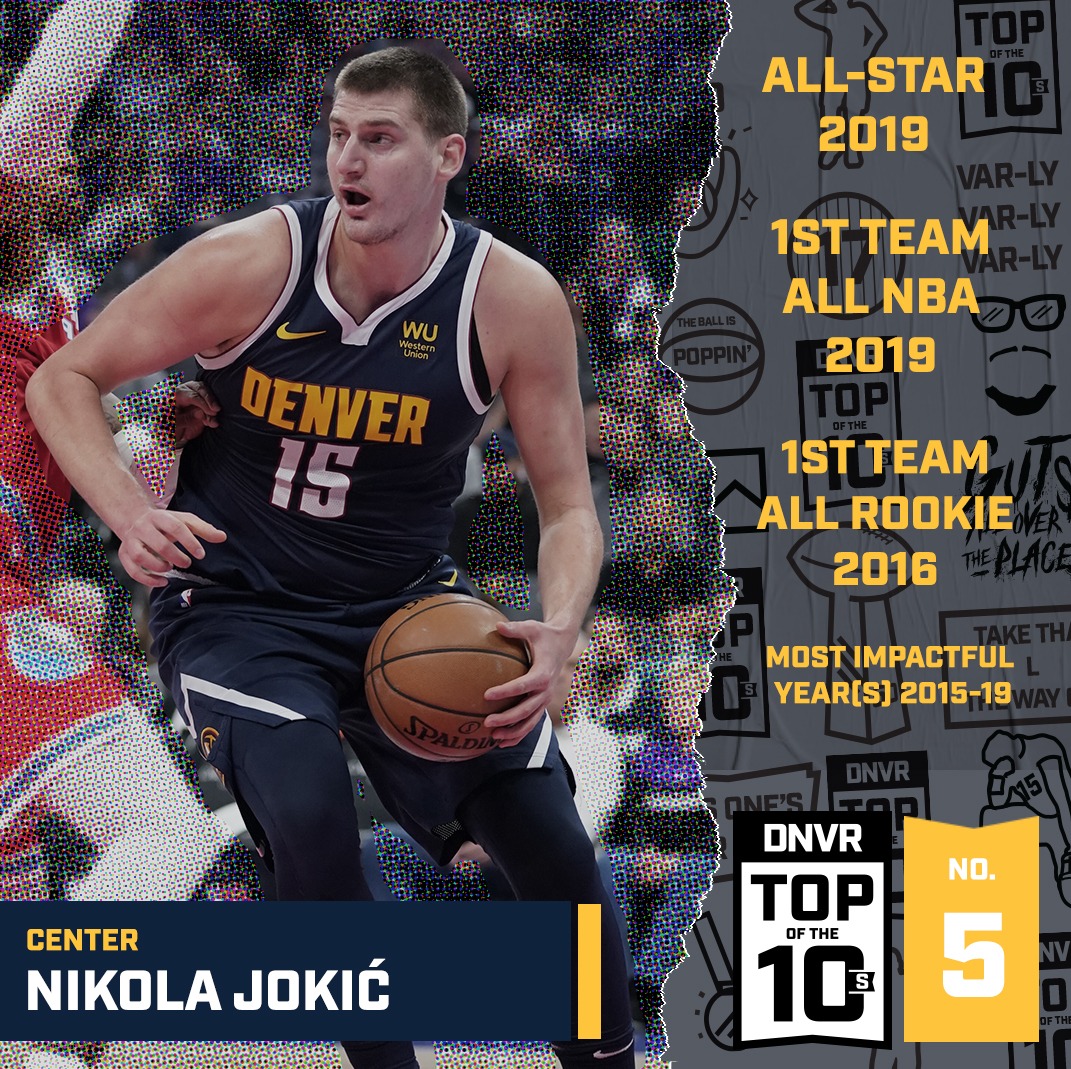
Adam Mares: Everything about Nikola Jokic is unconventional, including his path to the NBA. Back in the early part of the decade, Misko Raznatovic, one of the most prominent basketball agents in Europe, plucked the overweight and unknown 17-year old from a low-level club in Vojvodina, Serbian’s northernmost province, and placed him onto a team that he owned and managed, Mega Vizura.
Originally, Jokic was meant to join the team as a long-term project but just three days into his training, Dejan Milojevic, the team’s coach, told Misko that Jokic would not only be a starter soon but that he might actually become the team’s best player. But first, the club had to whip him into shape. Jokic was overweight and reportedly couldn’t even do a single pushup. So for the next month, Jokic was separated from the rest of the club and put into a sort of boot camp before rejoining the team.
Over the next year, Jokic did in fact become the team’s best player, but Misko soon realized that building a team around Jokic was a unique experience. Unlike most players who get an opportunity to play professionally, Jokic didn’t “want to be concerned with basketball” some days and would go through lulls where he’d temporarily lose motivation to train. There was also the issue that Jokic played the center position unlike anyone else in the history of basketball. He was a center, but he was also a point guard. He moved slower than anyone else in the Adriatic league but his brain was always working faster. On the court he had a maturity beyond his years. Off of it, he could be quite childish.
In his final year with the team, just three years removed from being plucked from obscurity, Jokic earned the Adriatic League MVP award.
In many ways, his road from obscurity to superstardom in Serbia was a preview of things to come in the NBA. Jokic was taken by the Nuggets with the 41st pick in the 2014 NBA draft. At the team’s post-draft press conference, not a single question was asked about Jokic. When he arrived in Denver a year later, he was met with absolutely no fanfare. But as was the case with Mega Vizura, Jokic’s talent would soon become impossible to overlook.
Just 12 games into his rookie season, Jokic dropped 23 points and 12 rebounds on Tim Duncan and the San Antonio Spurs. A day later, he got his first start. Things really took off for the Denver Nuggets on December 15th of his sophomore season, when Michael Malone moved Jokic into the starting lineup for good. The move was a symbolic one: the Nuggets had found their foundational piece. From that moment on, the Nuggets have a 145-98 record and have improved their win total by an average of 7 games per season.
Jokic has wowed along the way. He’s climbed to 11th on the all-time triple-double list, recording the fastest triple-double in NBA history, and tallied the only 35-point triple-double without a single missed shot since Wilt Chamberlain did it in 1967. He became only the 2nd Nuggets player ever to earn first team all-nba honors. In his first foray into the playoffs, he averaged over 25 points, 13 rebounds, and 8 assists, joining Oscar Robertson as the only player in the league’s 73-year history to reach each of those statistical marks in a playoff run.
Jokic’s game is as unique and enigmatic as his personality. He can be unselfish to a fault. He is prone to emotional slumps where his effort level drops, sometimes for several games at a time. And he often gives just enough effort to get the job done. Combine that with his flabby body and carefree personality and it is easy to see why he is far less valued by casual fans and pundits than he is by scouts, opponents, and general managers (who voted him the best center in the NBA last season).
But make no mistake, Jokic is as gifted a player that has come through the Mile High City. He’s been one of the most clutch players in the NBA since the start of the 2018-19 season, where he hit a league best four game-winners and six go-ahead buckets in the final 40 seconds of close games. He’s on pace to surpass those numbers this season despite starting off the season in a bit of a slump.
The Nuggets had been searching for their cornerstone piece since Carmelo Anthony left in 2011. They found one in Jokic, and he has helped usher in one of the most optimistic eras of Nuggets basketball in the team’s 53 year history. He’s not perfect and his growth as a leader and player will determine whether or not the Nuggets should be taken seriously as title contenders at any point in the 2020s.
But at 24 years old, he’s worth the faith that the city of Denver has placed in him.
4. Nathan MacKinnon
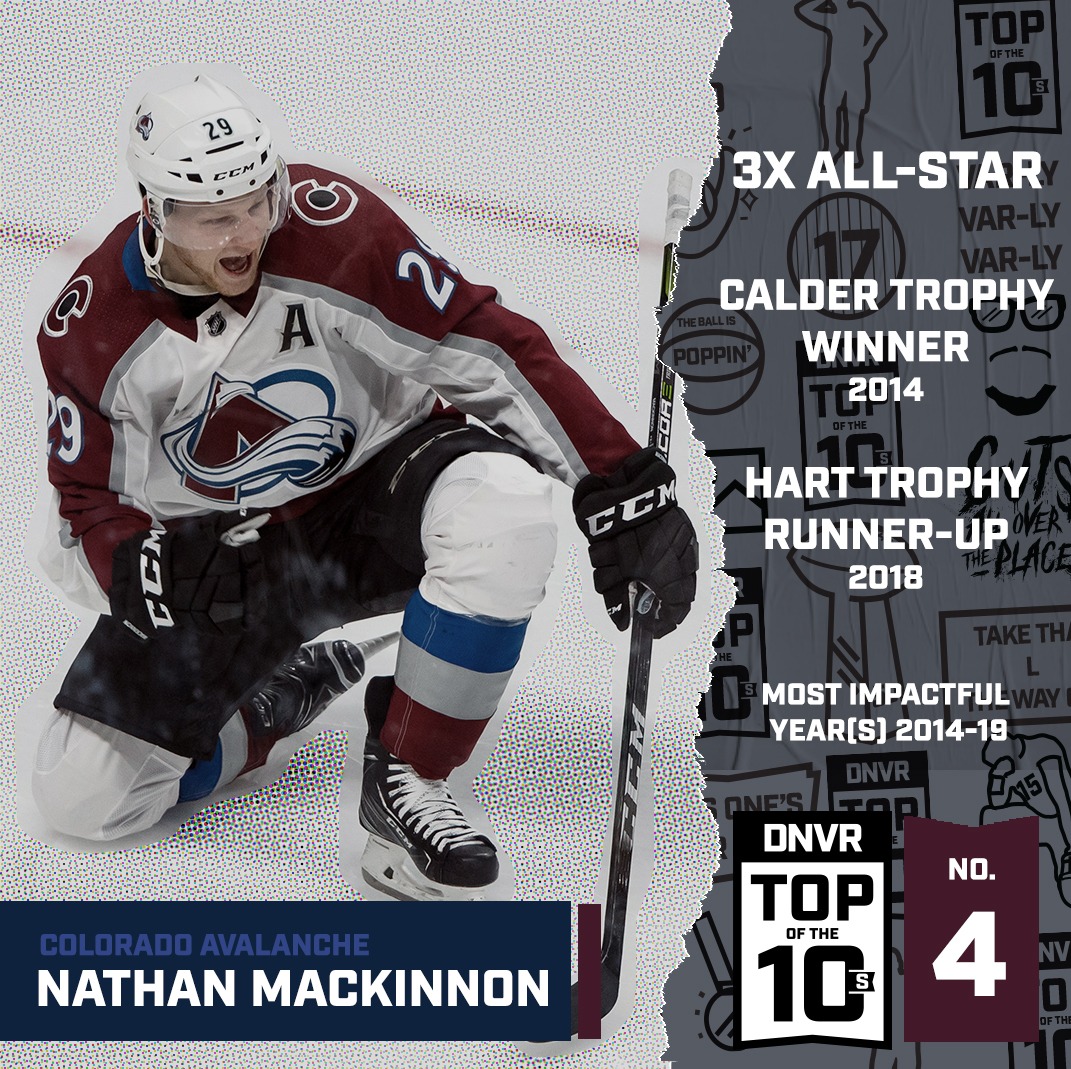
AJ Haefele: Not all drafts are created equally. Sometimes a team gets a first overall selection and the player is expected to change the franchise but falls significantly short through no fault of his own. Other times, the top of the draft is loaded with franchise-changing players and a team has to figure out which one is best for them.
This was Colorado’s challenge in 2013 when they won the lottery and jumped from the second pick to the first pick. Staring down a draft class with three frontline forwards and a franchise defenseman who happened to be from Denver (Seth Jones), the Avalanche leaned on newly-hired Patrick Roy and his experience coaching in the QMJHL. Roy insisted on selecting Nathan MacKinnon first overall and back then Roy was in the business of getting what he wanted.
MacKinnon’s rookie year was the memorable 2013-14 season where everything went right for the Colorado Avalanche. They won their only division title of the decade and MacKinnon was the runaway winner of the Calder Trophy, given annually to the league’s best rookie, as he received 130 of 137 first-place votes. It was just the beginning, right?
An injury-marred sophomore season gave way to disappointing years three and four. Would MacKinnon ever breakout? Colorado had signed him to a contract that was perfectly in line with his career production and market to that point. Through the first ten games of his fifth season, MacKinnon had just five points. He was once again on his way to a 50-point season. Avalanche fans grew restless.
Then, in game 11 of the 17-18 season, the switch flipped. MacKinnon had two goals and an assist that night and hasn’t looked back since. Before that breakout game (against Chicago, no less), MacKinnon had scored 211 points in 310 career games, or a .68 PPG pace. Since then, he has scored 238 points in 176 games, good for a 1.35 PPG pace. For historical context, averaging 1.35 PPG across a career would be good for fourth-highest…ever.
MacKinnon finished second in Hart Trophy (MVP) voting and has led the Avalanche to consecutive playoff appearances for the first time since Joe Sakic was still a player. He is among the league leaders in scoring today and is inarguably one of the most dominant players in the sport. He currently sits on a Hall of Fame track and the Avalanche are prime candidates to bring home serious hardware during MacKinnon’s prime over the next several years. While the players ahead of MacKinnon on this list have all had great accomplishments, MacKinnon is the one set up to dominate the next decade and become the face of Colorado sports.
3. Nolan Arenado
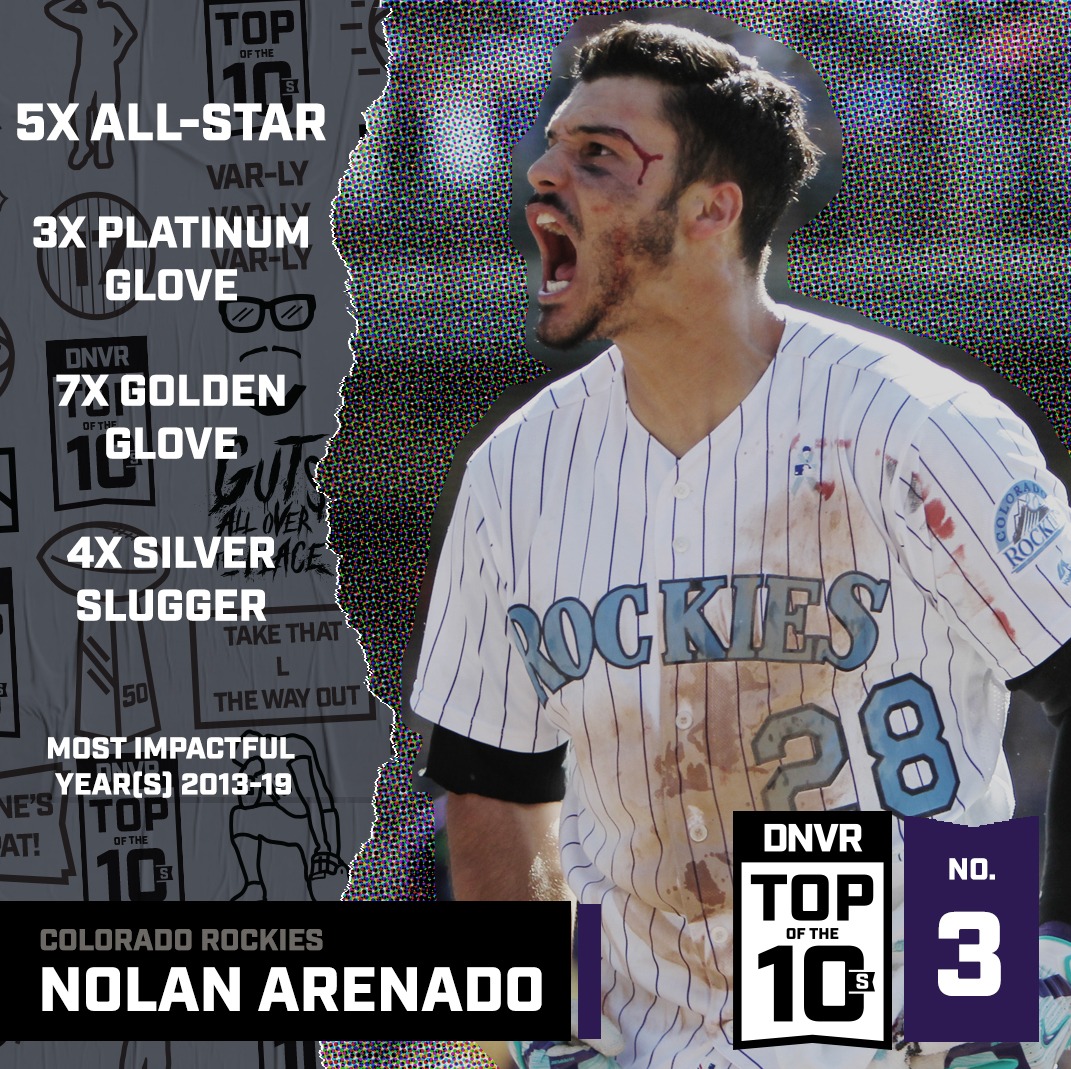
Drew Creasman: If you could gather every single person who has ever played a single inning of Major League Baseball, going back to 1869, and put them in one place, they would fit comfortably into but pack a 20,000 seat stadium. The Hall-of-Fame players – all 233 of them – wouldn’t even take up an entire section. Taking up half of one row up at the front, nine seats could be reserved for the best players to have ever played their specific position.
And there is a more than decent chance that one of those seats has Nolan Arenado’s name on it.
Yes, he is on pace to be the greatest third baseman in the history of the game and there are those, including a few other candidates for that title, who think he is just about already there. Both Brooks Robinson and Mike Schmidt have said that Arenado is the best defender to ever pick it at the hot corner and his 7-of-7 Gold Gloves tend to agree.
As much as maybe any player in pro sports, his statistics sell him short. That’s not to say his perennial production of 120+ RBI and 40 home runs and career .295/.351/.546 slashline isn’’t obviously impressive, it just barely begins to scratch the surface. Oddly enough, he is even sold a bit short by MVP voting, despite the fact that he has finished no lower than eighth for the award in the last five years, topping out at third in 2018. If he played in almost any other market, he would have at least one of those things on the mantle by now.
The only thing missing from his resume is an abundance of team success. Well, and he doesn’t exactly speed around the bases. But that’s literally it.
For six years running, he has been the best clutch hitter in baseball, consistently putting up his best numbers in the highest leverage situations. Since he first stepped onto an MLB diamond, he has been one of a handful of players who can truly be considered the absolute best defender in the game each and every season. He has consistently stood as one of the scariest people to pitch to in the world.
His highlight reel has forced us to invent a new meter for measuring spectacular plays. His ability to come through when it matters the most has become legendary and almost laughably expected. That’s why it was simultaneously shocking and not-at-all surprising when he walked off on the Giants on Father’s Day, 2017, completing the cycle.
The odds that he could not only accomplish such a feat, but that the stars would even align to give him the chance, were next to impossible. So why did so many of us feel in our guts that him driving the ball over the fence was somehow inevitable?
Because Nolan Arenado has made the impossible… routine.
2. Von Miller
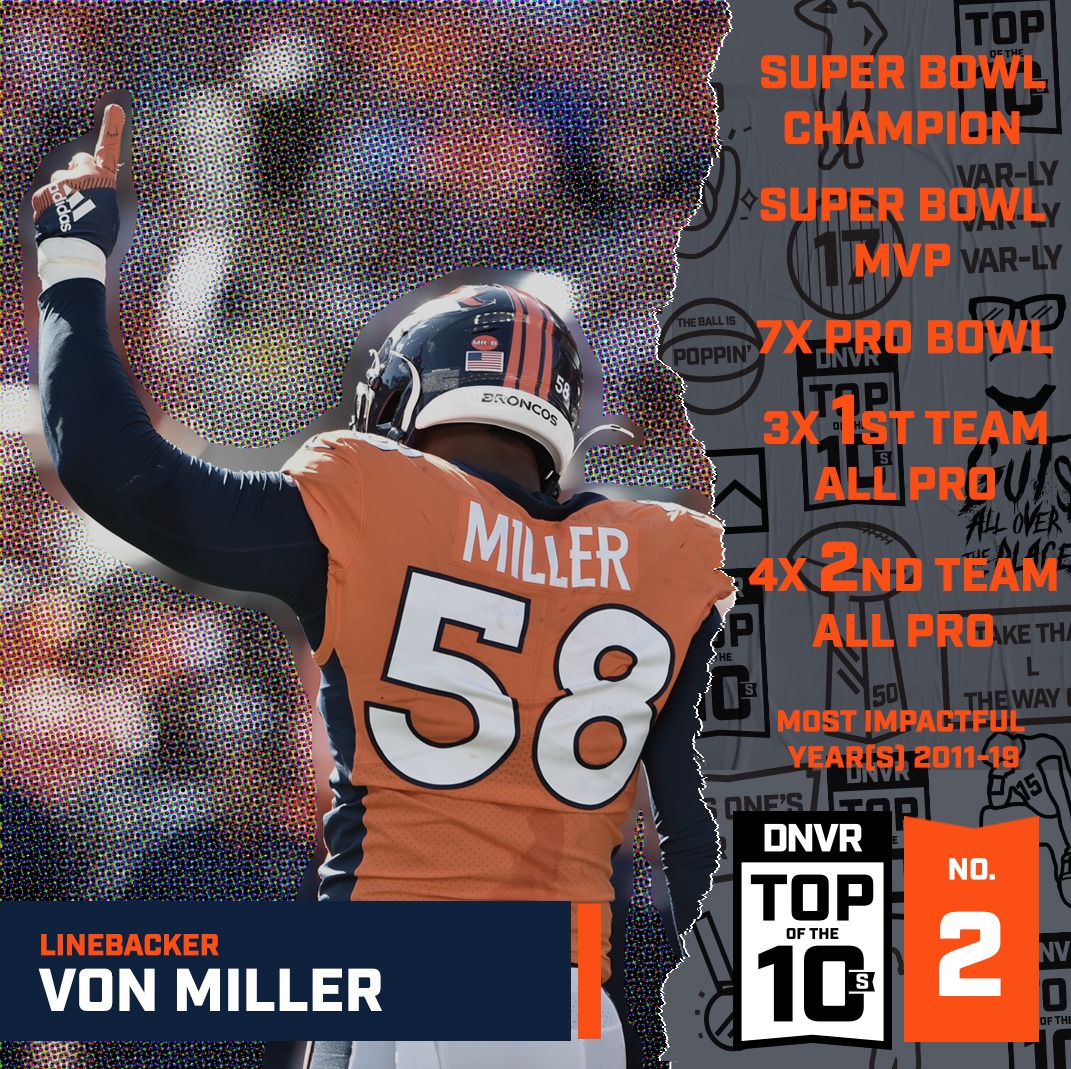
Zac Stevens: Super Bowl 50 MVP. Need we say more?
Well, yes, because not only is Von Miller the most responsible person for Colorado’s only championship of the decade, as his MVP would indicate, he’s on his way to being a first-ballot Hall of Famer—a feat only John Elway and Champ Bailey have accomplished in Orange & Blue.
It all began in 2011, when Elway used his first-ever draft pick as a Broncos executive to select the generational pass rusher No. 2 overall.
Since, Vonnie B’Vsean Miller Jr.’s lived up to the hype so much so, he’s simply recognized around the country as Von.
It took precisely no time for Von to find his way in the NFL, making the Pro Bowl his rookie season. His second season, however, he became the superstar he is as he racked up a career-best 18.5 sacks, which was third-most in the league.
But Von saved his best of the decade for the most important stretch in all of Denver sports in the 10-year period. The Broncos’ Super Bowl 50 run might as well be known as the time Von Miller ruined quarterback’s lives.
In the AFC Championship game, Von made Tom Brady’s life a living nightmare—leading Denver’s pass rush to hitting the Hall of Fame quarterback more times than he had ever been hit before. His 2.5 sacks in the Broncos’ win jump off the stat sheet, but his deceptive interception off Brady was a heat check Von turned into fire.
The next game, Super Bowl 50, Von ruined then-MVP Cam Newton’s life. Every time the No. 1 overall pick in 2011 dropped back, the No. 2 overall pick in the same draft was all over him. Not only did Miller rack up 2.5 sacks, he forced two fumbles, one of which Malik Jackson fell on for a touchdown.
Since that day, coupled with Peyton Manning hanging ‘em up after the season, No. 58’s honorably been the face of the franchise, a task quarterbacks typically take. He’s not only been the go-to jersey for fans and the face the cameras gravitate to, but he’s also been a tremendous role model off the field.
From creating Von’s Vision—to provide eye care for low-income students—to championing the Broncos’ organization to donate $200,000 to Shield616 to protect first responders, Von’s created a blueprint on how to be elite off the field, too.
Additionally, he’s danced with the stars and signed the largest contract for a defensive player in NFL history. All in a decades worth of time.
As the next decade approaches, Von has his sights set on climbing the all-time sack leaderboard, where he currently sits in the top 30 with over 100 career sacks. Whatever he does in the 2020’s will simply be a cherry on top after dominating the 2010’s in every single fashion.
And if Von’s game would suggest anything, it’s that the closer is saving his best for last. So don’t close the book on No. 58 just yet.
1. Peyton Manning
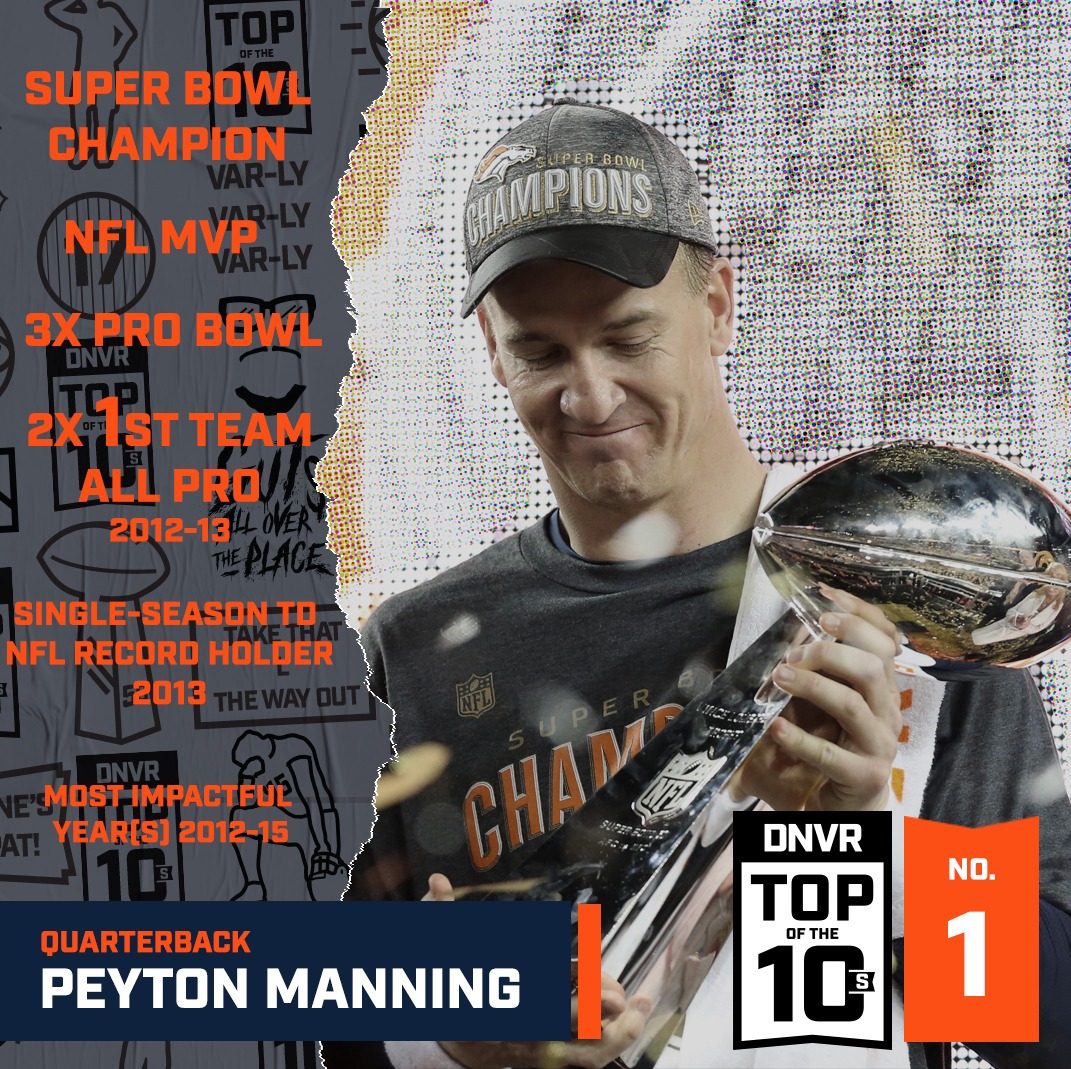
Andrew Mason: In The Last Tycoon, F. Scott Fitzgerald wrote, “There are no second acts in American lives.”
Fitzgerald never met Peyton Manning.
If he had, he would have rethought those words once he was confronted with Manning’s meticulous mind, diligence to his work and preternatural feel for the game he played.
The most significant free-agent acquisition in NFL history not only matched his excellence during 14 seasons with the Indianapolis Colts, he surpassed it. He did so without having feeling in the fingertips of his throwing hand, a lingering effect of the neck injury and four surgeries he underwent during and around the 2011 season, which he missed altogether, dooming the Colts to a 2-14 finish.
In many years, Manning would have returned to his longtime team in 2012, fresh and ready to go. But this was the year of Andrew Luck, a surefire No. 1 overall pick, and the Colts chose to cast their lot with someone they felt could be the next Manning.
Denver pounced at the opportunity, but did so with slight trepidation. The Broncos gave him a contract worth up to $90 million over five years, but Manning had to pass a physical each year to ensure he’d see another year of the deal. It was insurance against Manning not recovering his pre-neck-injury form.
It didn’t take long for Manning to realize that Denver was different. At his second practice during organized team activities after joining the Broncos, he found himself answering questions about misfires in practice.
“I’ve never had to comment before on incompletions in practice before, so this is new to me,” Manning wryly noted at the time.
And with that, Manning had his welcome to Denver. It’s not that football didn’t matter in Indianapolis. But with the Broncos and the Mile High City, the slogan of Manning’s beloved Southeastern Conference applies perfectly: It just means more.
Which meant that when Manning led the Broncos back from a 24-0 halftime deficit at San Diego on Monday Night Football in his sixth game as Denver’s starter, he basked in the joy of an entire time zone.
In 2013, Manning posted the finest season by any quarterback in the first 100 seasons of the NFL. Even if Manning had ended his career right then and there after the Super Bowl XLVIII loss to Seattle, Manning’s place in Broncos history would have been secure on that campaign alone, in which he set the NFL’s single-season records for passing yardage (5,477) and touchdown passes (55), guiding the Broncos to an NFL-record 606 points.
But by 2015, injuries and age finally caught up to Manning. He threw more interceptions (17) than touchdowns (9). He missed six games because of plantar fasciitis, which left him unable to establish an adequate base from which to throw.
That season was a campaign unlike any other for Manning — and not just because his production did not match his longtime standards. He had to adjust to Gary Kubiak’s offense, and eventually the Broncos melded the shotgun-centric concepts Manning favored with the under-center alignment of Kubiak’s scheme. Manning took a pay cut on a restructured deal as the Broncos tried to squeeze all of their free-agent signings, a new contract for Demaryius Thomas and August signee Evan Mathis under a salary cap stretched to the maximum.
Manning could earn back the entire amount of the pay cut if the Broncos did one thing: Win Super Bowl 50.
That remained a realistic hope even as Manning watched backup Brock Osweiler start six consecutive games. The Broncos went 4-2 in those contests, and Osweiler was a reason for their success in those games, leading the Broncos back from two-score deficits against division champions New England and Cincinnati.
By Week 17, Manning was healthy enough to be back in uniform. Home-field advantage lay in the balance with the Chargers coming to Denver. But Kubiak opted to start Osweiler. For the first time in 18 NFL seasons, Manning suited up as a reserve.
He stood on the sideline as the Broncos took a quick 7-0 lead on a 72-yard Osweiler-to-Thomas touchdown 31 seconds into the game. He looked on helplessly as five of the Broncos’ next eight possessions ended in giveaways, allowing the 4-11 Chargers to take a 13-7 lead.
With the Broncos staring at their No. 1 playoff seed turning into a No. 5 and a wild-card trip to Houston, Kubiak turned to Manning. Seven weeks earlier, the home crowd booed him, not realizing he was injured, only seeing the 0.0 passer rating he posted in a humiliating 29-13 loss to the Chiefs. Now those jeers were cheers from a crowd desperate for Manning to save the Broncos as he had so many times over the previous four seasons.
He made all the right adjustments, guiding the Broncos on an eight-play, 80-yard sprint to the touchdown that put them back in front. Order was restored, and the Broncos’ march to Super Bowl 50 was on. But the most valuable asset of Manning by this point was his heart and his mind. The two touchdowns in the 20-18 AFC Championship Game win over the Patriots resulted from pre-snap checks that allowed him to set up the mismatch he wanted: New England linebacker Jamie Collins against tight end Owen Daniels.
Manning earned back the pay cut. The Broncos had their first Super Bowl win in 17 years. Manning had his second ring, one for each of his NFL stops. When he retired a month after the Super Bowl win over Carolina, he left behind an organization that had returned to the level to which it had become accustomed in the 1980s and 1990s, and did so with a career resume that puts him on the short list of the game’s all-time greats.
Manning retired. But he never really left.
He still calls Denver home. One of his quarterbacks at the Manning Passing Academy in 2018 was Drew Lock. That summer, Lock was a camp counselor. Now he is the Broncos’ bright hope for the future. When Lock won his first start on Dec. 1, 2019, Manning and his father, Archie, texted their congratulations, and Peyton provided Lock advice prior to the rookie’s second career start seven days later.
Fitzgerald was wrong. Not only did Manning have a second act, but the success of Lock and his willingness to lean on old No. 18 shows that in a small way, there might be a third, as even a small part of helping the Broncos’ putative quarterback of the future.
Nothing would be more apt. Every time it seemed like Manning was out — whether it was four neck surgeries, down 24 points at halftime or on the bench biding his time — he always came back with more than you thought possible, more than even his past greatness would have dictated.
It meant more in Denver. And Manning brought more. He arrived with mile-high expectations and exceeded them.
And all that is why No. 18 is the clear No. 1 for the 2010s in Denver sports.
Comments
Share your thoughts
Join the conversation




